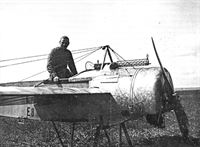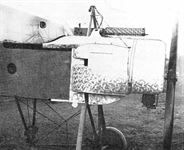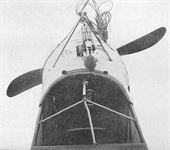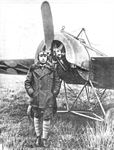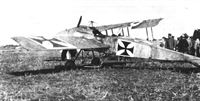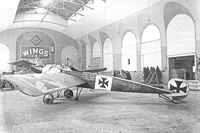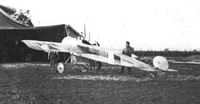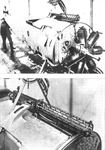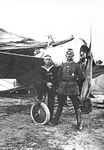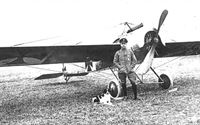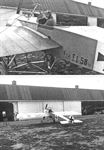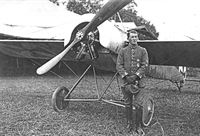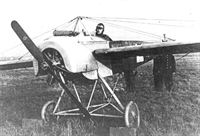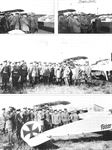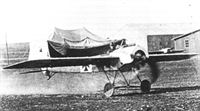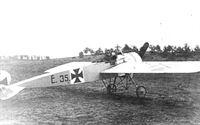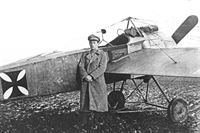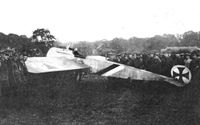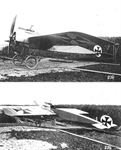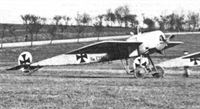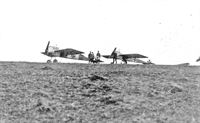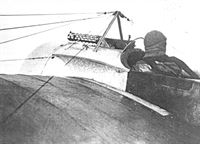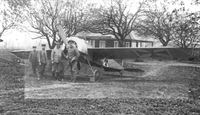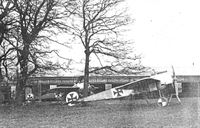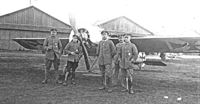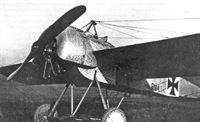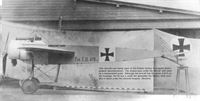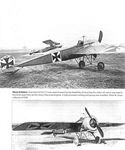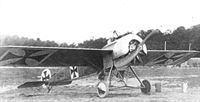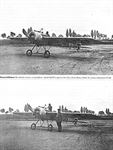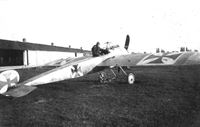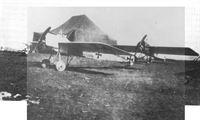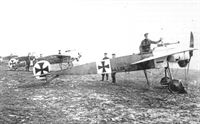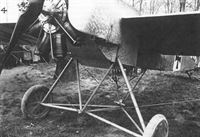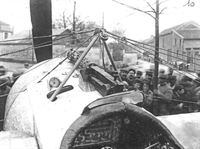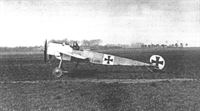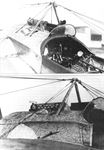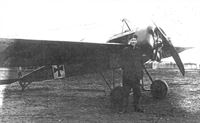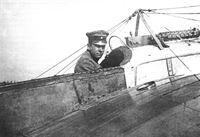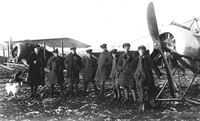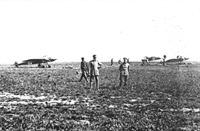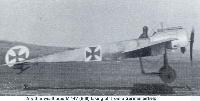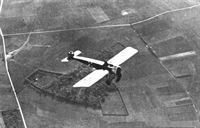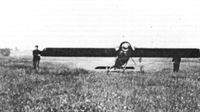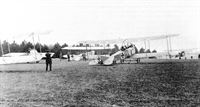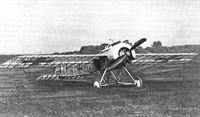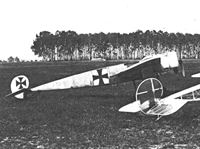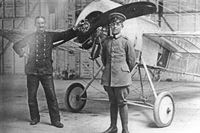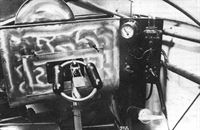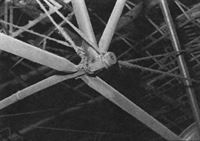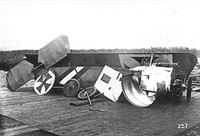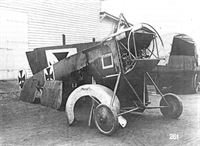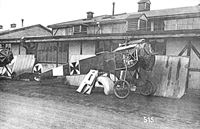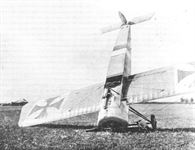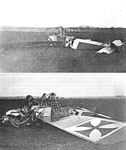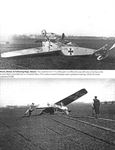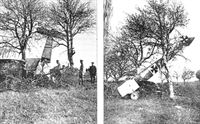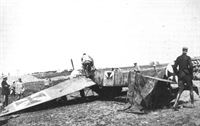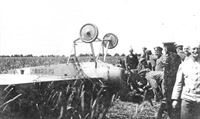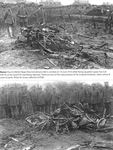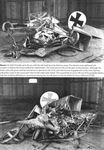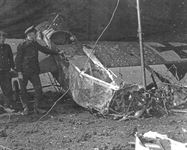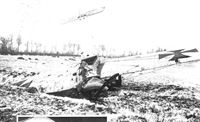
Описание
Страна: Германия
Год: 1914
Истребитель
Варианты
- Fokker - A.I / M.6 / M.8 - 1914 - Германия
- Fokker - A.II / A.III / M.5 - 1914 - Германия
- Fokker - E.I / E.II / E.III / M.14 - 1914 - Германия
- Fokker - E.IV / M.15 - 1915 - Германия
- В.Кондратьев Самолеты первой мировой войны
- A.Weyl Fokker: The Creative Years (Putnam)
- J.Herris, J.Scott Fokker Aircraft of WWI. Vol.2: Eindeckers (A Centennial Perspective on Great War Airplanes 52)
- J.Herris Fokker Aircraft of WWI. Vol.6: Foreign Service (A Centennial Perspective on Great War Airplanes 56)
- O.Thetford, P.Gray German Aircraft of the First World War (Putnam)
- W.Green, G.Swanborough The Complete Book of Fighters
- P.Grosz, G.Haddow, P.Shiemer Austro-Hungarian Army Aircraft of World War One (Flying Machines)
- E.Hauke, W.Schroeder, B.Totschinger Die Flugzeuge der k.u.k. Luftfahrtruppe und Seeflieger 1914-1918
-
J.Herris, J.Scott - Fokker Aircraft of WWI. Vol.2: Eindeckers /Centennial Perspective/ (52)
Fokker A.III 16/15 (w/n 216) Otto Parschau Douai, June 1915
-
В.Кондратьев - Самолеты первой мировой войны
"Фоккер" E.I с пулеметом "Парабеллум", пилот Макс Иммельман, лето 1915г.
-
Сайт - Pilots-and-planes /WWW/
E.I/15 was the first Fokker Eindecker to enter combat. It was flown by both Oswald Boelcke and Max Immelmann.
-
J.Herris, J.Scott - Fokker Aircraft of WWI. Vol.2: Eindeckers /Centennial Perspective/ (52)
Fokker E.I 13/15 Max Immelmann, Albert Osterreicher, Albert Aschmann FFA 62, Fall 1915
-
J.Herris, J.Scott - Fokker Aircraft of WWI. Vol.2: Eindeckers /Centennial Perspective/ (52)
Fokker E.I 14/15 FFA 9b, Fall 1915
-
J.Herris, J.Scott - Fokker Aircraft of WWI. Vol.2: Eindeckers /Centennial Perspective/ (52)
Fokker E.I 29/15 Walter von Bulow-Bothkamp FFA 22, Fall 1915.
-
J.Herris, J.Scott - Fokker Aircraft of WWI. Vol.2: Eindeckers /Centennial Perspective/ (52)
Fokker E.I 45/15 FFA 42 Bathelemont, Fall 1915
-
J.Herris, J.Scott - Fokker Aircraft of WWI. Vol.2: Eindeckers /Centennial Perspective/ (52)
Fokker E.I 45/15 of Feldfliegerabteilung 42,
-
J.Herris, J.Scott - Fokker Aircraft of WWI. Vol.2: Eindeckers /Centennial Perspective/ (52)
Fokker E.I 327/16 Helmuth Leitlof AFP Valenciennes, October 1916
-
J.Herris, J.Scott - Fokker Aircraft of WWI. Vol.2: Eindeckers /Centennial Perspective/ (52)
Fokker E.II 630/16 (Schuleinsitzer) KEA 1, Mannheim, 1916
-
J.Herris, J.Scott - Fokker Aircraft of WWI. Vol.2: Eindeckers /Centennial Perspective/ (52)
Fokker M.14 (w/n 257) Anthony Fokker Stenay, June 1915
-
J.Herris, J.Scott - Fokker Aircraft of WWI. Vol.2: Eindeckers /Centennial Perspective/ (52)
Fokker E.II 18/15. Unit unknown
-
J.Herris, J.Scott - Fokker Aircraft of WWI. Vol.2: Eindeckers /Centennial Perspective/ (52)
Fokker E.II 37/15. Oswald Boelcke & Max Immelmann, FFA 62, Douai, September 1915
-
J.Herris, J.Scott - Fokker Aircraft of WWI. Vol.2: Eindeckers /Centennial Perspective/ (52)
Fokker E.II 41/15 Otto Lehmann FFA 9b, Colmar, October 1915
-
J.Herris, J.Scott - Fokker Aircraft of WWI. Vol.2: Eindeckers /Centennial Perspective/ (52)
Fokker E.II 89/15 FFA 34, Cunei
-
Сайт - Pilots-and-planes /WWW/
A Fokker E.III assigned to Kampf-Einsitzer-Kommando Habsheim during the winter of 1915/16.
-
J.Herris, J.Scott - Fokker Aircraft of WWI. Vol.2: Eindeckers /Centennial Perspective/ (52)
Fokker E.III 105/15 Ernst Udet KEK Habsheim, Spring/Summer 1916
-
Сайт - Pilots-and-planes /WWW/
This German Air Service Fokker E.III (422/15) carried the serial in a non-standard location.
-
J.Herris, J.Scott - Fokker Aircraft of WWI. Vol.2: Eindeckers /Centennial Perspective/ (52)
Fokker E.III 422/15 FFA 34, Cunei, early 1916
-
J.Herris, J.Scott - Fokker Aircraft of WWI. Vol.2: Eindeckers /Centennial Perspective/ (52)
Fokker E.III 422/15 Feldfliegerabteilung 35, Cunei, France early 1916.
-
J.Herris, J.Scott - Fokker Aircraft of WWI. Vol.2: Eindeckers /Centennial Perspective/ (52)
Fokker E.III 429/15 Unit unknown
-
Сайт - Pilots-and-planes /WWW/
This Fokker E.III (210.16) survived the war and is preserved at the Science Museum in London.
-
J.Herris, J.Scott - Fokker Aircraft of WWI. Vol.2: Eindeckers /Centennial Perspective/ (52)
Fokker E.III 245/16 Possibly KEK 3, mid 1916
-
J.Herris, J.Scott - Fokker Aircraft of WWI. Vol.2: Eindeckers /Centennial Perspective/ (52)
Fokker E.III 247/16 Unit unknown, Summer 1916
-
J.Herris - Development of German Warplanes in WWI /Centennial Perspective/ (1)
Fokker E.III flown by Oblt. Hans Berr, August 1916. The E-types were obsolete by this time and German pilots desperately needed the new biplane fighters just starting to arrive. Berr scored 10 victories and was awarded the Pour le Merite. He was killed in action 6 April 1917.
-
Сайт - Pilots-and-planes /WWW/
Fokker E.III (Serial No. Unknown) Due to engine failure, Richthofen crashed and totally destroyed his first E.III at Mont-Murville, late spring 1916.
-
В.Кондратьев - Самолеты первой мировой войны
Фоккер E.III, пилот - фельдфебель Э.Удет, 1915г.
-
J.Herris, J.Scott - Fokker Aircraft of WWI. Vol.2: Eindeckers /Centennial Perspective/ (52)
Fokker E.III LF196 Gotthard Sachsenberg, ii MFFA, mid 1916
-
Сайт - Pilots-and-planes /WWW/
This Fokker E.III was flown by Vizefeldwebel Edward Bohme of the Bavarian Air Force.
-
Сайт - Pilots-and-planes /WWW/
This Austro-Hungarian E.III, 03.43 was armed with a Schwarzlose M 7/12 machine gun during 1916. It was flown by both Flik 8 and 19.
-
P.Grosz, G.Haddow, P.Shiemer - Austro-Hungarian Army Aircraft of World War One /Flying Machines/
Fokker A.III 03.51, Flik 4
-
E.Hauke, W.Schroeder, B.Totschinger - Die Flugzeuge der k.u.k. Luftfahrtruppe und Seeflieger 1914-1918
Fokker E I 03.51 Mathias Bernat Flik 4 Wippach
-
E.Hauke, W.Schroeder, B.Totschinger - Die Flugzeuge der k.u.k. Luftfahrtruppe und Seeflieger 1914-1918
Fokker E I 03.52 Ludwig Hautzmayer Flik 19 Isonzo-Front Februar 1916
-
Сайт - Pilots-and-planes /WWW/
Fokker E.IIIs were also flown by naval units. This aircraft was assigned to the Austro-Hungarian Navy during 1917.
-
J.Herris - Fokker Aircraft of WWI. Vol.6: Foreign Service /Centennial Perspective/ (56)
Fokker A.III serial A6 flown by Gottfried Banfield.
-
E.Hauke, W.Schroeder, B.Totschinger - Die Flugzeuge der k.u.k. Luftfahrtruppe und Seeflieger 1914-1918
Fokker E III A 6 Pola September 1916
-
J.Herris - Fokker Aircraft of WWI. Vol.1: Spinne - M.10 & Watercraft /Centennial Perspective/ (51)
This flying reproduction Fokker Eindecker shows what the world's first true fighter planes looked like. This iconic aircraft is one of the most famous airplanes of the Great War and established Fokker's reputation. (Philip Makanna)
-
J.Herris, J.Scott - Fokker Aircraft of WWI. Vol.2: Eindeckers /Centennial Perspective/ (52)
Two of Fokker's star disciples stand in front of the aircraft used for the Fokker demonstrations at Douai aerodrome in late June, along with fellow members of FeldfliegerAbteilung 62. Oswald Boelcke and Max Immelmann would go on to inspire countless young German aviators with their exploits. The personnel here are (l-r) Boelcke, Lt. Porr, Rttm. Keller, Lt. von Teubern, Lt. von Gusnar and Immelmann. Behind them are Fokker M.5K w/n 216 (A.III 16/15) and M.14 w/n 257. (Oliver Wulff)
-
A.Weyl - Fokker: The Creative Years /Putnam/
The original Fokker M.14 had a Parabellum machine-gun.
-
Сайт - Pilots-and-planes /WWW/
This Fokker M.5/MG (E.I) was assigned to a front line unit. The gun button and magneto cut-out spade are visible on the control stick. The weapon was a 7.92mm 08/14 Parabellum machine gun.
-
J.Herris, J.Scott - Fokker Aircraft of WWI. Vol.2: Eindeckers /Centennial Perspective/ (52)
The view over the cockpit of E.I 5/15 looks out on the Schweriner See. Fok. E.I 5/15's wings carried the werknummer 270. The path of the ammunition can be easily followed here, from the storage bin on the starboard side of the nose to the gun and then channeled to the empty belt receptacle on the port side. (Peter M. Grosz collection/STDB)
-
J.Herris, J.Scott - Fokker Aircraft of WWI. Vol.2: Eindeckers /Centennial Perspective/ (52)
Another view of the cockpit of M.5K w/n 216. This aircraft had been accepted as an unarmed scout aircraft prior to it being converted to mount a gun and still carried the A.III designation. Note the fuel filler aft of the cockpit. All subsequent Fokker E.Is (built in 1915) had no rear fuel tank. (Peter M. Grosz collection/STDB)
-
J.Herris, J.Scott - Fokker Aircraft of WWI. Vol.2: Eindeckers /Centennial Perspective/ (52)
Above: M.5K w/n 216 was flown by Otto Parschau at the Douai demonstrations and at the time had his name emblazoned on the fuselage. The werknummer 216 may be seen above the rearmost wing attachment point. This aircraft was armed with a Parabellum LMG14. As with other A.IIIs, the wings were mounted high, just under the upper longeron. (Peter M. Grosz collection/STDB)
-
J.Herris, J.Scott - Fokker Aircraft of WWI. Vol.2: Eindeckers /Centennial Perspective/ (52)
After being used for the frontline demonstrations, M5K w/n 216 was returned to Schwerin where it was used to develop a new ammunition feed system. This particular configuration was not used on any other Eindecker. Note that the wing attachment sockets have been lowered and the rear fuel tank has been removed. (Peter M. Grosz collection/STDB)
-
J.Herris, J.Scott - Fokker Aircraft of WWI. Vol.2: Eindeckers /Centennial Perspective/ (52)
Tony Fokker and his armament developer, Heinrich Lubbe, work on the Parabellum installed on M5K w/n 216, behind the main building at the Schwerin factory. (Peter M. Grosz collection/STDB)
-
J.Herris, J.Scott - Fokker Aircraft of WWI. Vol.2: Eindeckers /Centennial Perspective/ (52)
Fokker is seen showing off the Parabellum installation at the Schwerin-Gorries airfield. This appears to be M.5K w/n 216 again, now with extended aluminum side panels. (Peter M. Grosz collection/STDB)
-
J.Herris, J.Scott - Fokker Aircraft of WWI. Vol.2: Eindeckers /Centennial Perspective/ (52)
This late photo of M5K w/n 216 (the number may be seen on the bottom of the rudder) reveals that a spindle was installed to collect the spent ammunition belt. It is unclear if this feature was used in conjunction with the feed system in the previous photographs. Short side panels are in use (again?) and the wings remain in the lowered position. (Peter M. Grosz collection/STDB)
-
J.Herris, J.Scott - Fokker Aircraft of WWI. Vol.2: Eindeckers /Centennial Perspective/ (52)
This detail photo illustrates the linked pushrod system on a Parabellum-armed E.I. (Peter M. Grosz collection/STDB)
-
J.Herris, J.Scott - Fokker Aircraft of WWI. Vol.2: Eindeckers /Centennial Perspective/ (52)
The first of its kind? Otto Parschau is seen with Fokker E.I 1/15 at Koln-Butzweilerhof. The low-mounted wings (all other Parabellum-armed E.Is retained high-mounted wings), belt-collection spindle and association with Parschau all point to this being M.5Kw/n 216. This is yet to be confirmed, however. (Peter M. Grosz collection/STDB)
-
J.Herris, J.Scott - Fokker Aircraft of WWI. Vol.2: Eindeckers /Centennial Perspective/ (52)
Clearly visible on the cover for the Oberursel U.0 engine is the werknummer 194, which has been associated with Fok. E.I 4/15. Fokker wings carried their own werknummer, in this case 273. The positioning of the national insignia on the early short-span M5K wings and the relative positions of the rigging attachment points are worth noting. The triangular footplates on the wing-roots are only seen on E.Is with Parabellums and a couple of early examples carrying the LMG08. (William Toohey)
-
J.Herris, J.Scott - Fokker Aircraft of WWI. Vol.2: Eindeckers /Centennial Perspective/ (52)
Freshly completed as Fokker E.I 5/15, M5K w/n 198 was posed for a series of promotional photographs outside the Schwerin factory. It had been accepted by the Army on 26 May 1915. The ammunition bin was contained beneath an enlarged cowling cheek.The propeller had been changed to a Garuda. (Peter M. Grosz collection/STDB)
-
J.Herris, J.Scott - Fokker Aircraft of WWI. Vol.2: Eindeckers /Centennial Perspective/ (52)
An M.5K/MG (E.I) at the factory with a 7.92mm 08/14 Parabellum machine gun mounted on the cowling.
Freshly completed as Fokker E.I 5/15, M5K w/n 198 was posed for a series of promotional photographs outside the Schwerin factory. It had been accepted by the Army on 26 May 1915. The ammunition bin was contained beneath an enlarged cowling cheek.The propeller had been changed to a Garuda. (Peter M. Grosz collection/STDB) -
J.Herris, J.Scott - Fokker Aircraft of WWI. Vol.2: Eindeckers /Centennial Perspective/ (52)
Apparently at FFA 6b's airfield at Sarrebourg-Buhl, Leutnant Kurt Wintgens and E 5/15 are made ready for takeoff. Once again, an Integral propeller has been mounted on the 7-cylinder Obr U.0 engine. (Peter M. Grosz collection/STDB)
-
J.Herris, J.Scott - Fokker Aircraft of WWI. Vol.2: Eindeckers /Centennial Perspective/ (52)
Some of the Parabellum-armed E.Is had downward-view windows fashioned beneath the wings, with E.I 5/15 being one. Wintgens may have achieved the first Eindecker victory on 1 July. (Peter M. Grosz collection/STDB)
-
J.Herris, J.Scott - Fokker Aircraft of WWI. Vol.2: Eindeckers /Centennial Perspective/ (52)
As seen here on E.I 5/15, these early aircraft carried the storage lugs for either M5K or M5L wings on the rear bottom longerons. The early E.Is were equipped with headrests to steady the pilot's aim during combat. (Peter M. Grosz collection/STDB)
-
J.Herris, J.Scott - Fokker Aircraft of WWI. Vol.2: Eindeckers /Centennial Perspective/ (52)
Wintgens and E.I 5/15 are seen with FFA 6b after a short assignment with FFA 48, a part of Armee Abteilung Gaede. While there, the aircraft had been adorned with that unit's markings of a black rudder and a black & white fuselage band. Wintgens was one of the few pilots who retained use of the headrest. (Peter M. Grosz collection/STDB)
-
J.Herris, J.Scott - Fokker Aircraft of WWI. Vol.2: Eindeckers /Centennial Perspective/ (52)
Lt. Kurt Wintgens is seen taking off in Fokker E.I 5/15. It had been shipped from Schwerin on 24 June 1915. (Peter M. Grosz collection/STDB)
-
J.Herris, J.Scott - Fokker Aircraft of WWI. Vol.2: Eindeckers /Centennial Perspective/ (52)
Fokker E.I 6/15 may have been the last Parabellum-armed Eindecker built. Nicknamed Habicht (Hawk), it was flown by Unteroffizier Richard Dietrich of FFA 24. (Peter M. Grosz collection/STDB)
-
J.Herris, J.Scott - Fokker Aircraft of WWI. Vol.2: Eindeckers /Centennial Perspective/ (52)
Fok. E.I 6/15 Habicht also had an opening installed into the fuselage sides. The use of such a distinct personal marking was highly unusual at this time. (Peter M. Grosz collection/STDB)
-
J.Herris - LVG Aircraft of WWI. Volume 1: B-Types & C.I /Centennial Perspective/ (34)
Habicht is seen in front of one of FFA 24's hangars. As on the other converted A.IIIs, the wings were mounted in the upper position on E 6/15. (Peter M. Grosz collection/STDB)
LVG B.I in the field with Fokker Eindecker E.I 6/15 of Uffz. Dietrich of FFA 24 in 1915 - so the LVG was probably from FFA 24 too. The Fokker displayed the name Habicht (Hawk) and an insignia of a hawk, one of the very first personal markings on a German fighter. (Peter M. Grosz Collection/STDB)Другие самолёты на фотографии: LVG B.I - Германия - 1914
-
J.Herris, J.Scott - Fokker Aircraft of WWI. Vol.2: Eindeckers /Centennial Perspective/ (52)
Shipped from the factory on 25 June 1915, E.I 8/15 is seen shortly after arriving at the front. The wings were mounted in the lower position and the footplates were changed to narrow strips of textured aluminum. (Peter M. Grosz collection/STDB)
-
J.Herris, J.Scott - Fokker Aircraft of WWI. Vol.2: Eindeckers /Centennial Perspective/ (52)
The headrest of E.I 8/15 was removed once in the field. The circular gun sight was common to the first LMG08-armed E.Is. (Peter M. Grosz collection/STDB)
-
J.Herris, J.Scott - Fokker Aircraft of WWI. Vol.2: Eindeckers /Centennial Perspective/ (52)
The drift wires for the wings and the rigging pylon attached to common lugs on the nose, a key identifying feature of the E.I. The man in the cockpit of 8/15 has been identified as Leutnant Heinz Freiherr von Beaulieu-Marconnay, an observer in FeldfliegerAbteilung 2. He later became a pilot and surrendered his D.VII "U.10" that is now in the NASM. His brother, fighter ace Leutnant Olivier Freiherr von Beaulieu-Marconnay, earned the Pour le Merite for 25 victories and died of wounds on 26 October 1918. His death likely inspired Heinz to surrender U.10 in November 1918 shortly before the Armistice. (Peter M. Grosz collection/STDB)
-
J.Herris, J.Scott - Fokker Aircraft of WWI. Vol.2: Eindeckers /Centennial Perspective/ (52)
Like Fokker E 5/15, LMG08-armed E.I 8/15 (w/n 258), was chosen to document Fokker's latest development behind the main hall at Schwerin. A hallmark of the E.I was the externally mounted ammunition bin, the bottom of which was more or less level with the bottom of the engine cowling. The ammunition feed was more fully integrated with the nose panels than on the Parabellum-armed Eindeckers. (Peter M. Grosz collection/STDB)
-
A.Weyl - Fokker: The Creative Years /Putnam/
First installation of LMG.08 gun on Fokker M.5K/MG.
-
J.Herris, J.Scott - Fokker Aircraft of WWI. Vol.2: Eindeckers /Centennial Perspective/ (52)
Fokker work number 206 was a very early M.5/MG (E.I) serial 8/15. It may have been the first to mount a standard 7.92mm 1908 Maxim LMG.
On the port side of the LMG-armed E.Is, the upper aluminum decking lay flat on the upper longeron. The "short" side panels and lack of an integrated downward-view window were characteristics of the early MG-carrying M5Ks. The propeller is an Integral. (Peter M. Grosz collection/STDB) -
J.Herris, J.Scott - Fokker Aircraft of WWI. Vol.2: Eindeckers /Centennial Perspective/ (52)
Again looking over the Schweriner See, Fok. E.I 8/15 also featured a headrest for the pilot. Unlike the Parabellum-armed E.Is, the ammunition feed was changed to have the spent belt directed through a hole in the upper decking and into a bin inside the fuselage directly in front of the pilot. (Peter M. Grosz collection/STDB)
-
A.Weyl - Fokker: The Creative Years /Putnam/
LMG.08 gun on Fokker M.5K/MG, Factory No. 258. The arrangement of the pilot’s head-rest can be clearly seen.
-
J.Herris, J.Scott - Fokker Aircraft of WWI. Vol.2: Eindeckers /Centennial Perspective/ (52)
With gun removed and in use as a trainer, Fokker E.I 11/15 is seen here in 1916 markings. (Peter M. Grosz collection/ STDB)
-
J.Herris - Development of German Warplanes in WWI /Centennial Perspective/ (1)
Although Oswald Boelcke is thought to have used Fokker E.I 3/15 with FFA 62, verifiable images of that aircraft have yet to surface. However, here he is seen sitting in E.I 13/15. (Lance Bronnenkant)
-
J.Herris, J.Scott - Fokker Aircraft of WWI. Vol.2: Eindeckers /Centennial Perspective/ (52)
Probably taken on the occasion of his first success on 1 August 1915, Max Immelmann is seen sitting in E 13/15. The aircraft appears in its original factory markings. (Lance Bronnenkant)
-
J.Herris, J.Scott - Fokker Aircraft of WWI. Vol.2: Eindeckers /Centennial Perspective/ (52)
Lt. Max Immelmann stands in front of Fokker E.I 13/15, in which he achieved his first victories. Ostensibly, this image was taken to mark his first success on 1 August 1915. (Lance Bronnenkant)
-
J.Herris, J.Scott - Fokker Aircraft of WWI. Vol.2: Eindeckers /Centennial Perspective/ (52)
In this familiar photo of Immelmann, E.I 13/15 has had a 2-tone sash painted on the sides of the fuselage. At this point in production, the Eindeckers had a third dataplate added to the starboard cowling, which appears to have been rigging instructions. (Peter M. Grosz collection/STDB)
-
J.Herris, J.Scott - Fokker Aircraft of WWI. Vol.2: Eindeckers /Centennial Perspective/ (52)
Another view of E.I 13/15 while adorned with a fuselage sash. (Greg VanWyngarden)
-
J.Herris, J.Scott - Fokker Aircraft of WWI. Vol.2: Eindeckers /Centennial Perspective/ (52)
In this portside view of E.I 13/15, it is apparent that the 2-tone sash very closely emulated that seen on the Eindecker used by Otto Parschau during the demonstrations in June 1915. Curiously, comparing the port and starboard views, the sashes do not appear to have been strictly symmetrical. The werknummer 263 is visible on the elevator. (Lance Bronnenkant)
-
J.Herris, J.Scott - Fokker Aircraft of WWI. Vol.2: Eindeckers /Centennial Perspective/ (52)
Having been able to remove the sashes from E.I 13/15, rather wonky-looking Eisenkreuze were applied to the fuselage. There are small circles painted on the engine cowling, possibly marking combat damage received on 23 September. (Rainer Absmeier)
-
J.Herris, J.Scott - Fokker Aircraft of WWI. Vol.2: Eindeckers /Centennial Perspective/ (52)
By the time of Immelmann's 5th victory on 26 Oct 1915 (Vickers FB5 5462, seen in the background), the stripes had been scrubbed off and a pair of large, off-kilter crosses had been painted in their place, much like on his E.I 13/15. (Lance Bronnenkant)
Другие самолёты на фотографии: Vickers FB.5 Gunbus - Великобритания - 1914
-
Сайт - Pilots-and-planes /WWW/
Oberleutnant Max Immelmann poses in front of his Fokker E.I. The wartime censors have retouched the original photo, removing the details of the engine and gun.
-
J.Herris, J.Scott - Fokker Aircraft of WWI. Vol.2: Eindeckers /Centennial Perspective/ (52)
By the time of Immelmann's 5th victory on 26 Oct 1915, the stripes had been scrubbed off and a pair of large, off-kilter crosses had been painted in their place, much like on his E.I 13/15. (Lance Bronnenkant)
-
J.Herris, J.Scott - Fokker Aircraft of WWI. Vol.2: Eindeckers /Centennial Perspective/ (52)
After Immelmann moved on to an E.II, Fokker E.I 13/15 was used by other members of FFA 62. Here, Gefreiter Albert Aschmann (KIC 3 April 1916) is seen in the cockpit. It is unusual to see the triangular footplates on any but the Parabellum-armed E.Is. (Coll. Jorg Muckler)
-
J.Herris, J.Scott - Fokker Aircraft of WWI. Vol.2: Eindeckers /Centennial Perspective/ (52)
In one of his letters home from March 1916, Immelmann noted that E.I 13/15 had been sent to the Zeughaus Museum in Berlin. It is seen here later while on display at the Saxon Army Museum in Dresden. Although the markings were changed slightly and the MG was removed, it looked largely as it did when it was in use at FFA 62, including the modifications Immelmann made to the ammunition feed system. (Peter M. Grosz collection/STDB)
-
J.Herris, J.Scott - Fokker Aircraft of WWI. Vol.2: Eindeckers /Centennial Perspective/ (52)
The relative rarity of the early-configuration LMG08-armed E.Is suggests that this is Fok E.I 14/15. (Coll. Jorg Muckler)
-
J.Herris, J.Scott - Fokker Aircraft of WWI. Vol.2: Eindeckers /Centennial Perspective/ (52)
Fok. E.I 14/15 is seen here at a later date, devoid of AA Gaede markings and possibly serving at a training unit. (Coll. Jorg Muckler)
-
J.Herris, J.Scott - Fokker Aircraft of WWI. Vol.2: Eindeckers /Centennial Perspective/ (52)
Close-up photos of Fok. E.I 14/15 provide details of the gun installation, Gestangesteuerung, and external ammunition storage. Unlike with the Parabellum, the pushrod linkage for the LMG08 was completely enclosed by the aluminum panels. (Peter M. Grosz collection/STDB)
-
J.Herris, J.Scott - Fokker Aircraft of WWI. Vol.2: Eindeckers /Centennial Perspective/ (52)
The last early-configuration Fokker E.I identified in photographs so far is E 15/15. Looking brand-new after arriving at FFA 23, it was flown by future Pour-le-Merite winner, Hans-Joachim Buddecke. (Tobias Weber)
-
J.Herris, J.Scott - Fokker Aircraft of WWI. Vol.2: Eindeckers /Centennial Perspective/ (52)
Subsequent to its service with FFA 23, E.I 15/15 was in use as a training aircraft at Mannheim-Sondhofen. Flugobermaat Boedecker is the naval flieger at left. (Peter M. Grosz collection/STDB)
Since the Navy had no facilities of its own for training single-seat pilots, when Fokker E monoplanes were introduced into naval landplane units, naval pilots were sent to the single-seater School attached to Kampfeinsitzerstaffell (Kest I) on Sonthofen aerodrome near Mannheim. The first pilot to undertake this conversion course was Flugmaat Boedicker, seen (left) with his Army instructor and Fokker E15/15 at Mannheim. Boedicker returned to II Marine-Feldflieger-Abteilung at Neumunster in December 1915 and flew the first Fokker E allocated to the Marine Korps. -
J.Herris, J.Scott - Fokker Aircraft of WWI. Vol.2: Eindeckers /Centennial Perspective/ (52)
Leutnant Walter von Bulow-Bothkamp of FEA 22 poses with Fok. E.I 29/15, possibly around the time of his victories on 10 & 11 Oct. 1915. The early E-types left Schwerin with no fuselage insignia. They were applied, apparently, at the unit level with little guidance. Location, size, and style could vary widely. (Peter M. Grosz collection/STDB)
-
J.Herris, J.Scott - Fokker Aircraft of WWI. Vol.2: Eindeckers /Centennial Perspective/ (52)
FFA 22 was also equipped with the twin engine AEG G.II. Bulow-Bothkamp and E 29/15 are seen in front of one of the unit's Kampfflugzeuge. (Greg VanWyngarden)
Другие самолёты на фотографии: AEG G.I/G.II/G.III - Германия - 1915
-
J.Herris, J.Scott - Fokker Aircraft of WWI. Vol.2: Eindeckers /Centennial Perspective/ (52)
Fokker E.I 29/15 was one of the first of the "production" E.Is. These airframes standardized features for the balance of E.I production in 1915, roughly 30 aircraft. One defining feature of this group was the use of the wider-span M.14 wings. The position of the rigging attachment point between the outer arms of the national insignia is a key indicator of the wing type, as it never varies from this point on. (Lance Bronnenkant)
-
J.Herris, J.Scott - Fokker Aircraft of WWI. Vol.2: Eindeckers /Centennial Perspective/ (52)
Fokker E.I 30/15 was in service with FFA 42. An additional thin aluminum strip had been introduced between the footplates on the wing root. (Tobias Weber)
-
J.Herris, J.Scott - Fokker Aircraft of WWI. Vol.2: Eindeckers /Centennial Perspective/ (52)
E.I 43/15 is seen here with Offizierstellvertreter Willy Rosenstein of FFA 19. (Peter M. Grosz collection/STDB)
-
J.Herris, J.Scott - Fokker Aircraft of WWI. Vol.2: Eindeckers /Centennial Perspective/ (52)
This view of Rosenstein and E 43/15 offers a view of the werknummer, 283. Most LMG08s by now came with the soon-to-be ubiquitous rectangular "gate" sight. (Peter M. Grosz collection/STDB)
-
J.Herris, J.Scott - Fokker Aircraft of WWI. Vol.2: Eindeckers /Centennial Perspective/ (52)
Fokker E.I 45/15 was assigned to FFA 42 at Bathelemont. Although this unit was not associated with AA Gaede, the markings applied were very similar. A gimbaled compass has been mounted outside the cockpit, as has a good-luck teddy bear on the rigging pylon. (Peter M. Grosz collection/STDB)
-
J.Herris, J.Scott - Fokker Aircraft of WWI. Vol.2: Eindeckers /Centennial Perspective/ (52)
The longer "bathtub" cockpit of the M.5K/MG (E.1) is quite evident.
E 46/15 eventually received a complete makeover with a brand-new fabric covering and updated national insignia. The wing crosses are a bit thinner than usual. At this time, this E.I was in use by FFA 19 at Porcher. (Peter M. Grosz collection/STDB) -
M.Dusing - German Aviation Industry in WWI. Volume 1 /Centennial Perspective/ (84)
Fok E.I (M5KMG) (1915)
-
J.Herris, J.Scott - Fokker Aircraft of WWI. Vol.2: Eindeckers /Centennial Perspective/ (52)
This appears to be E.I 46/15, and the pilot's preferred talisman was a monkey toy with a tambourine! This aircraft was on-strength with FFA 7b. (Rainer Absmeier)
-
J.Herris, J.Scott - Fokker Aircraft of WWI. Vol.2: Eindeckers /Centennial Perspective/ (52)
Possibly E 46/15 again, but if so, it has gained a mirror, swapped its Garuda propeller for an Integral and lost the monkey as well as the aircraft's dataplates. (Rainer Absmeier)
-
J.Herris, J.Scott - Fokker Aircraft of WWI. Vol.2: Eindeckers /Centennial Perspective/ (52)
Fokker E.IV 167/16 sits ready on an airfield with what appears to be Fok. E.I 46/15. (Peter M. Grosz collection/STDB)
Другие самолёты на фотографии: Fokker E.IV / M.15 - Германия - 1915
-
J.Herris, J.Scott - Fokker Aircraft of WWI. Vol.2: Eindeckers /Centennial Perspective/ (52)
Although the armeenummer is partially worn off, this E.I appears to be E 47/15. Its characteristics are consistent with this serial. It remains in factory markings. (Peter M. Grosz collection/STDB)
-
J.Herris, J.Scott - Fokker Aircraft of WWI. Vol.2: Eindeckers /Centennial Perspective/ (52)
Fokker E.I 52/15 was revamped with updated markings and returned to the front. Here it serves as a backdrop for Vfw .Carl Holler and Uffz. Walter Godt of KEK Sivry. (Peter M. Grosz collection/STDB)
-
J.Herris, J.Scott - Fokker Aircraft of WWI. Vol.2: Eindeckers /Centennial Perspective/ (52)
Peter Grosz identified this E.I as 52/15. It may be, although with altered markings from what is seen above. It is also fitted with an 80 hp Le Rhone 9C engine. (Peter M. Grosz collection/STDB)
-
J.Herris, J.Scott - Fokker Aircraft of WWI. Vol.2: Eindeckers /Centennial Perspective/ (52)
Mechanics attend to Fokker E.I 54/15 in front of the hangars at KEK Habsheim.The black and white fuselage sash was one of the identifying markings of Armee Abteilung Gaede. The propeller is a Behrend & Ruggebrecht. (Peter M. Grosz collection/STDB)
-
J.Herris, J.Scott - Fokker Aircraft of WWI. Vol.2: Eindeckers /Centennial Perspective/ (52)
E 54/15 soon received another of AA Gaede's signature markings - a black rudder. (Aviation Heritage Trust)
-
J.Herris, J.Scott - Fokker Aircraft of WWI. Vol.2: Eindeckers /Centennial Perspective/ (52)
The white portion of the sash on E 54/15 was enlarged to serve as a cross-field, Vfw. Ernst Udet, who would use this aircraft extensively, is marked with an 'X'. (Greg VanWyngarden)
-
J.Herris, J.Scott - Fokker Aircraft of WWI. Vol.2: Eindeckers /Centennial Perspective/ (52)
Above: In early 1916, ArmeeAbteilung Gaede ceased using the 2-tone sashes and black rudders as identifying markings. Author Lance Bronnenkant has suggested that 54/15 had the black portions of its sash neutralized to conform to this order. (Aviation Heritage Trust)
-
J.Herris, J.Scott - Fokker Aircraft of WWI. Vol.2: Eindeckers /Centennial Perspective/ (52)
Udet sits in E 54/15 which has received yet another new marking, in the form of 3 hieroglyphs on the tail. A larger single piece footplate was now in use on the M.14 wings. (Aviation Heritage Trust)
-
J.Herris, J.Scott - Fokker Aircraft of WWI. Vol.2: Eindeckers /Centennial Perspective/ (52)
Another photo of Udet in E 54/15. Note the flare cartridges mounted outside the cockpit. (Peter M. Grosz collection/STDB)
-
J.Herris, J.Scott - Fokker Aircraft of WWI. Vol.2: Eindeckers /Centennial Perspective/ (52)
Taken on the same occasion as on the preceding page, Udet appears to be holding a barograph as he stands in the cockpit of E 54/15. One print of this photo dates it as 6 February 1916. The werknummer 305 can be made out on the elevator. (Peter M. Grosz collection/STDB)
-
J.Herris, J.Scott - Fokker Aircraft of WWI. Vol.2: Eindeckers /Centennial Perspective/ (52)
The 7-cylinder Oberursel U.0 engine and light-colored diagonal fuselage band identify the Eindecker behind Ernst Udet as E.I 54/15. (Peter M. Grosz collection/STDB)
-
J.Herris, J.Scott - Fokker Aircraft of WWI. Vol.2: Eindeckers /Centennial Perspective/ (52)
Vfw Carl Holler received his Einsitzer education at Koln-Butzweilerhof with Fok. E.I 58/15. The dead-straight nature of the upper decking's port edge is apparent. (Peter M. Grosz collection/STDB)
-
J.Herris, J.Scott - Fokker Aircraft of WWI. Vol.2: Eindeckers /Centennial Perspective/ (52)
As Fok. E.I 59/15 (w/n 310) is seen in pristine factory-fresh condition, the complete armeenummer can be assumed to be factory-applied. Three dataplates are present on the cowling. (Rainer Absmeier)
-
J.Herris, J.Scott - Fokker Aircraft of WWI. Vol.2: Eindeckers /Centennial Perspective/ (52)
Fokker E.I 61/15 was used in mock combat with a cellon-covered Fokker E.III. (Peter M. Grosz collection/STDB)
-
J.Herris, J.Scott - Fokker Aircraft of WWI. Vol.2: Eindeckers /Centennial Perspective/ (52)
Vfw. Josef Jacobs of FFA 11 prepares for a sortie beside an E.I. He was known to have flown Fok. E.I 63/15 in January and February of 1916, so this is very probably that machine. A close look reveals a stuffed bear behind the cockpit and a flare gun mounted on the starboard side of the coaming. (Peter M. Grosz collection/STDB)
-
J.Herris, J.Scott - Fokker Aircraft of WWI. Vol.2: Eindeckers /Centennial Perspective/ (52)
Vfw. Wilhelm Grubbel also flew with FFA 11. The large fuselage cross, flare gun and teddy bear indicate that this is very probably the same E.I seen with Jacobs. The photo was taken on 12 January 1916. (Peter M. Grosz collection/STDB)
-
J.Herris, J.Scott - Fokker Aircraft of WWI. Vol.2: Eindeckers /Centennial Perspective/ (52)
Near the end of Eindecker production in 1916, Fokker built ten E.Is, six going to the Navy and four to the Army. E.I 327/16 (w/n 581) was one of the few in Army service, shipped on 25 March, and it seems to have remained at the AFP in Valenciennes. It was captured along with its pilot, Lt. Helmuth Leitlof, at Plessis-Belleville on 20 Oct 1916. S/Lt. Gustave Laffon, the French pilot who brought it in, is seen sitting in the cockpit of his prize immediately after the incident. The original armeenummer had worn off the fuselage and been re-applied as 'F.E.I 327". The wings had mismatched crosses. (Thomas Leconte collection)
-
J.Herris, J.Scott - Fokker Aircraft of WWI. Vol.2: Eindeckers /Centennial Perspective/ (52)
This Fok. E.I, believed to be E.327/15, fell into French hands intact. This photograph was taken at Pau.
The last small batch of E.Is was characterized by further changes in line with the E.IIIs then being built, such as an auxiliary fuel tank aft of the pilot's position, a compass in the starboard wing root and having the ammunition storage moved inside the frame. Note that the starboard side of 327/16 now appears symmetrical with the port side. (Peter M. Grosz collection/STDB) -
J.Herris, J.Scott - Fokker Aircraft of WWI. Vol.2: Eindeckers /Centennial Perspective/ (52)
E.I 327/16 was evaluated by the French and alterations were made to it by its new owners. These included being given new fabric with French markings, and having the wheel covers, engine cowling, and propeller swapped for those of French origin. (Peter M. Grosz collection/STDB)
-
J.Herris, J.Scott - Fokker Aircraft of WWI. Vol.2: Eindeckers /Centennial Perspective/ (52)
A French report on this E.I transcribed its dataplates as follows:
Mil Flugzeug Fok. E.I. 327/16
FOKKER Flugzeugwerke m.b.H. SCHWERIN MECKLENBURG
No 581 Type M5K. 1916.
It is notable that the E.I frame was still of an M5K configuration. (Peter M. Grosz collection/STDB) -
J.Herris, J.Scott - Fokker Aircraft of WWI. Vol.2: Eindeckers /Centennial Perspective/ (52)
Fokker E.I LF70 (LF=Landflugzeug) was the first of several Army Eindeckers to be transferred to Naval service and was on-strength with III MLFA as of 19 August 1915. The pilot here is Oblt.z.S. Albert Reusch. The original armeenummer of this Fokker E.I is usually identified as 32/15 (w/n 282). However, other sources have that E.I as being on-strength with FFA 9 in October 1915 (Imrie/Zankl), used by Ernst Hess (ex-FFA 9) for his first victory in January 1916 (Franks) and at AFP 6b in April 1916 (Zankl), so this ID is in question. (Peter M. Grosz collection/STDB)
-
J.Herris, J.Scott - Fokker Aircraft of WWI. Vol.2: Eindeckers /Centennial Perspective/ (52)
Flugmeister Ernst Boedecker of III MLFA is seen sitting in an E.I, nicknamed Huckchen. It has been painted an overall light tone. As LF70 was the only 1915-built E.I known to have been used by the Navy, this is probably the same machine. Author Bernard Deneckere has offered another possibility for its original identity, ex-Army E.I 27/15. (Peter M. Grosz collection/STDB)
-
J.Herris, J.Scott - Fokker Aircraft of WWI. Vol.2: Eindeckers /Centennial Perspective/ (52)
A late Fokker E.I stationed at Landflugstation Nordholz. Even among these few M5Ks built in 1916, there were variations. This specimen has the shorter cowling cheeks of an E.III. (Coll. Alexander Notopol via Jorg Muckler)
-
J.Herris, J.Scott - Fokker Aircraft of WWI. Vol.2: Eindeckers /Centennial Perspective/ (52)
Apparently the same Naval E.I and pilot seen in the photo above, this Eindecker has an altimeter suspended from the landing wires. Unlike the E.Is built in 1915, these later examples had a compass in the starboard wing. (Peter M. Grosz collection/STDB)
-
J.Herris, J.Scott - Fokker Aircraft of WWI. Vol.2: Eindeckers /Centennial Perspective/ (52)
In early 1916, Fokker built six E.Is for the Navy, LF191 to 195 and 208. Like the four E.Is built for the Army, they incorporated numerous features of the E.IIIs then being constructed at Schwerin, such as having the ammunition storage moved inside the fuselage.This E.I, flown by Flugmeister Richter, has an unusual covered feed for the LMG 08. (Peter M. Grosz collection/STDB)
-
J.Herris, J.Scott - Fokker Aircraft of WWI. Vol.2: Eindeckers /Centennial Perspective/ (52)
The werknummer on this Parabellum-armed E.I appears to be 192. The werknummern were the Fokker factory's own inventory number and were independent of the armeenummer sequence assigned to the aircraft once they had been accepted for military service. (Peter M. Grosz collection/STDB)
-
J.Herris, J.Scott - Fokker Aircraft of WWI. Vol.2: Eindeckers /Centennial Perspective/ (52)
The face of the engine cowling on this LMG14-armed E.I appears to have been painted a solid color. (Rainer Absmeier)
-
J.Herris, J.Scott - Fokker Aircraft of WWI. Vol.2: Eindeckers /Centennial Perspective/ (52)
Two views of a Parabellum E.I with FFA 12 at Boulioncourt. The inverted "V" shape of the split-axle undercarriage was considerably deeper than on subsequent Fokker Eindeckers. (Oliver Wulff)
-
J.Herris, J.Scott - Fokker Aircraft of WWI. Vol.2: Eindeckers /Centennial Perspective/ (52)
A Fokker E.I sits in a hangar among several LVG Zweisitzer. (Peter M. Grosz collection/STDB)
Другие самолёты на фотографии: LVG C.II - Германия - 1915
-
J.Herris, J.Scott - Fokker Aircraft of WWI. Vol.2: Eindeckers /Centennial Perspective/ (52)
A Frankenstein's monster! This (formerly) Parabellum-armed E.I has had some interesting modifications. An 80 hp Le Rhone 9C engine has replaced the Oberursel U.0, including the use of a carburetor air intake tube. Interestingly, the rigging pylon is from a Fokker A.II (M5L). As the pylons on these early E.I's were attached using a different method than subsequent Eindeckers, replacing a damaged component might mean using whatever could be found. The 1916-style national insignias on the wings indicate that the photo was probably taken after it had been retired from frontline service. (Coll. Jorg Muckler)
-
J.Herris, J.Scott - Fokker Aircraft of WWI. Vol.2: Eindeckers /Centennial Perspective/ (52)
A production E.I sits idle on an unidentified Flugplatz. The 7-cylinder Oberursel U.0 engine mounts an Integral propeller. (Rainer Absmeier)
-
J.Herris, J.Scott - Fokker Aircraft of WWI. Vol.2: Eindeckers /Centennial Perspective/ (52)
This production Fok. E.I carries a Behrend & Ruggebrecht propeller. (Peter M. Grosz collection/STDB)
-
J.Herris, J.Scott - Fokker Aircraft of WWI. Vol.2: Eindeckers /Centennial Perspective/ (52)
This de-fanged E.I appears to have been given an overall dark coating of paint. The small rudder cross is unusual. (Peter M. Grosz collection/STDB)
-
J.Herris, J.Scott - Fokker Aircraft of WWI. Vol.2: Eindeckers /Centennial Perspective/ (52)
Tony Fokker is seen with one of the early E.Is at the Koln-Butzweilerhof airfield. Although at times identified as Otto Parschau, the pilot here is Hans Hesse. Hptm. Hesse flew from Berlin to Mosul, Iraq, and was renowned for this feat! (Peter M. Grosz collection/STDB)
-
J.Herris, J.Scott - Fokker Aircraft of WWI. Vol.2: Eindeckers /Centennial Perspective/ (52)
Judging by the unique staining pattern in the fuselage fabric, this could be the same E.I seen in the photo on the bottom of p.43. Here it is in the hands of Vfw. Weckbrodt of FFA 58. (Peter M. Grosz collection/STDB)
-
J.Herris, J.Scott - Fokker Aircraft of WWI. Vol.2: Eindeckers /Centennial Perspective/ (52)
Kurt Student steadies himself as he gets into the cockpit of a production Fokker E.I while a monteur adjusts an anemometer, winter 1915-16. The mudguards on the wheels are noteworthy. (Peter M. Grosz collection/STDB)
-
J.Herris, J.Scott - Fokker Aircraft of WWI. Vol.2: Eindeckers /Centennial Perspective/ (52)
Lieutenant Von Althaus in the cockpit of an armed M.5L (E.I). This aircraft was reportedly also flown by Oswald Boelcke.
Lt. Ernst Freiherr von Althaus began his career as a Jagdflieger with FFA 23. The small (and worn) cross on the fuselage of his Fokker E.I was also seen on his later E.II. The drift wires for the upper pylon and the wing can be seen connecting to a common attachment point on the nose of the E.I. (Peter M. Grosz collection/STDB) -
J.Herris, J.Scott - Fokker Aircraft of WWI. Vol.2: Eindeckers /Centennial Perspective/ (52)
This early E.I was in use as an unarmed trainer. National markings had been updated to 1916-style crosses. (Peter M. Grosz collection/ STDB)
-
J.Herris, J.Scott - Fokker Aircraft of WWI. Vol.2: Eindeckers /Centennial Perspective/ (52)
This early E.I has had a "V" notch cut into the windscreen to clear the view to the sight of the LMG08. (William Toohey)
-
J.Herris, J.Scott - Fokker Aircraft of WWI. Vol.2: Eindeckers /Centennial Perspective/ (52)
Another "V" notch in the windscreen, so this is possibly the same early E.I with an added large fuselage cross. A Fokker E.III sits in the background. (Tobias Weber)
-
J.Herris, J.Scott - Fokker Aircraft of WWI. Vol.2: Eindeckers /Centennial Perspective/ (52)
The lack of a fuel filler aft of the cockpit and the converging drift wires identify this Fokker as an E.I. It was flown by Otto Parschau and is seen sitting on the airfield of AFA 207. It was certainly well-stocked with flare cartridges. (Peter M. Grosz collection/STDB)
-
J.Herris, J.Scott - Fokker Aircraft of WWI. Vol.2: Eindeckers /Centennial Perspective/ (52)
This appears to be Otto Parschau smiling from the cockpit of a production Fok. E.I. The rather substantial ammunition feed housing is noteworthy. (Coll. Jorg Muckler)
-
J.Herris, J.Scott - Fokker Aircraft of WWI. Vol.2: Eindeckers /Centennial Perspective/ (52)
Although the majority of Fokker Eindeckers left the factory in natural fabric, this photo reveals that this was not always the case. Hitched up and ready for delivery, this E.I had a dark finish applied to the wings and elevators while the fuselage remained unaltered. This allows us an unusual opportunity to see two rigging instructions on the port wingtip: Rote Spannschlosser nicht offnen and Blaue Spannschlosser offnen ("Do not open red turnbuckles" and "Open blue turnbuckles"), presumably applied in the relevant colors. (Peter M. Grosz collection/STDB)
-
J.Herris, J.Scott - Fokker Aircraft of WWI. Vol.2: Eindeckers /Centennial Perspective/ (52)
A Fokker Eindecker, possibly an E.I, takes to the air. (Peter M. Grosz collection/STDB)
-
W.Green, G.Swanborough - The Complete Book of Fighters
A Fokker E I of the Kampf-Einsitzer-Kommando over the Western Front late summer 1915.
-
J.Herris, J.Scott - Fokker Aircraft of WWI. Vol.2: Eindeckers /Centennial Perspective/ (52)
An early E.I is seen in flight. Markings are original 1915-style with no fuselage crosses. (Peter M. Grosz collection/ STDB)
-
J.Herris, J.Scott - Fokker Aircraft of WWI. Vol.2: Eindeckers /Centennial Perspective/ (52)
This Fokker E.I remains marked as it left the factory, as well as lacking wheel-covers. (Peter M. Grosz collection/STDB)
-
J.Herris, J.Scott - Fokker Aircraft of WWI. Vol.2: Eindeckers /Centennial Perspective/ (52)
This is a remarkably sharp image of a Fokker E.I coming in for a landing at Trier, home of Kasta 31. It is probably E.I 57/15. The box attached to the rigging would have been a barograph. (Greg VanWyngarden)
-
J.Herris - Fokker Aircraft of WWI. Vol.1: Spinne - M.10 & Watercraft /Centennial Perspective/ (51)
Tony Fokker proudly poses with a Fokker E.ll Eindecker. This family of Fokker aircraft included the world's first true production fighters. By being the first to mount a fixed, synchronized machine gun on an aircraft to create a fighter, Fokker became famous. Fokker subsequently designed and built fighter aircraft almost exclusively during WWI.
-
J.Herris, J.Scott - Fokker Aircraft of WWI. Vol.2: Eindeckers /Centennial Perspective/ (52)
Anthony Gerard Fokker stands arms akimbo in front of a Fokker E.II. He looks as proud of displaying his Iron Cross 2nd Class ribbon as he was of the revolutionary aircraft behind him. (Peter M. Grosz collection/STDB)
-
J.Herris, J.Scott - Fokker Aircraft of WWI. Vol.2: Eindeckers /Centennial Perspective/ (52)
The original M 5K/MG, with Parabellum gun and head-rest, during demonstration to Feldfliegerabteilung 62 near Douay
Fokker M.14 werknummer 257 was the prototype for what would be designated the Fok. E.II and E.III. A modification of the M.5 frame, it was meant to mount the more powerful Oberursel U.I engine and carry a single machine gun and ammunition. To balance these additions, the fuselage was slightly longer and the wings mounted closer to the nose. (Peter M. Grosz collection/STDB) -
J.Herris, J.Scott - Fokker Aircraft of WWI. Vol.2: Eindeckers /Centennial Perspective/ (52)
Fokker M.14 werknummer 257 was the prototype for what would be designated the Fok. E.II and E.III. A modification of the M.5 frame, it was meant to mount the more powerful Oberursel U.I engine and carry a single machine gun and ammunition. To balance these additions, the fuselage was slightly longer and the wings mounted closer to the nose. (Peter M. Grosz collection/STDB)
-
J.Herris, J.Scott - Fokker Aircraft of WWI. Vol.2: Eindeckers /Centennial Perspective/ (52)
Tony Fokker sits in the prototype bearing his name on the fuselage. The ammunition was stored in a bin underneath the starboard cowling cheek and fed across the upper decking. Fok. w/n 257 was the only M.14 to have a horizontally oriented ammo bin where the lower edge was level with the bottom of the engine cowling. (Peter M. Grosz collection/ STDB)
-
J.Herris, J.Scott - Fokker Aircraft of WWI. Vol.2: Eindeckers /Centennial Perspective/ (52)
As with the first E.Is, the weapon mounted on the first M.14 was an LMG14 (Parabellum) and it was equipped with a headrest meant to help steady the pilot's aim. (Peter M. Grosz collection/STDB)
-
J.Herris, J.Scott - Fokker Aircraft of WWI. Vol.2: Eindeckers /Centennial Perspective/ (52)
Otto Parschau used M.14 w/n 257 for additional demonstrations at other airfields and this image may have been taken while in his use. The cockpit has been kitted out with a flare gun and cartridges and the handgrip for the LMG14 has been removed. Unlike the Parabellum-armed E.Is, this aircraft had the empty belts directed into a bin inside the fuselage, which is visible in this photo. (Peter M. Grosz collection/STDB)
-
J.Herris, J.Scott - Fokker Aircraft of WWI. Vol.2: Eindeckers /Centennial Perspective/ (52)
For the 5th Army demonstration at Stenay on 13 June 1915, Fokker was loaned a German uniform. Here he stands before the 100 hp 9-cylinder Oberursel U.I engine. A unique detail of M.14 w/n 257 was the semi-circular "deflection panel" beneath the fuselage. Subsequent Eindeckers would have a larger rectangular version. (Collection Netherlands Institute of Military History)
-
J.Herris, J.Scott - Fokker Aircraft of WWI. Vol.2: Eindeckers /Centennial Perspective/ (52)
The commander of the 5th Army was Prussian Crown Prince Wilhelm von Preussen, who took an active interest in his aviation units. Here he is seen talking to Tony Fokker at Stenay, with M.14 w//n 257 as a backdrop. (Peter M. Grosz collection/STDB)
-
Сайт - Pilots-and-planes /WWW/
The Bavarian Kronprinz discusses the merits of a Fokker E.III with Tony Fokker. This aircraft has an oil sump under the lower cowling.
-
J.Herris, J.Scott - Fokker Aircraft of WWI. Vol.2: Eindeckers /Centennial Perspective/ (52)
The commander of the 5th Army was Prussian Crown Prince Wilhelm von Preussen, who took an active interest in his aviation units. Here he is seen talking to Tony Fokker at Stenay, with M.14 w//n 257 as a backdrop. (Peter M. Grosz collection/STDB)
-
J.Herris, J.Scott - Fokker Aircraft of WWI. Vol.2: Eindeckers /Centennial Perspective/ (52)
Fokker and Kronprinz Wilhelm continue their discussion. M.14 w/n 257 did not carry national insignia on the upper surfaces of its wings at this time, although they were present on the undersides. (Peter M. Grosz collection/STDB)
-
J.Herris, J.Scott - Fokker Aircraft of WWI. Vol.2: Eindeckers /Centennial Perspective/ (52)
Unlike the Parabellum-armed E.Is, M.14 w/n 257 had the empty ammunition belts directed into the fuselage. (Peter M. Grosz collection/STDB)
-
J.Herris, J.Scott - Fokker Aircraft of WWI. Vol.2: Eindeckers /Centennial Perspective/ (52)
Fokker is given last-minute assistance before firing up the U.I engine at Stenay. (Peter M. Grosz collection/STDB)
-
A.Weyl - Fokker: The Creative Years /Putnam/
Fokker (in civilian clothes) at Douai, June 24, 1915, with one of the first Fok. E.Is.
-
J.Herris, J.Scott - Fokker Aircraft of WWI. Vol.2: Eindeckers /Centennial Perspective/ (52)
By the time of the 6th Army demonstration at Douai aerodrome on the 23rd and 24th of June, crosses adorned the upper surfaces of M.14 w/n 257's wings, streamers had been attached to the wingtips, and the headrest was gone. Here the Army commander, Bavarian Crown Prince Rupprecht, and officers discuss the demonstration while Fokker stands at hand. (Peter M. Grosz collection/STDB / Imperial War Museum)
-
J.Herris, J.Scott - Fokker Aircraft of WWI. Vol.2: Eindeckers /Centennial Perspective/ (52)
Bruno Loerzer poses for a portrait with E.II 20/15. At the time he was with FFA 25 at Stenay. (Peter M. Grosz collection/STDB)
-
J.Herris, J.Scott - Fokker Aircraft of WWI. Vol.2: Eindeckers /Centennial Perspective/ (52)
Lt. Bruno Loerzer takes off in Fok E.II 20/15. Unlike the E.I, the E.II had the external ammunition bin mounted in a vertical position, with the lower edge of the bin and cowling cheek following the contour of the fuselage chin. (Peter M. Grosz collection/STDB)
-
J.Herris, J.Scott - Fokker Aircraft of WWI. Vol.2: Eindeckers /Centennial Perspective/ (52)
Lt. Bruno Loerzer is seen taking of in a Fokker E.II at Jametz. (Peter M. Grosz collection/STDB)
-
J.Herris, J.Scott - Fokker Aircraft of WWI. Vol.2: Eindeckers /Centennial Perspective/ (52)
Fok. E.II 22/15 is seen in the hands of Vfw. Hugo Stober of FFA 8b. It sports the black and white sash markings of AA Gaede. Although the other early E.IIs had the leather reinforcing patches for short- and long-span wing stowage lugs, this aircraft may have been unique in actually having both fittings. (Peter M. Grosz collection/STDB)
-
J.Herris, J.Scott - Fokker Aircraft of WWI. Vol.2: Eindeckers /Centennial Perspective/ (52)
With a large auxiliary fuel tank replacing the MG, E.II 23/15 made the cross continent journey (in stages) to Turkey in August 1915. (Peter M. Grosz collection/STDB)
-
J.Herris, J.Scott - Fokker Aircraft of WWI. Vol.2: Eindeckers /Centennial Perspective/ (52)
Hptm. Waldemar von Buttlar inspects E.II 25/15. It was one of the last of these early configuration E.IIs. Von Buttlar had earlier conducted extensive tests of the E.I. (Peter M. Grosz collection/STDB)
-
J.Herris, J.Scott - Fokker Aircraft of WWI. Vol.2: Eindeckers /Centennial Perspective/ (52)
Fokker E.II 33/15 was the first of the second cluster of E.II airframes to be built. It largely epitomizes the "classic" E.II appearance.The side panels have been extended back and incorporated the sliding window. A long, single-piece footplate was implemented for the wing root. Leutnant der Reserve Otto Kissenberth of FFA 9b gets a feel for the controls. (Peter M. Grosz collection/STDB)
-
Сайт - Pilots-and-planes /WWW/
Corporal Boehme in the cockpit of a Fokker M.14 (E.II) serial 43/15 (33/15 ???). The wooden propeller has a German cross in the blade.
-
J.Herris, J.Scott - Fokker Aircraft of WWI. Vol.2: Eindeckers /Centennial Perspective/ (52)
Eduard Bohme poses in the cockpit of E.II 33/15. These views offer a nice study of the aluminum panel configuration and the external ammunition storage used on the E.II. Like the E.I, the E.II carried three dataplates on the cowling cheek at this time. (Peter M. Grosz collection/STDB)
-
J.Herris, J.Scott - Fokker Aircraft of WWI. Vol.2: Eindeckers /Centennial Perspective/ (52)
Vfw. Eduard Bohme perches on the cockpit's edge of E.II 33/15. The armeenummer has largely been worn off of the fuselage fabric. The black and white band on the aft fuselage denoted this as an aircraft of AA Gaede.
-
J.Herris, J.Scott - Fokker Aircraft of WWI. Vol.2: Eindeckers /Centennial Perspective/ (52)
Eduard Bohme assists his armorer in loading ammunition for E.II 33/15's LMG08.The distinctive decals on the propeller identify it as an Integral. (Peter M. Grosz collection/STDB)
-
J.Herris, J.Scott - Fokker Aircraft of WWI. Vol.2: Eindeckers /Centennial Perspective/ (52)
A view from the port side of a still relatively unblemished E.II 33/15. This aircraft was used by many members of FFA 9b. The pilot here is Otto Lehmann. (Reinhard Kastner)
-
J.Herris, J.Scott - Fokker Aircraft of WWI. Vol.2: Eindeckers /Centennial Perspective/ (52)
E.33/15 eventually had Eiserne Kreuze applied onto the white portion of the fuselage band. The rudder was painted black as per AA Gaede practice. The Ago C.I in the background also exhibits the unit's sash marking. (Greg VanWyngarden)
Другие самолёты на фотографии: AGO C.I / C.II - Германия - 1915
-
J.Herris, J.Scott - Fokker Aircraft of WWI. Vol.2: Eindeckers /Centennial Perspective/ (52)
Fok E.II 35/15 served on the Eastern Front with FFA 14. Here the new machine is presented to Grossherzog Mecklenburg-Strelitz. Unusually, the armeenummer has been painted above the cross on the rudder. (Reinhard Kastner)
-
J.Herris, J.Scott - Fokker Aircraft of WWI. Vol.2: Eindeckers /Centennial Perspective/ (52)
German ground crewmen make adjustments to a Fokker E.II (M.14), serial 35/15 assigned to Flieger Abteilung 14 on the Western Front.
-
J.Herris, J.Scott - Fokker Aircraft of WWI. Vol.2: Eindeckers /Centennial Perspective/ (52)
This Fokker M.14 E.II 35/15 was being wheeled away by its ground crew for maintenance at a forward air field.
Fok. E 35/15 is seen in use with FFA 14 on the Eastern Front. (Peter M. Grosz collection/STDB) -
J.Herris, J.Scott - Fokker Aircraft of WWI. Vol.2: Eindeckers /Centennial Perspective/ (52)
A still-pristine-looking E 35/15 comes in for a landing over a snowy eastern landscape. (Oliver Wulff)
-
J.Herris, J.Scott - Fokker Aircraft of WWI. Vol.2: Eindeckers /Centennial Perspective/ (52)
At some point E 35/15 received a makeover with new fabric and the armeenummer applied further aft, where it was less subject to wear. (Peter M. Grosz collection/STDB)
-
J.Herris, J.Scott - Fokker Aircraft of WWI. Vol.2: Eindeckers /Centennial Perspective/ (52)
Hans Joachim Buddecke of FFA 23 sits in Fok. E.II 36/15 as his ground crew primes the engine. The aircraft remains in its original factory markings. (Peter M. Grosz collection/STDB)
-
J.Herris, J.Scott - Fokker Aircraft of WWI. Vol.2: Eindeckers /Centennial Perspective/ (52)
This Fokker E.III had a headrest installed. It would have been a custom fitting, as E.IIIs were not generally equipped with these. KEK Vaux was known to have made this modification to its Eindeckers. (Peter M. Grosz collection/STDB)
Buddecke in flight in E.36/15.
Lieutenant Kurt Wintgens in flight with his Fokker M.14 (E.II) -
J.Herris, J.Scott - Fokker Aircraft of WWI. Vol.2: Eindeckers /Centennial Perspective/ (52)
Complimentary views of E 36/15 illustrate the features of the Fokker E.II. Althaus was apparently one of the few Fokker pilots to make use of the headrest. (Peter M. Grosz collection/STDB & Lance Bronnenkant)
-
J.Herris, J.Scott - Fokker Aircraft of WWI. Vol.2: Eindeckers /Centennial Perspective/ (52)
Lieutenant Ernest Freiherr von Althaus, of Flieger Abteilung 23 poses along side a Fokker M.14 (E.II) fitted with an adjustable headrest.
After Buddecke transferred to the Dardanelles, E 36/15 went to Lt. Ernst Freiherr von Althaus. Judging by the horizontal drip marks, the black paint of the fuselage cross was not yet dry when the aircraft was flown again. (Peter M. Grosz collection/STDB) -
J.Herris, J.Scott - Fokker Aircraft of WWI. Vol.2: Eindeckers /Centennial Perspective/ (52)
Buddecke’s Fok. E.I, E.36/15, ready for road transport.
E 36/15 has its wings in stowage position and is ready for ground transport. The werknummer on the rudder appears to read 291. Although the Rote Spannschlosser nicht offnen marking is visible on the wing tip, orthochromatic film has rendered the blue Blaue Spannschlosser offnen almost invisible against the light fabric color. (Peter M. Grosz collection/STDB) -
J.Herris, J.Scott - Fokker Aircraft of WWI. Vol.2: Eindeckers /Centennial Perspective/ (52)
Fokker E.II 37/15 was assigned to FFA 62, where it was first flown by Boelcke, then by Immelmann after Boelcke transferred to BAM on 23 September 1915. In this photo, it is wearing a black and white sash similar to that seen on
Parschau's E.I and Immelmann's E.I 13/15, except the sash is slanted in the opposite direction. (Lance Bronnenkant) -
J.Herris, J.Scott - Fokker Aircraft of WWI. Vol.2: Eindeckers /Centennial Perspective/ (52)
Although notes on this and the previous photo specify that E 37/15 was in use by Immelmann, it is tempting to think that it had these markings when in the hands of Boelcke. The boards on the wing-roots may have been mapholders. (Lance Bronnenkant)
-
J.Herris, J.Scott - Fokker Aircraft of WWI. Vol.2: Eindeckers /Centennial Perspective/ (52)
This close-up of Immelmann in the cockpit of E 37/15 offers a better view of the board on the port wing, as well as a peeling decal with a circular motif on it. (Greg VanWyngarden)
-
J.Herris, J.Scott - Fokker Aircraft of WWI. Vol.2: Eindeckers /Centennial Perspective/ (52)
Max Immelmann in front of Fokker E.II 37/15 at the site of his fifth victory on October 26, 1915. Both the Fokker Eindeckers and the Hanuschke Monoplane were strongly influenced by the pre-war Morane-Saulnier G & H.
-
J.Herris, J.Scott - Fokker Aircraft of WWI. Vol.2: Eindeckers /Centennial Perspective/ (52)
Immelmann prepares for take-off with Fok. E.II 37/15. (Reinhard Zankl & Josef Scott)
-
J.Herris, J.Scott - Fokker Aircraft of WWI. Vol.2: Eindeckers /Centennial Perspective/ (52)
The photo for this widely distributed Sanke card was taken on the occasion of a flying display put on for King Friedrich August III of Saxony on 15 November 1915 at Lille. Unfortunately, both the engine and machine gun were edited out on the card. (Peter M. Grosz collection/STDB)
-
J.Herris, J.Scott - Fokker Aircraft of WWI. Vol.2: Eindeckers /Centennial Perspective/ (52)
It is perhaps a tribute to the resilience of Fokker's steel tube design that E 37/15 was repaired and returned to the front. Seen here in November 1916, it had received updated national markings and been rechristened Fok. E.III 37/15. (Coll. Rainer Absmeier via Jorg Muckler)
-
J.Herris, J.Scott - Fokker Aircraft of WWI. Vol.2: Eindeckers /Centennial Perspective/ (52)
The man in the cockpit of this Eindecker, aiming an 08/14 machine gun, appears to be Tony Fokker, The small Black spot behind the cockpit is the fuel tank filler cap, identifying this aircraft as a M.5/MG modified to M.14V (E.III) standards.
The E.II in this photograph has previously been identified as E 38/15. Possibly, but with a close look at the scan, it looks more like E 36/15. Either way, it would have had the same appearance, sitting on the Schwerin-Gorries airfield. More of a mystery is the presence of the Parabellum machine gun, mooted as an appropriate armament well before this. (Peter M. Grosz collection/STDB) -
J.Herris, J.Scott - Fokker Aircraft of WWI. Vol.2: Eindeckers /Centennial Perspective/ (52)
There is no mistaking this Eindecker as E.II 38/15, as the armeenummer had been applied in extra-large digits aft of the fuselage cross. The propeller is a Behrend & Ruggebrecht. (Rainer Absmeier)
-
J.Herris, J.Scott - Fokker Aircraft of WWI. Vol.2: Eindeckers /Centennial Perspective/ (52)
This portrait of E 39/15 is a fine study of a mid-production E.II. The werknummer appears to have been 294. It may have been with FFA 8b. (Peter M. Grosz collection/STDB)
-
J.Herris, J.Scott - Fokker Aircraft of WWI. Vol.2: Eindeckers /Centennial Perspective/ (52)
Following the previous sequence of werknummern (always a dubious undertaking), Fok E.II w/n 296 would have been E.II 41/15. (Reinhard Kastner)
-
J.Herris, J.Scott - Fokker Aircraft of WWI. Vol.2: Eindeckers /Centennial Perspective/ (52)
The pristine appearance of the fuselage fabric and updated markings indicate that Fok E.II 42/15 had just received a makeover. It is seen here with FFA 19 at Porcher. (Rainer Absmeier)
-
J.Herris, J.Scott - Fokker Aircraft of WWI. Vol.2: Eindeckers /Centennial Perspective/ (52)
Fokker E.II 69/15 was posed for several photos behind the Fokker factory, with the Schweriner See as a backdrop. It was shipped from the factory on 24 September 1915. No national insignia was applied to the fuselage before leaving Schwerin. (Peter M. Grosz collection/STDB)
-
J.Herris, J.Scott - Fokker Aircraft of WWI. Vol.2: Eindeckers /Centennial Perspective/ (52)
Top: Fok. M.14 (E.II No. 69/15) with 100-h.p. Oberursel parked on wooden planking at the factory field.
Bottom: M.14 (E.II No. 69/15) parked in the open near the Fokker factory. This may be the last Fokker E.II to be produced. -
J.Herris, J.Scott - Fokker Aircraft of WWI. Vol.2: Eindeckers /Centennial Perspective/ (52)
Lt. Kurt Freiherr von Crailsheim flew E.II 69/15 with FFA 53. The werknummer was 320, visible on the bottom of the rudder. The Eisernes Kreuz was painted considerably further aft on the fuselage than was usual. A 4-bar sash was applied to the fuselage, presumably in the colors of the Gold Military Merit medal he received on 20 September. (Peter M. Grosz collection/STDB)
-
J.Herris, J.Scott - Fokker Aircraft of WWI. Vol.2: Eindeckers /Centennial Perspective/ (52)
Fokker E.II 69/15 is seen with FFA 3b at Marimbois after being repaired. It still has all 1915-style national markings but now only carries two dataplates. (Thomas Genth)
-
J.Herris, J.Scott - Fokker Aircraft of WWI. Vol.2: Eindeckers /Centennial Perspective/ (52)
Fokker E.II 75/15 was assigned to FFA 70 and flown by Lt.d.R. Hans Protz. Like many others, the pilot was fond of teddy bears. It is unclear what was meant by "K-Fokker". Protz was killed on 12 May 1916. (Peter M. Grosz collection/STDB)
-
J.Herris, J.Scott - Fokker Aircraft of WWI. Vol.2: Eindeckers /Centennial Perspective/ (52)
Fokker E.II 85/15 (w/n 336) was the final Eindecker of the first production batch. (Peter M. Grosz collection/STDB)
-
J.Herris, J.Scott - Fokker Aircraft of WWI. Vol.2: Eindeckers /Centennial Perspective/ (52)
Fokker E.II 87/15 was on-strength with FFA 62. It was known to have been flown by Vzfw. Alfred Prehn, who achieved his first victory on 10 February 1916. (Josef Scott)
-
J.Herris, J.Scott - Fokker Aircraft of WWI. Vol.2: Eindeckers /Centennial Perspective/ (52)
Fok. E.II 89/15 bore notable markings with FFA 34/KEK Cunei. The halved wheel-covers were seen on many of the unit's aircraft. The door for the ammunition bin overlapped the upper decking and was attached by Fokker nuts rather than being hinged underneath. This was typical of the late E.II configuration. (Reinhard Zankl)
-
J.Herris, J.Scott - Fokker Aircraft of WWI. Vol.2: Eindeckers /Centennial Perspective/ (52)
E.II 89/15 is seen with another Eindecker from FFA 34 on the hill at Cunei. (Collection Schweisthal - archives departementales de la Moselle)
-
J.Herris, J.Scott - Fokker Aircraft of WWI. Vol.2: Eindeckers /Centennial Perspective/ (52)
The Zeppelin hall at Metz is seen housing a number of Albatros and LVG C-types as well as three Fokker Eindeckers, all of which appear to have been marked with wide white fuselage bands. It is possible that 89/15 and 90/15 are present here. (Peter M. Grosz collection/STDB)
Другие самолёты на фотографии: Albatros C.I - Германия - 1915LVG C.II - Германия - 1915
-
J.Herris, J.Scott - Fokker Aircraft of WWI. Vol.2: Eindeckers /Centennial Perspective/ (52)
Fokker E.II 90/15 was a sister-ship to 89/15 at Cunei, with very similar markings. It is seen here with several other Fokkers and a couple of Aviatik C.Is from FFA 34. (Collection Schweisthal - archives departementales de la Moselle)
Другие самолёты на фотографии: Aviatik C.I/C.Ia - Германия - 1915
-
J.Herris, J.Scott - Fokker Aircraft of WWI. Vol.2: Eindeckers /Centennial Perspective/ (52)
Although the wide white fuselage band is largely obscured here, the armeenummer and circular wheel cover markings of 90/15 are still on display. (Collection Schweisthal - archives departementales de la Moselle)
-
J.Herris, J.Scott - Fokker Aircraft of WWI. Vol.2: Eindeckers /Centennial Perspective/ (52)
Eduard Bohme is seen sitting in the cockpit of Fokker E.II 98/15 at an Armee Flugpark. It had been accepted on 3 November 1915. The ammunition door is of the late variety. (Peter M. Grosz collection/STDB)
-
J.Herris, J.Scott - Fokker Aircraft of WWI. Vol.2: Eindeckers /Centennial Perspective/ (52)
98/15 is seen again here, clearly marked as an E.II. (Peter M. Grosz collection/STDB)
-
J.Herris, J.Scott - Fokker Aircraft of WWI. Vol.2: Eindeckers /Centennial Perspective/ (52)
Although the flying surfaces still carry 1915-style national markings, the fuselage of 98/15 has been re-covered and received fully updated 1916 markings, including being rechristened Fok. E.III 98/15. There are no obvious physical alterations to the aircraft. This photograph was taken after it had been sent to Schwerin for repair in July 1916. (Rainer Absmeier)
-
J.Herris, J.Scott - Fokker Aircraft of WWI. Vol.2: Eindeckers /Centennial Perspective/ (52)
Other than the updated markings on the fuselage, Fokker E.III 98/15 looks very much the same as it did when it was marked as E.II 98/15. (Peter M. Grosz collection/STDB)
-
J.Herris, J.Scott - Fokker Aircraft of WWI. Vol.2: Eindeckers /Centennial Perspective/ (52)
Tony Fokker looks on while ground crewmen maneuver an early E.II, reportedly with Otto Parschau in the cockpit. (Peter M. Grosz collection/STDB)
-
J.Herris, J.Scott - Fokker Aircraft of WWI. Vol.2: Eindeckers /Centennial Perspective/ (52)
A Fokker technician makes adjustments in the cockpit of an early E.II. The two narrow footplates on the wing root, also seen on early E.Is, have only been noted on the early E.IIs with the curved nose panels. (Peter M. Grosz collection/STDB)
-
J.Herris, J.Scott - Fokker Aircraft of WWI. Vol.2: Eindeckers /Centennial Perspective/ (52)
The pilot of this Fok E.II/early E.III may have been Otto Weigel of KEK (Peter M. Grosz collection/STDB)
-
J.Herris, J.Scott - Fokker Aircraft of WWI. Vol.2: Eindeckers /Centennial Perspective/ (52)
Like Udet, Willy Glinkermann was a member of KEK Habsheim. The smooth arch of the upper decking edge is indicative of an E.II from the first batch. (Peter M. Grosz collection/STDB)
-
J.Herris, J.Scott - Fokker Aircraft of WWI. Vol.2: Eindeckers /Centennial Perspective/ (52)
Separate holes for the drift wires exclude this being an E.I. The lack of an access hole in the upper decking between the LMG08 and the fuel gauge as well as the curve of the upper decking edge indicate an E.II configuration. (Peter M. Grosz collection/STDB)
-
J.Herris, J.Scott - Fokker Aircraft of WWI. Vol.2: Eindeckers /Centennial Perspective/ (52)
A fine view of the nose of an Eindecker. The smooth curve along the edge of the upper decking probably indicates it is an E.II. An additional covering seems to have been added to the empty-belt guide beside the MG. (Peter M. Grosz collection/STDB)
-
J.Herris, J.Scott - Fokker Aircraft of WWI. Vol.2: Eindeckers /Centennial Perspective/ (52)
Rittm. Erich Graf (Count) Hoick, Richthofen's pilot & mentor, in front of an E.II/early E.III from KEK Jametz.
-
J.Herris, J.Scott - Fokker Aircraft of WWI. Vol.2: Eindeckers /Centennial Perspective/ (52)
Unfortunately, the marking on the cowling housing the Oberursel U.I engine is not distinct enough to make out on this early E.II. The fuselage looks very dark, perhaps painted. The pilot bears some resemblance to Lt. Ernst Hess of FFA 62 and Fokkerstaffel C. (Peter M. Grosz collection/STDB)
-
M.Schmeelke - Ballon Hoch /Centennial Perspective/ (91)
The superiority of the French Escadrilles caused heavy losses in the German Fliegertruppe and balloons. Fokker E aircraft rarely accompanied German reconnaissance aircraft.
-
J.Herris, J.Scott - Fokker Aircraft of WWI. Vol.2: Eindeckers /Centennial Perspective/ (52)
As a couple of the ground crewmen here are seen in photos of Immelmann and his aircraft, it is likely that this E.II/early E.III belonged to either FEA 62 or KEK 3 in Douai. The propeller is an Integral. (Rainer Absmeier)
-
J.Herris, J.Scott - Fokker Aircraft of WWI. Vol.2: Eindeckers /Centennial Perspective/ (52)
Hans Karl Muller was a member of KEK Avillers. The E.II/early E.III he is seen with here bore the name Frechdachs, translated as "cheeky badger". (Peter M. Grosz collection/STDB)
-
J.Herris, J.Scott - Fokker Aircraft of WWI. Vol.2: Eindeckers /Centennial Perspective/ (52)
Hans Karl Muller was a member of KEK Avillers. The E.II/early E.III he is seen with here bore the name Frechdachs, translated as "cheeky badger". (Peter M. Grosz collection/STDB)
-
J.Herris, J.Scott - Fokker Aircraft of WWI. Vol.2: Eindeckers /Centennial Perspective/ (52)
Oswald Boelcke poses with an E.II/early E.III. This photo may have been taken during his time with BAM in late 1915. (Lance Bronnenkant)
-
J.Herris, J.Scott - Fokker Aircraft of WWI. Vol.2: Eindeckers /Centennial Perspective/ (52)
The hinged access door for the external ammunition bin indicates that the Eindecker behind Ernst Udet was an E.II. The clasps on the door are unusual. (Peter M. Grosz collection/STDB)
-
J.Herris, J.Scott - Fokker Aircraft of WWI. Vol.2: Eindeckers /Centennial Perspective/ (52)
Vizefeldwebeln Heinrich Bussing and Fritz Loerzer of KEK Jametz are seen with a Fokker E.II. It has updated 1916-style crosses under the wings. (Peter M. Grosz collection/STDB)
-
J.Herris, J.Scott - Fokker Aircraft of WWI. Vol.2: Eindeckers /Centennial Perspective/ (52)
Stefan Kirmaier (at left) achieved his first victory with KEK Jametz on 2 July 1916. The Fokker he is seen with here can be identified as an E.II by the hinged access door on the external ammunition bin. (Peter M. Grosz collection/STDB)
-
J.Herris, J.Scott - Fokker Aircraft of WWI. Vol.2: Eindeckers /Centennial Perspective/ (52)
A Fokker E.II (M.14) is readied for rollout from the Fokker factory. It is believed that this may have been the last E.II built.
The external ammunition bin is visible just to the lower left of the 9-cylinder Oberursel U.I engine, identifying this as either an E.II or early E.III. (Peter M. Grosz collection/STDB) -
J.Herris, J.Scott - Fokker Aircraft of WWI. Vol.2: Eindeckers /Centennial Perspective/ (52)
The pilot (left) and ground crew pose with their Fokker M.14V on a forward airfield in France during 1916.
Unfortunately this photo is not sharp enough to read the armeenummer on the fuselage, but the arched upper decking edge identifies it as an E.II/early E.III. The tail of a Halberstadt D-type can be seen at left. (Peter M. Grosz collection/STDB) -
J.Herris, J.Scott - Fokker Aircraft of WWI. Vol.2: Eindeckers /Centennial Perspective/ (52)
Despite the bright sunlight, the opaque quality of the aircraft's fabric prevents any light from passing through on this E.II/early E.III. (Peter M. Grosz collection/STDB)
-
J.Herris, J.Scott - Fokker Aircraft of WWI. Vol.2: Eindeckers /Centennial Perspective/ (52)
Despite the high contrast of this photo, the enclosed ammunition feed, shadow of the bin above the starboard undercarriage strut and rear fuel tank filler indicate this was an E.II/early E.III. The wing crosses have been updated to the 1916-style. (Peter M. Grosz collection/STDB)
-
J.Herris, J.Scott - Fokker Aircraft of WWI. Vol.2: Eindeckers /Centennial Perspective/ (52)
While a group of German infantry rest along the road, an E.II/early E.III is prepared for use. The aft fuel filler and lack of an access hole in the upper decking beside the LMG08 are keys to identification. (Peter M. Grosz collection/STDB)
-
J.Herris, J.Scott - Fokker Aircraft of WWI. Vol.2: Eindeckers /Centennial Perspective/ (52)
Although the armeenummer is not legible, the style of its application and hinged door on the ammunition bin suggest the Eindecker in these two photos was from late in the first production batch. (Peter M. Grosz collection/STDB)
-
J.Herris, J.Scott - Fokker Aircraft of WWI. Vol.2: Eindeckers /Centennial Perspective/ (52)
This Fok. E.II/early E.III had 2-tone streamers clipped onto the wingtips. The arched overhang of the upper decking is apparent. The propeller was an Integral. (Peter M. Grosz collection/STDB)
-
Сайт - Pilots-and-planes /WWW/
A Fokker M.14 (E.II) at the factory, ready for rail shipment to the front. The sign states that reassembly instructions are on the seat and that they are to be followed precisely.
-
J.Herris, J.Scott - Fokker Aircraft of WWI. Vol.2: Eindeckers /Centennial Perspective/ (52)
The werknummer stenciled on the engine cover, 333, would indicate that this was Fok E.II 82/15, loaded for rail transport to the front. It was shipped from Schwerin on 11 October 1915. (Peter M. Grosz collection/STDB)
-
J.Herris, J.Scott - Fokker Aircraft of WWI. Vol.2: Eindeckers /Centennial Perspective/ (52)
The arched nature of the upper decking edge indicates that this is an E.II. Each of the engine's cylinders had their own covering. Note the bracing cable running from one of the starboard wing's rigging cups to the inside of the cockpit, holding the wing in place. (Peter M. Grosz collection/STDB)
-
J.Herris, J.Scott - Fokker Aircraft of WWI. Vol.2: Eindeckers /Centennial Perspective/ (52)
Offz-Stv. Wilhelm Frankl of KEK Vaux achieved his first Eindecker victory on 10 Jan 1916. The E.II/early E.III he is pondering has had the pilot's seat and fuel tank removed for repair. (Peter M. Grosz collection/ STDB)
-
J.Herris, J.Scott - Fokker Aircraft of WWI. Vol.2: Eindeckers /Centennial Perspective/ (52)
With the front plate removed, some of the inner workings of the Oberursel U.I engine are exposed. The Gestangesteuerung linkage, external ammunition bin, and wing-storage bar beneath the fuselage are all in view on this E.II/early E.III of FFA 23/KEK Vaux. (Peter M. Grosz collection/STDB)
-
J.Herris, J.Scott - Fokker Aircraft of WWI. Vol.2: Eindeckers /Centennial Perspective/ (52)
A monteur rebuilds the Oberursel U.I engine of this E.II/early E.III. (Peter M. Grosz collection/STDB)
-
J.Herris, J.Scott - Fokker Aircraft of WWI. Vol.2: Eindeckers /Centennial Perspective/ (52)
An E.II/early E.III runs up its engine on the Schwerin-Gorries airfield. (Peter M. Grosz collection/STDB)
-
J.Herris, J.Scott - Fokker Aircraft of WWI. Vol.2: Eindeckers /Centennial Perspective/ (52)
Three 100 hp Eindeckers are ready on the field. It is difficult to determine their types, although the center machine appears to have the external ammunition box of an E.II/early E.III. (Peter M. Grosz collection/STDB)
-
J.Herris, J.Scott - Fokker Aircraft of WWI. Vol.2: Eindeckers /Centennial Perspective/ (52)
Oberleutnant Rudolf Berthold of KEK Vaux poses with the unit's ground crews and their charges in early 1916. He is standing in front of an E.II/early E.III with two later-production E.IIIs behind, the furthest of which could be 411/15. All three aircraft appear to be equipped with headrests. (Peter M. Grosz collection/STDB)
-
J.Herris - Pfalz Aircraft of WWI /Centennial Perspective/ (5)
A Fokker E.II (foreground) with Pfalz E.I 215/15 and a Pfalz E.II in the background provides an opportunity to compare the fighters. Allied airmen rarely, if ever, distinguished the Pfalz E-types from the Fokker E-types; all were identified as 'Fokkers'. The rudders were different shapes, but the most noticable difference between the types is the finish; the Fokker is plain linen and metal, whereas the Pfalz aircraft are white with black trim, black cowlings and black forward fuselages. The Pfalz E-types also have crosses on their elevators, while the Fokkers do not. This is the airfield of Feldflieger-Abteilung 19 on the Eastern Front, where many of the Pfalz E-types were assigned. All these differences went unnoticed by Allied aircrew in the heat of combat! Death notices in German newspapers of the time were bordered in black, so the black borders of the Pfalz E-types resulted in some gallows humor in the German air service. After a series of structural failures, all Pfalz E-types were removed from the front. Unlike Fokker, the Pfalz company was known for good workmanship, so these failures may have been due to the light structure of the pre-war Morane-Saulnier on which the Pfalz E-types were based, which was not stressed for the high-G maneuvers of air combat.
Другие самолёты на фотографии: Pfalz E.I/E.II/E.IV/E.VI - Германия - 1915
-
J.Herris, J.Scott - Fokker Aircraft of WWI. Vol.2: Eindeckers /Centennial Perspective/ (52)
A Fok. E.II/early E.III shares a field with a Rumpler C.I. (Peter M. Grosz collection/STDB)
Другие самолёты на фотографии: Rumpler C.I/C.Ia - Германия - 1914
-
W.Green, G.Swanborough - The Complete Book of Fighters
The E III was essentially similar to the E II apart from its engine, most E IIs being converted.
-
J.Herris, J.Scott - Fokker Aircraft of WWI. Vol.2: Eindeckers /Centennial Perspective/ (52)
A Fokker E.II/early E.III of KEK Avillers is seen with a Pfalz E.II (at left) and Fokker E.III 331/16. In the bright sunlight, the opaque nature of the Fokkers' fabric is contrasted with the translucency of the Pfalz. (Peter M. Grosz collection/STDB)
Другие самолёты на фотографии: Pfalz E.I/E.II/E.IV/E.VI - Германия - 1915
-
J.Herris, J.Scott - Fokker Aircraft of WWI. Vol.2: Eindeckers /Centennial Perspective/ (52)
Two Fokker E.II/early E.III aircraft are made ready for flight on the Stenay aerodrome. (Peter M. Grosz collection/STDB)
-
J.Herris, J.Scott - Fokker Aircraft of WWI. Vol.2: Eindeckers /Centennial Perspective/ (52)
The main hangar at Schwerin-Gorries. What appears to be either a Fokker E.II or E.III is attracting a small crowd at left. (Peter M. Grosz collection/STDB)
-
J.Herris, J.Scott - Fokker Aircraft of WWI. Vol.2: Eindeckers /Centennial Perspective/ (52)
Reputed to show Lt. Walter von Bulow-Bothkamp, these photos have a late Fok. E.II/early E.III being readied for takeoff on a very wintry day. (Peter M. Grosz collection/STDB)
-
J.Herris, J.Scott - Fokker Aircraft of WWI. Vol.2: Eindeckers /Centennial Perspective/ (52)
An E.II/early E.III revs up its engine. (Peter M. Grosz collection/STDB)
-
J.Herris, J.Scott - Fokker Aircraft of WWI. Vol.2: Eindeckers /Centennial Perspective/ (52)
An E.II with what appears to be a large fuselage sash achieves lift-off. This photo is from an AOK 3 album. (Peter M. Grosz collection/STDB)
-
J.Herris, J.Scott - Fokker Aircraft of WWI. Vol.2: Eindeckers /Centennial Perspective/ (52)
The Fokker buzzing the airfield here is either an E.II or early E.III. (Peter M. Grosz collection/STDB)
-
J.Herris, J.Scott - Fokker Aircraft of WWI. Vol.2: Eindeckers /Centennial Perspective/ (52)
Eindecker overhead! This Fokker appears to have the external ammunition bin of an E.II/early E.III. (Peter M. Grosz collection/STDB)
-
J.Herris, J.Scott - Fokker Aircraft of WWI. Vol.2: Eindeckers /Centennial Perspective/ (52)
The absence of an open access hole in the upper aluminum decking indicates that Fok. E.III 104/15 still used an external ammunition bin, as per the earlier E.IIs. The werknummer 357 can be seen in the standard fuselage location above the lower longeron, aft of the nose panels. (Peter M. Grosz collection/STDB)
-
J.Herris, J.Scott - Fokker Aircraft of WWI. Vol.2: Eindeckers /Centennial Perspective/ (52)
E.III 105/15 received a new rudder with a small Eisernes Kreuz that was oriented to be level when the aircraft was at rest. As the handling markings may still be seen on the fuselage, it can be assumed that the aircraft generally remained in natural finish at this time. (Peter M. Grosz collection/STDB)
-
J.Herris, J.Scott - Fokker Aircraft of WWI. Vol.2: Eindeckers /Centennial Perspective/ (52)
In this photo of E.III 105/15, the fuselage appears darker, traces of the original markings are gone, and even the staining seems muted. It appears to have been painted and there are areas around the wing where this paint has been scraped off. (Aviation Heritage Trust)
-
J.Herris, J.Scott - Fokker Aircraft of WWI. Vol.2: Eindeckers /Centennial Perspective/ (52)
Vfw. Udet checks the rounds as they are being loaded into Fok. E.III 105/15. Another monteur is setting up a barograph. The Luger P08 with stock, fastened to the cockpit side, was truly an anomaly. (Aviation Heritage Trust)
-
J.Herris, J.Scott - Fokker Aircraft of WWI. Vol.2: Eindeckers /Centennial Perspective/ (52)
At the beginning of 1916, AA Gaede ceased the use of black and white fuselage markings and black rudders. Here, E.III 105/15 has had the black portion of the sash painted out with a neutral tone. The pilot here may be Udet. (Peter M. Grosz collection/STDB)
-
J.Herris, J.Scott - Fokker Aircraft of WWI. Vol.2: Eindeckers /Centennial Perspective/ (52)
A popular musician under the stage name of Niels Sornsen, Vfw. Karl Holler (center) and comrades belt out a tune in front of Fok. E.III 106/15. (Peter M. Grosz collection/STDB)
-
J.Herris, J.Scott - Fokker Aircraft of WWI. Vol.2: Eindeckers /Centennial Perspective/ (52)
Taken on the same occasion as the previous photo, E.III 106/15 (w/n 359) exhibits the typically E.II traits seen on the first Fokker E.IIIs. Photographed during the summer of 1916, this aircraft was carrying updated markings. (Peter M. Grosz collection/STDB)
-
J.Herris, J.Scott - Fokker Aircraft of WWI. Vol.2: Eindeckers /Centennial Perspective/ (52)
Fokker E.III 115/15 of FFA 2 was one of the first M.14s to befitted with internal ammunition storage (a blemish on this photo makes the armeenummer appear to be 45/15). An early production E.I sits behind it. (Peter M. Grosz collection/ STDB)
-
J.Herris, J.Scott - Fokker Aircraft of WWI. Vol.2: Eindeckers /Centennial Perspective/ (52)
Foremost in a line-up of Eindeckers, Fok. E.III 117/15 is followed by E.II 20/15, another E.III, E.IV 637/15, an E.II/early E.III and lastly E. IV 122/15. (Lance Bronnenkant)
Другие самолёты на фотографии: Fokker E.IV / M.15 - Германия - 1915
-
J.Herris, J.Scott - Fokker Aircraft of WWI. Vol.2: Eindeckers /Centennial Perspective/ (52)
Fok. E.IV 637/15 was in the middle of a line-up of various E-types, including a couple of E.IIs, an E.III and Parschau's Fokker E.IV 122/15 at the end. (Lance Bronnenkant)
Другие самолёты на фотографии: Fokker E.IV / M.15 - Германия - 1915
-
K.Delve - World War One in the Air /Crowood/
The capture of Garros and his 'gun system' led to the development by Fokker of his series of monoplanes armed with a Spandau firing through the propeller disc using an interrupter gear, in this case an E.III.
Fokker M.14V (E.III) 401/15 flown by Lieutenant Von Zastrow. The aircraft carried no compass and there was an unknown device attached to the cockpit side. -
J.Herris, J.Scott - Fokker Aircraft of WWI. Vol.2: Eindeckers /Centennial Perspective/ (52)
Zastrow sits in E.III 401/15. The werknummer of this aircraft was 381 N. The significance of the N is uncertain. Rigging plates were no longer attached to the cowling cheek by this point in production, but the other dataplates were still arranged to allow for one. (Peter M. Grosz collection/STDB)
-
J.Herris, J.Scott - Fokker Aircraft of WWI. Vol.2: Eindeckers /Centennial Perspective/ (52)
Lt. Bruno Loerzer of KEK Jametz gives Kronprinz Wilhelm a guided tour of Fokker E.III 401/15 of the third production batch. (Josef Scott)
-
J.Herris, J.Scott - Fokker Aircraft of WWI. Vol.2: Eindeckers /Centennial Perspective/ (52)
Considering the flare gun and unusually large bands on the top of the undercarriage struts, this appears to be Fok. E.III 401/15 again. (Peter M. Grosz collection/STDB)
-
J.Herris, J.Scott - Fokker Aircraft of WWI. Vol.2: Eindeckers /Centennial Perspective/ (52)
Leutnant Helmuth von Zastrow and crew pose with E.III 401/15 on the Jametz flugplatz. (Peter M. Grosz collection/ STDB)
-
Сайт - Pilots-and-planes /WWW/
Lieutenant Von Zastrow's Fokker M.14V (E.III), 401/15 at a German Army field near the front. The cowling has been removed, indicating that the crew had probably just completed some sort of maintenance on the engine.
-
Сайт - Pilots-and-planes /WWW/
The pilot and ground crew of a Fokker M.14V (E.III) 401/15 pose with their aircraft on a German Army front line base. The aircraft was assigned to Lieutenant Von Zastrow.
-
J.Herris, J.Scott - Fokker Aircraft of WWI. Vol.2: Eindeckers /Centennial Perspective/ (52)
Ernst Udet stands with arms akimbo in front of Fok. E.III 404/15. It had a thin 2-tone band around the tail and a rudder with a small Eisernes Kreuz. Fok E.III 105/15 is in the background along with a pair of Pfalz Eindeckers. (Aviation Heritage Trust)
Другие самолёты на фотографии: Pfalz E.I/E.II/E.IV/E.VI - Германия - 1915
-
J.Herris, J.Scott - Fokker Aircraft of WWI. Vol.2: Eindeckers /Centennial Perspective/ (52)
Vfw. Udet & OffzStv. Hermann Weingartner pose in front of what could be E.III 405/15.The propeller is a Behrend & Ruggebrecht. (Peter M. Grosz collection/STDB)
-
J.Herris, J.Scott - Fokker Aircraft of WWI. Vol.2: Eindeckers /Centennial Perspective/ (52)
Fok. E.III 405/15 was also assigned to KEK Habsheim and several of the unit's members, including Udet, are seen with it here. (Aviation Heritage Trust)
-
J.Herris, J.Scott - Fokker Aircraft of WWI. Vol.2: Eindeckers /Centennial Perspective/ (52)
Weingartner, Udet, and Lt. Otto Pfalzer of KEK Habsheim lounge in the sunshine with what appears to be E.III 405/15. (Peter M. Grosz collection/STDB)
-
J.Herris, J.Scott - Fokker Aircraft of WWI. Vol.2: Eindeckers /Centennial Perspective/ (52)
Possibly E.III 405/15 again. Udet and a comrade are seen in a photo dated 25 June 1916. (Peter M. Grosz collection/STDB)
-
J.Herris, J.Scott - Fokker Aircraft of WWI. Vol.2: Eindeckers /Centennial Perspective/ (52)
This Fokker E.III shares many traits with 405/15 so it could be one and the same. It also has many large circular patches on the wings, similar to those seen on Immelmann's Fok. E.II 37/15. (Peter M. Grosz collection/STDB)
-
J.Herris, J.Scott - Fokker Aircraft of WWI. Vol.2: Eindeckers /Centennial Perspective/ (52)
With such notable details as a Wolff propeller, conical spinner, and unusual bands on the undercarriage struts, this appears to be Fok. E.III 406/15 of KEK Jametz, flown by Hans Gutermuth. Also like that aircraft, the lower deflector panel has been cut off, allowing a clear view of the downward-view aperture in the floor of the cockpit. The cowling has what could be stylized "HG" initials on it. (Josef Scott)
-
J.Herris - Development of German Warplanes in WWI /Centennial Perspective/ (1)
Vfw. Eduard Bohme of FFA 9b poses with Fok. E.III 408/15. This is very probably the aircraft in which he suffered fatal injuries in a crash on 24 January 1916. (Peter M. Grosz collection/STDB)
Lt. Bohme poses in front of his Fokker E.III, the best-known of the early monoplane fighters. Powered by the 100 hp Oberursel U.I, it established air superiority; Allied opponents became known as "Fokker fodder." (408/15) -
M.Dusing - German Aviation Industry in WWI. Volume 1 /Centennial Perspective/ (84)
Fokker fighter E.III 410/15 after repair (M14) (1915).
When we see E.III 410/15 next, the fuselage and rudder carried updated markings while the wings retained their 1915-style national insignias. (Peter M. Grosz collection/STDB) -
J.Herris, J.Scott - Fokker Aircraft of WWI. Vol.2: Eindeckers /Centennial Perspective/ (52)
This photo of Fok. E.III 410/15 was captioned as showing the aircraft of Lt. Wolfgang Heinemann of FFA 62/KEK 3. (Rainer Absmeier)
-
J.Herris, J.Scott - Fokker Aircraft of WWI. Vol.2: Eindeckers /Centennial Perspective/ (52)
And here is Lt. Heinemann sitting in the cockpit of 410/15. The empty belt guide was modified to be more enclosed. (Oliver Wulff)
-
J.Herris, J.Scott - Fokker Aircraft of WWI. Vol.2: Eindeckers /Centennial Perspective/ (52)
Lt. Rudolf Berthold of KEK Vaux poses with his mechanics in front of Fok. E.III 411/15. (Peter M. Grosz collection/STDB)
-
J.Herris, J.Scott - Fokker Aircraft of WWI. Vol.2: Eindeckers /Centennial Perspective/ (52)
Seen inside a crowded hangar with assorted Fokker aircraft, Fok E.III 413/15 appears to be part of a training unit's inventory. So far, this is the earliest Eindecker to be confirmed as having a compass installed in the root of the starboard wing. (DEHLA collection)
-
J.Herris, J.Scott - Fokker Aircraft of WWI. Vol.2: Eindeckers /Centennial Perspective/ (52)
This E.III of FFA 34/KEK Cunei could be 416/15, or possibly 418/15. (Collection Schweisthal - archives departementales de la Moselle)
-
J.Herris, J.Scott - Fokker Aircraft of WWI. Vol.2: Eindeckers /Centennial Perspective/ (52)
Oblt. Kurt Student of AOK 3 poses with his groundcrew in front of a Fokker E.III with partially obscured identification numbers. The werknummer on the rudder appears to be 401, which would be Fokker E.III 419/15. (Peter M. Grosz collection/STDB)
-
J.Herris, J.Scott - Fokker Aircraft of WWI. Vol.2: Eindeckers /Centennial Perspective/ (52)
This aircraft was being used at the Fokker factory to prepare photographic documentation. The stripped pole under the aircraft was used as a measurement scale. Although the aircraft has the serial 419/15 on the fuselage, the fin has a small 401 (probably the factory work number) in Black under the national insignia.
These three photographs show Fok. E.III 419/15 after it had received a complete makeover at the factory. As this was by no means a new aircraft, the photos may have been taken to document the new marking standards being applied in 1916. (Peter M. Grosz collection/STDB) -
J.Herris, J.Scott - Fokker Aircraft of WWI. Vol.2: Eindeckers /Centennial Perspective/ (52)
A Fokker M.14V (E.III, 419/15) at the Fokker factory No. 401 during 1915. The aircraft was powered by a 100 hp Oberursel rotary engine and armed with a single 7.92mm 08 machine gun.
The purpose of the open port in the upper decking was for accessing the internal ammunition bin and is one of the key indicators in differentiating the E.III from the other E-types. (Peter M. Grosz collection/STDB) -
J.Herris, J.Scott - Fokker Aircraft of WWI. Vol.2: Eindeckers /Centennial Perspective/ (52)
E.III 419/15 mounted a Heine propeller on its 9-cyliner Oberursel U.I engine. After Integral ceased operations in late 1915, Heine joined Garuda as the Eindeckers' airscrews of choice. (Peter M. Grosz collection/STDB)
-
M.Dusing - German & Austro-Hungarian Aero Engines of WWI. Vol.3 /Centennial Perspective/ (66)
Fokker E III with 100 hp Oberursel U I rotary.
Fokker E.III 420/15 carried a Garuda propeller. Some sources identify the pilot in this photo as Lt. Hans Berr. (William Toohey) -
J.Herris, J.Scott - Fokker Aircraft of WWI. Vol.2: Eindeckers /Centennial Perspective/ (52)
Unarmed E.III 421/15 was used to examine the feasibility of recycling the castor oil, which was used in excessive quantities by the rotary Oberursel engines. A fully enclosed cowling and pump was installed. (Peter M. Grosz collection/STDB)
-
J.Herris, J.Scott - Fokker Aircraft of WWI. Vol.2: Eindeckers /Centennial Perspective/ (52)
This is probably E.III 421/15 again, with a slightly different cowling arrangement. (Peter M. Grosz collection/STDB)
-
J.Herris, J.Scott - Fokker Aircraft of WWI. Vol.2: Eindeckers /Centennial Perspective/ (52)
Fokker E.III 422/15 was assigned to FFA 34/KEK Cunei. It had the armeenummer re-applied further aft on the fuselage, where it was less likely to be worn off. The 2-tone marking on the wheel covers was used on many of this unit's aircraft. (Peter M. Grosz collection/STDB)
-
В.Кондратьев - Самолеты первой мировой войны
Современная реплика "Фоккера" E.III.
-
J.Herris, J.Scott - Fokker Aircraft of WWI. Vol.2: Eindeckers /Centennial Perspective/ (52)
The completed fuselage of Fok. E.III 423/15 (w/n 405) was documented outside of the Schwerin facility. (Peter M. Grosz collection/STDB)
-
J.Herris, J.Scott - Fokker Aircraft of WWI. Vol.2: Eindeckers /Centennial Perspective/ (52)
Fokker E.III 428/15, along with another E.III, is seen on the Sivry airfield. It wore updated crosses on the fuselage. (Coll. Reinhard Kastner via Jorg Muckler)
-
J.Herris, J.Scott - Fokker Aircraft of WWI. Vol.2: Eindeckers /Centennial Perspective/ (52)
Oswald Boelcke poses for a photo with Fok. E.III 428/15 as a backdrop at KEK Sivry. It is not clear if this was an aircraft he flew. (Greg VanWyngarden)
-
J.Herris, J.Scott - Fokker Aircraft of WWI. Vol.2: Eindeckers /Centennial Perspective/ (52)
The first digit of the armeenummer, which has been applied to the tail, appears to be a 4, but further identification cannot be made. (Reinhard Zankl)
-
J.Herris, J.Scott - Fokker Aircraft of WWI. Vol.2: Eindeckers /Centennial Perspective/ (52)
The same E.III as the previous photo, this aircraft had been given an approximation of updated 1916 markings. (Reinhard Zankl)
-
J.Herris, J.Scott - Fokker Aircraft of WWI. Vol.2: Eindeckers /Centennial Perspective/ (52)
Fokker E.III 601/15 was the first of 36 aircraft in the 601-636/15 production batch. Marking practices for this batch were very much like the previous one. Here it is seen with FFA 3b at Marimbois, accompanied by a Fok. E.II. (Thomas Genth)
-
J.Herris, J.Scott - Fokker Aircraft of WWI. Vol.2: Eindeckers /Centennial Perspective/ (52)
The pilot is settled into the cockpit of Fok. E.III 603/15. The aircraft was relatively free of oil blemishes at this point. (Coll. Jorg Muckler)
-
J.Herris, J.Scott - Fokker Aircraft of WWI. Vol.2: Eindeckers /Centennial Perspective/ (52)
Although soiling has partially obscured the armeenummer, E.III 603/15 can still be confirmed as the identity of this Eindecker. The flyers perched on the fuselage are Diekmannshemke and Schurz of FFA 19. (Peter M. Grosz collection/ STDB)
-
J.Herris, J.Scott - Fokker Aircraft of WWI. Vol.2: Eindeckers /Centennial Perspective/ (52)
A jovial lot of FFA 19 personnel pose with E.III 603/15. (Peter M. Grosz collection/STDB)
-
J.Herris, J.Scott - Fokker Aircraft of WWI. Vol.2: Eindeckers /Centennial Perspective/ (52)
Fok. E.III 605/15 was assigned to FFA 34/KEK Cunei. Here it has the fuselage cross in place and has had the armeenummer re-applied to the tail. (Collection Schweisthal - archives departementales de la Moselle)
-
J.Herris, J.Scott - Fokker Aircraft of WWI. Vol.2: Eindeckers /Centennial Perspective/ (52)
Fokker E.III 605/15 had a run-in with E.IV 639/15. This may have occurred at Schwerin, as it has not had the fuselage insignia applied yet and it appears to be carrying a wooden machine gun. (Peter M. Grosz collection/STDB)
Другие самолёты на фотографии: Fokker E.IV / M.15 - Германия - 1915
-
J.Herris, J.Scott - Fokker Aircraft of WWI. Vol.2: Eindeckers /Centennial Perspective/ (52)
Fok. E.IV 439/15 had a run-in with Fok. E.III 605/15. No fuselage cross had been applied yet. (Peter M. Grosz collection/ STDB)
Другие самолёты на фотографии: Fokker E.IV / M.15 - Германия - 1915
-
J.Herris, J.Scott - Fokker Aircraft of WWI. Vol.2: Eindeckers /Centennial Perspective/ (52)
On 12 May 1916, Lt.d.R. Josef Jacobs, of Fokkerstaffe/West, brought down a Caudron for his first victory. He was flying Fok E.III 608/15 and this photograph commemorates that occasion with a wreath decorating his aircraft. The E.III had been given updated markings. (Peter M. Grosz collection/STDB)
-
J.Herris, J.Scott - Fokker Aircraft of WWI. Vol.2: Eindeckers /Centennial Perspective/ (52)
Fokker E.III 615/15 appears to be brand-new as it has its LMG08 set up in the gun-pit at Armee-Flugpark Metz. (DEHLA collection)
-
J.Herris, J.Scott - Fokker Aircraft of WWI. Vol.2: Eindeckers /Centennial Perspective/ (52)
This view of E.III 615/15 provides a fine study of the LMG08.The pilot is Vfw. Karl Ehrnthaller. (DEHLA collection)
-
J.Herris, J.Scott - Fokker Aircraft of WWI. Vol.2: Eindeckers /Centennial Perspective/ (52)
Fok. E.III 617/15 is readied for flight as its pilot, Oblt. Karl Rummelspacher, offers a casual pose for the photographer. (Reinhard Kastner)
-
J.Herris, J.Scott - Fokker Aircraft of WWI. Vol.2: Eindeckers /Centennial Perspective/ (52)
Vfw. Jakob Wolff of Kampfstaffel Metz receives congratulations as he stands at attention beside Fok. E.III 619/15. Heavy staining has precipitated moving the armeenummer to the rear of the fuselage. (Greg VanWyngarden)
-
J.Herris, J.Scott - Fokker Aircraft of WWI. Vol.2: Eindeckers /Centennial Perspective/ (52)
No wheel-covers, no problem. Jakob Wolff is seen in his Fok. E.III at Metz. (Peter M. Grosz collection/STDB)
-
J.Herris, J.Scott - Fokker Aircraft of WWI. Vol.2: Eindeckers /Centennial Perspective/ (52)
Jakob Wolff, in heavy flight clothes and gravity-defying moustache, poses with his Fok E.III. (Peter M. Grosz collection/STDB)
-
J.Herris, J.Scott - Fokker Aircraft of WWI. Vol.2: Eindeckers /Centennial Perspective/ (52)
A pleasing portrait of Jakob Wolff in his heavily soiled E.III. Vzfw. Jakob Wolff was a patriotic citizen and wealthy businessman. He owned a successful cigar manufacturing business in Hamburg. Considered too old for military service, he nevertheless paid for private pilot lessons to qualify for a pilot's license. He also purchased his own aircraft and showed up to offer his services. He faced a number of obstacles but persevered and was able to enter frontline service at the highest level as a fighter pilot. He was credited with four victories before being severely wounded in air combat and was discharged from the service after recovering. (Greg VanWyngarden)
-
J.Herris, J.Scott - Fokker Aircraft of WWI. Vol.2: Eindeckers /Centennial Perspective/ (52)
Jakob Wolff takes off in what may be E.III 619/15, although in this photo the rudder retains a 1915-style Eisernes Kreuz. (Peter M. Grosz collection/STDB)
-
J.Herris, J.Scott - Fokker Aircraft of WWI. Vol.2: Eindeckers /Centennial Perspective/ (52)
Lt. Johannes Kinzelmann of Kasta Metz poses in the cockpit of Fok. E.III 621/15. Perhaps they should have painted the new armee serial a little higher as it is already in peril of being swallowed up by the creeping castor oil stains. (Coll. Jorg Muckler).
-
J.Herris, J.Scott - Fokker Aircraft of WWI. Vol.2: Eindeckers /Centennial Perspective/ (52)
Vfw. Alfred Prehn of FFA 62/KEK 3 is photographed with his mechanics and Fok. E.III 632/15 in front of the hangars at the Douai airfield. The aircraft has received a complete set of 1916-style markings. (Peter M. Grosz collection/STDB)
-
J.Herris, J.Scott - Fokker Aircraft of WWI. Vol.2: Eindeckers /Centennial Perspective/ (52)
While fabric soiling has taken hold in the E.III in the background, it is only beginning to mark the new covering of Fokker E.III 635/15. The fuselage cross is the updated 1916-style. Nominally, this was the second-last E.III of the "/15" batches. (Peter M. Grosz collection/STDB)
-
J.Herris, J.Scott - Fokker Aircraft of WWI. Vol.2: Eindeckers /Centennial Perspective/ (52)
A close-up of E.III 635/15 highlights its Garuda propeller. (Peter M. Grosz collection/STDB)
-
J.Herris, J.Scott - Fokker Aircraft of WWI. Vol.2: Eindeckers /Centennial Perspective/ (52)
A Fokker M.14V (E.III) of Kampf Einsitzer Kommando Vaus parked on a German Army air field near the front. The aircraft in the background is a Pfalz E.II. The Fokker carried the serial 635/15.
In the company of a Pfalz E.II and another Fokker, E.III 635/15 now appears to be sporting a Heine prop. (Peter M. Grosz collection/STDB)Другие самолёты на фотографии: Pfalz E.I/E.II/E.IV/E.VI - Германия - 1915
-
J.Herris, J.Scott - Fokker Aircraft of WWI. Vol.2: Eindeckers /Centennial Perspective/ (52)
Like the previous specimen, this E.III from the 601-636/15 batch has an updated cross on the fuselage. The Eindecker behind it appears to be of the same vintage. (Peter M. Grosz collection/STDB)
-
J.Herris, J.Scott - Fokker Aircraft of WWI. Vol.2: Eindeckers /Centennial Perspective/ (52)
On 10 April 1916, Fokker E.III 196/16 (w/n 488) was captured by French forces at Courmelois. A combat with a Caudron had holed its fuel tank and drained all of the petrol. The aircraft had only left the Schwerin factory on 26 March. The pilot was Uffz. Anton Roesler from FFA 22. Roesler was also new to the front, having arrived on March 15, but already having been in three air battles and claimed a French aircraft forced to land. (Peter M. Grosz collection/STDB)
-
J.Herris, J.Scott - Fokker Aircraft of WWI. Vol.2: Eindeckers /Centennial Perspective/ (52)
French personnel examine the MG system of E.III 196/16 where it came down. The submerged attachment of the mirror is interesting. (Christophe Cony collection)
-
J.Herris, J.Scott - Fokker Aircraft of WWI. Vol.2: Eindeckers /Centennial Perspective/ (52)
The day after it was captured (11 April), E.III 196/16 was put on public display in Saint-Memmie, near Chalons-sur-Marne. With the exception of the rudder, the aircraft was completely marked in 1916-style national insignia. (Peter M. Grosz collection/STDB)
-
J.Herris, J.Scott - Fokker Aircraft of WWI. Vol.2: Eindeckers /Centennial Perspective/ (52)
E.III 196/16 mounted a Garuda propeller on the 100 hp Oberursel U.I engine. (Peter M. Grosz collection/STDB)
-
J.Herris, J.Scott - Fokker Aircraft of WWI. Vol.2: Eindeckers /Centennial Perspective/ (52)
The inner cover was missing from the starboard wheel on 196/16 after its capture. The use of a small wind-driven pump for transferring fuel from the auxiliary tank to the main gravity tank was unusual on an E.III. This repetitive task was usually accomplished with a hand-pump operated by the pilot. (Peter M. Grosz collection/STDB)
-
J.Herris, J.Scott - Fokker Aircraft of WWI. Vol.2: Eindeckers /Centennial Perspective/ (52)
There is a bare patch on the starboard cowling cheek where 196/16 had its dataplates attached. These were displayed nearby with other items removed from the aircraft. The smooth look of the patch infers that the characteristic Fokker "swirl" pattern applied to the aluminum panels was done after the plates were riveted in place. This is also a fine view of the wooden fairings that were strapped to the undercarriage struts. (Peter M. Grosz collection/STDB)
-
J.Herris, J.Scott - Fokker Aircraft of WWI. Vol.2: Eindeckers /Centennial Perspective/ (52)
Like other Fokker Eindeckers, 196/16 carried the standard armament of an LMG08, with a wide "gate"-type sight. A blast plate was riveted to the cowling, beneath the muzzle of the gun. (Peter M. Grosz collection/STDB)
-
J.Herris, J.Scott - Fokker Aircraft of WWI. Vol.2: Eindeckers /Centennial Perspective/ (52)
A detail-rich image of E.III 196/16. The "staggered" arrangement of the fuel and oil fillers seen here began with the 400-435/15 production batch. The airframe werknummer 488 can be seen on the rigging pylon. The wings are stenciled "M.14 613". (Peter M. Grosz collection/STDB)
-
J.Herris, J.Scott - Fokker Aircraft of WWI. Vol.2: Eindeckers /Centennial Perspective/ (52)
"Photo 6 Legend: 1) three-way valve between the front and rear tanks; 2&3) front tank combining valves (oil and fuel); 4) rear tank pressure gauge; 5) oil bell; 6) hand pump giving pressure to the rear tank; 7) interrupter; 8) machine gun fire control pedal; 9) internal armament lever of the machine gun; 10) door of box collecting cartridge links; 11) support for 5000 m altimeter; 12) landing gear shock absorber; 13) cable limiting shock absorber play." (Peter M. Grosz collection/STDB)
-
J.Herris, J.Scott - Fokker Aircraft of WWI. Vol.2: Eindeckers /Centennial Perspective/ (52)
Photo 7 Legend: 1) magneto switch; 2) rev counter; 3) valve for front fuel tank; 4) quadrant for regulating fuel flow; 5) air adjustment lever; 6, 7, 8, 9,10) same as photo 6; 11) so-called "black head" device against backfire; 12) landing gear shock absorbers; 13) lever locking the elevator control; 14) inspection door in the floor; 15) side inspection door; 16) steering lever handles; 17) channel guide for the cartridge chain; 18) front tank fuel level indicator." (Peter M. Grosz collection/STDB)
-
J.Herris, J.Scott - Fokker Aircraft of WWI. Vol.2: Eindeckers /Centennial Perspective/ (52)
In this look inside the cockpit of 196/16, there appears to be hooks sewn into the upper edge of the fabric cockpit wall. (Peter M. Grosz collection/STDB)
-
J.Herris, J.Scott - Fokker Aircraft of WWI. Vol.2: Eindeckers /Centennial Perspective/ (52)
Additional photos of the cockpit of 196/16 were taken at St Cyr aeronautical park. Details abound, but the focus here seems to be on the heel-guides attached to the interior of the chin panel. (Christophe Cony)
-
J.Herris, J.Scott - Fokker Aircraft of WWI. Vol.2: Eindeckers /Centennial Perspective/ (52)
On the tail of 196/16, the werknummer 488 can be seen in three standard locations: inner corner of the elevator; bottom of the rudder; and trailing edge of the fuselage. (Christophe Cony collection)
-
J.Herris, J.Scott - Fokker Aircraft of WWI. Vol.2: Eindeckers /Centennial Perspective/ (52)
Although most Eindeckers used hemp belts for the ammunition feed, some utilized metal links that would fall apart once the bullet was fired and cartridge ejected. Such was the case with E.III 196/16. (Peter M. Grosz collection/STDB)
-
J.Herris, J.Scott - Fokker Aircraft of WWI. Vol.2: Eindeckers /Centennial Perspective/ (52)
A selection of components from 196/16 were removed and displayed separately. Here we have the altimeter, compass, mirror, and manufacturer's dataplate. (Peter M. Grosz collection/STDB)
-
J.Herris, J.Scott - Fokker Aircraft of WWI. Vol.2: Eindeckers /Centennial Perspective/ (52)
A close-up of E.III 196/16's manufacturer's dataplate, stamped with the werknummer, aircraft type, and year of manufacture. (Peter M. Grosz collection/STDB)
-
J.Herris, J.Scott - Fokker Aircraft of WWI. Vol.2: Eindeckers /Centennial Perspective/ (52)
In May 1916, Fok. E.III 196/16 was sent to Villacoublay for evaluation, where it received French markings. After that it went to the flight school at Pau. This aircraft was the subject of an extensive article in L'Aerophile, which remains a prime source of information on the Eindeckers. (Peter M. Grosz collection/STDB)
-
J.Herris, J.Scott - Fokker Aircraft of WWI. Vol.2: Eindeckers /Centennial Perspective/ (52)
The fuel filler caps have tubes emanating from them on E.III 205/16 (w/n 497). Presumably, as this Eindecker had a wind-driven generator on the undercarriage, these were part of the automated system of driving the fuel in the aft auxiliary tank into the main gravity tank in the nose. (Reinhard Kastner)
-
J.Herris, J.Scott - Fokker Aircraft of WWI. Vol.2: Eindeckers /Centennial Perspective/ (52)
Fok. E.III 205/16 was assigned to FFA 18. (Peter M. Grosz collection/STDB)
-
J.Herris, J.Scott - Fokker Aircraft of WWI. Vol.2: Eindeckers /Centennial Perspective/ (52)
Fokker E III (serial 210/16) became the first Eindecker captured by British forces when the inexperienced pilot lost his way and landed at the wrong airfield on 8 April 1916.
-
J.Herris, J.Scott - Fokker Aircraft of WWI. Vol.2: Eindeckers /Centennial Perspective/ (52)
On 8 April 1916, a young Gefreiter of FFA 5b was ferrying Fokker E.III 210/16 (w/n 509) back to his unit when he lost his way and landed deep behind Australian lines, where he and the brand-new Eindecker were promptly captured. (Peter M. Grosz collection/STDB)
-
J.Herris, J.Scott - Fokker Aircraft of WWI. Vol.2: Eindeckers /Centennial Perspective/ (52)
As can be seen, E.III 210/16 was a pristine specimen with as-yet unsullied fabric and fresh markings, having only been delivered on 1 April. (Peter M. Grosz collection/STDB)
-
J.Herris, J.Scott - Fokker Aircraft of WWI. Vol.2: Eindeckers /Centennial Perspective/ (52)
Fokker E.III 210/16 was taken to St Omer, where it had its German crosses painted over with British markings. Here, it was flown by Allied pilots and used in mock combats (where its performance was found wanting). (Christophe Cony collection & Peter M. Grosz collection/STDB)
-
J.Herris, J.Scott - Fokker Aircraft of WWI. Vol.2: Eindeckers /Centennial Perspective/ (52)
Still at St Omer, the werknummer 509 is visible just above and to the left of the wing-storage bar underneath the fuselage. 210/16 carried a Heine propeller. (Peter M. Grosz collection/STDB)
-
J.Herris, J.Scott - Fokker Aircraft of WWI. Vol.2: Eindeckers /Centennial Perspective/ (52)
Two photos of the nose of 210/16. The dual cables running over the wing and into the cockpit are from a pitot tube for an Ogilvie airspeed indicator, installed by the Eindecker's new owners. (Peter M. Grosz collection/STDB)
-
J.Herris, J.Scott - Fokker Aircraft of WWI. Vol.2: Eindeckers /Centennial Perspective/ (52)
After stays at St Omer and Candas, Fok. E.III 210/16 was sent to Upavon in England for further evaluation. German markings were restored to the airframe once it arrived in May. (Peter M. Grosz collection/ STDB)
-
J.Herris, J.Scott - Fokker Aircraft of WWI. Vol.2: Eindeckers /Centennial Perspective/ (52)
After stays at St Omer and Candas, Fok. E.III 210/16 was sent to Upavon in England for further evaluation. German markings were restored to the airframe once it arrived in May. (Peter M. Grosz collection/ STDB)
-
J.Herris, J.Scott - Fokker Aircraft of WWI. Vol.2: Eindeckers /Centennial Perspective/ (52)
Fokker E.III 210/16 is seen in flight while at Upavon. This airframe still exists, on display at London's Science Museum, devoid of any fabric or instruments but largely intact, if a little worse for wear.
-
J.Herris, J.Scott - Fokker Aircraft of WWI. Vol.2: Eindeckers /Centennial Perspective/ (52)
Definitely Fok. E.III 220/16. It looks ghostly in the almost-white appearance of the new fabric (white cross-fields can be made out though). Unusually, it has a 80 hp Le Rhone 9C engine mounted. No werknummer is visible. (Rainer Absmeier)
-
J.Herris, J.Scott - Fokker Aircraft of WWI. Vol.2: Eindeckers /Centennial Perspective/ (52)
At right is E.III 221/16, which has a three-part fuselage band. It is followed in this Eindecker line-up by another E.III, an E.IV, and one more E.III. (Reinhard Zankl)
Другие самолёты на фотографии: Fokker E.IV / M.15 - Германия - 1915
-
J.Herris, J.Scott - Fokker Aircraft of WWI. Vol.2: Eindeckers /Centennial Perspective/ (52)
Fokker E.III 233/16 is seen with standard 1916-style markings. (Coll. Jorg Muckler)
-
J.Herris, J.Scott - Fokker Aircraft of WWI. Vol.2: Eindeckers /Centennial Perspective/ (52)
Judging by its unsullied fabric, Fok. E.III 239/16 had not yet had much flying time when this photo was taken. (Coll. Jorg Muckler)
-
J.Herris, J.Scott - Fokker Aircraft of WWI. Vol.2: Eindeckers /Centennial Perspective/ (52)
The crossed 2-tone sash on the tail of Fokker E.III 245/16 was seen on several Eindeckers associated with KEK III. One wonders if this marking may have been in tribute to the unit's fallen leader, Max Immelmann. (Reinhard Kastner)
-
J.Herris, J.Scott - Fokker Aircraft of WWI. Vol.2: Eindeckers /Centennial Perspective/ (52)
What is possibly the same E.III as in the previous photo is seen on an unidentified flugplatz. (Peter M. Grosz collection/STDB)
-
J.Herris, J.Scott - Fokker Aircraft of WWI. Vol.2: Eindeckers /Centennial Perspective/ (52)
Fokker E.III 247/16 is seen here after its retirement from frontline service. The armament has been removed and the airframe re-clad, with the nose panels painted a dark color. Most unusually, the covering on the elevators and wings has a translucent quality (seen in the wing cross-fields), whereas Fokker's usual fabric was notoriously opaque. (Coll. Jorg Muckler)
-
J.Herris, J.Scott - Fokker Aircraft of WWI. Vol.2: Eindeckers /Centennial Perspective/ (52)
Uniquely, the armeenummer on Fok. E.III 248/16 appears to have been applied in a very light color. White? Blue? (Peter M. Grosz collection/STDB)
-
J.Herris, J.Scott - Fokker Aircraft of WWI. Vol.2: Eindeckers /Centennial Perspective/ (52)
This is believed to be the last production Fokker M.14V (E.III) 249/16.
-
J.Herris, J.Scott - Fokker Aircraft of WWI. Vol.2: Eindeckers /Centennial Perspective/ (52)
Lt.d.R. Lothar Zencominierski of Kest 4 poses in the cockpit of Fok. E.III 335/16, which has had the armeenummer relocated to the tail. The photo is dated 20 May 1917. (Peter M. Grosz collection/STDB)
-
J.Herris, J.Scott - Fokker Aircraft of WWI. Vol.2: Eindeckers /Centennial Perspective/ (52)
This late-production Fokker E.III could be 343/16...or 243/16. (Terry Pillips)
-
J.Herris, J.Scott - Fokker Aircraft of WWI. Vol.2: Eindeckers /Centennial Perspective/ (52)
Fokker E.III 370/16 was on-strength at Grossenhain as a trainer. The armament had been removed and the entire aircraft seems to have received a coat of dark paint, although this could be largely due to a poor film exposure. The doughnut-shape of the engine cowling is a mystery, but seems to have been a common modification at FEA 6. (DEHLA collection)
-
J.Herris, J.Scott - Fokker Aircraft of WWI. Vol.2: Eindeckers /Centennial Perspective/ (52)
Fokker E.III LF72 (w/n 378) was on-strength with II MFFA in Neumunster. It carries a full set of 1915-style national markings and was nicknamed Windhund. (DEHLA collection)
-
J.Herris, J.Scott - Fokker Aircraft of WWI. Vol.2: Eindeckers /Centennial Perspective/ (52)
Arno Franke flew Fokker E.III LF72 Windhund with II MFFA. (Johan Ryheul)
-
J.Herris, J.Scott - Fokker Aircraft of WWI. Vol.2: Eindeckers /Centennial Perspective/ (52)
Fok. E.III LF186 also carried 1915-style markings in all the usual locations. The propeller is a Garuda. (Coll. Oliver Wulff via Jorg Muckler)
-
J.Herris, J.Scott - Fokker Aircraft of WWI. Vol.2: Eindeckers /Centennial Perspective/ (52)
Fokker E.III LF196 (w/n 480) carried a mixture of national markings, with 1915-style Eiserne Kreuze on the wings and the updated 1916-style crosses on the fuselage. The rudder has been has been noted with both types in different photos. (Peter M. Grosz collection/STDB)
-
J.Herris, J.Scott - Fokker Aircraft of WWI. Vol.2: Eindeckers /Centennial Perspective/ (52)
Fokker E.III LF196 (w/n 480) carried a mixture of national markings, with 1915-style Eiserne Kreuze on the wings and the updated 1916-style crosses on the fuselage. The rudder has been has been noted with both types in different photos. (Peter M. Grosz collection/STDB)
-
J.Herris, J.Scott - Fokker Aircraft of WWI. Vol.2: Eindeckers /Centennial Perspective/ (52)
Leutnant zur See Gotthard Sachsenberg of II MFFA converses with one of his mechanics as he sits in a Fokker E.III. This was very likely LF196, an aircraft he was known to fly. (Greg VanWyngarden)
-
A.Imrie - German Naval Air Service /Arms & Armour/
Fokker E III LF199 of I Marine-Feldflieger-Abteilung gets away in a cloud of castor oil smoke. In mid-September 1916 there were some 40 single-seat land fighters on naval charge, most of them Fokker E monoplanes. While a number of these were concentrated at 11 Marine-Feldflieger-Abteilung at Neumunster as a Kampf-Einsitzer-Kommando, at least half of the fighter strength was deployed in the Luftschiff-Hallenschutz-Staffeln (Airship Shed Defence Units) at Nordholz, Tondern and other airship bases.
-
J.Herris, J.Scott - Fokker Aircraft of WWI. Vol.2: Eindeckers /Centennial Perspective/ (52)
The use of three dataplates on this Naval E.III indicates that it was probably an ex-Army machine from the 85-120/15 batch of Fokker E.IIIs. The Zeppelin sheds in the background suggest that this was one of the aircraft detailed to protect the base. (DEHLA collection)
-
J.Herris, J.Scott - Fokker Aircraft of WWI. Vol.2: Eindeckers /Centennial Perspective/ (52)
A Naval pilot shows off his pilot's badge in front of a Fokker E.III of FEA 2. (Peter M. Grosz collection/STDB)
-
J.Herris, J.Scott - Fokker Aircraft of WWI. Vol.2: Eindeckers /Centennial Perspective/ (52)
This late Fokker E.III of II MFFA in Neumunster carried a full set of 1916-style national markings. (Peter M. Grosz collection/STDB)
-
J.Herris, J.Scott - Fokker Aircraft of WWI. Vol.2: Eindeckers /Centennial Perspective/ (52)
An unidentified late Fokker E.III of a Naval unit, likely II MFFA. (Peter M. Grosz collection/STDB)
-
J.Herris, J.Scott - Fokker Aircraft of WWI. Vol.2: Eindeckers /Centennial Perspective/ (52)
Three of the last Fokker Eindeckers produced are lined up on the field at Schwerin-Gorries. Fokker E.IIIs LF211 and LF212 (possibly w/n 626 and w/n 627) were delivered to the Navy, but Fokker E.IV LF210 (w/n 679) was not, for reasons that remain unclear. (Peter M. Grosz collection/STDB)
Другие самолёты на фотографии: Fokker E.IV / M.15 - Германия - 1915
-
J.Herris, J.Scott - Fokker Aircraft of WWI. Vol.2: Eindeckers /Centennial Perspective/ (52)
This late-production E.III was one of three Eindeckers shipped to Bulgaria to protect the capitol, Sofia, from air attack. The small round spinner is interesting.
-
J.Herris, J.Scott - Fokker Aircraft of WWI. Vol.2: Eindeckers /Centennial Perspective/ (52)
This E.III with late markings belonged to FFA 67. (Tobias Weber)
-
J.Herris, J.Scott - Fokker Aircraft of WWI. Vol.2: Eindeckers /Centennial Perspective/ (52)
This E.III of KEK Habsheim carries a mix of 1915- and 1916-style crosses as well as a Behrend & Ruggebrecht propeller. (Peter M. Grosz collection/STDB)
-
J.Herris, J.Scott - Fokker Aircraft of WWI. Vol.2: Eindeckers /Centennial Perspective/ (52)
A Fokker E.III and a Pfalz E.IV of FFA 62/KEK 3 share one of the hangars on the airfield at Douai. The gable and porch of "das Immelmannhaus" (the pilots' starter hut) can be seen beyond. (Rainer Absmeier)
The Fokker E III of Max Immelmann at Douai, where his unit, KEK 3, was based. Immelmann had been the first to score a victory in a Fokker Eindecker in the autumn of 1915, when he and Oswald Boelcke were serving together as the single seater section of Fl Abt 62. Inventor of the Immelmann Turn, a basic air fighting maneuvre using a loop and roll to reverse the enemy's initial advantage if attacked from the rear, Oblt Max Immelmann, with 15 confirmed victories, was killed in air combat near Lens on 18 June 1916. Powered by a 100hp Oberursel U I rotary, the E III had a top level speed of 87mph at sea level. Armament normally comprised a single 7.92mm Parabellum or Spandau, although some E IIIs were known to carry a second. Around 260 E IIIs are believed to have been built.Другие самолёты на фотографии: Pfalz E.I/E.II/E.IV/E.VI - Германия - 1915
-
J.Herris, J.Scott - Fokker Aircraft of WWI. Vol.2: Eindeckers /Centennial Perspective/ (52)
An observer of FFA 71 demonstrates opening the LMG08 receiver on a late Fokker E.III at Metz. (Peter M. Grosz collection/STDB)
-
J.Herris, J.Scott - Fokker Aircraft of WWI. Vol.2: Eindeckers /Centennial Perspective/ (52)
Having no MG in place, this Fok. E.III was probably in use as a trainer. (Peter M. Grosz collection/STDB)
-
J.Herris, J.Scott - Fokker Aircraft of WWI. Vol.2: Eindeckers /Centennial Perspective/ (52)
This close-up of Lehmann in his E.III reveals some unusual details. Although the previous photos show the aircraft in 1916-style markings, the shallow bend in the upper decking edge indicate it was probably from the 400-435/15 production batch. Also, the leather padding along the upper longeron extends far further back than seen on other Eindeckers. (Peter M. Grosz collection/STDB)
-
J.Herris, J.Scott - Fokker Aircraft of WWI. Vol.2: Eindeckers /Centennial Perspective/ (52)
Lt. Werner Lehmann brought down his first victory on 26 July 1916 and these photos may have been taken in relation to that achievement. His Fok. E.III wears the 2-tone wheel cover markings of his unit, AOK 3. The propeller is an Integral. Lehmann was killed in a crash on 23 September 1916. (Peter M. Grosz collection/STDB)
-
J.Herris, J.Scott - Fokker Aircraft of WWI. Vol.2: Eindeckers /Centennial Perspective/ (52)
This E.III has a full compliment of 1916-style national markings. (Peter M. Grosz collection/STDB)
-
J.Herris, J.Scott - Fokker Aircraft of WWI. Vol.2: Eindeckers /Centennial Perspective/ (52)
An unidentified Fok E.III has been accessorized with a flare gun and rearview mirror. (Peter M. Grosz collection/STDB)
-
J.Herris, J.Scott - Fokker Aircraft of WWI. Vol.2: Eindeckers /Centennial Perspective/ (52)
Oblt. Stefan Kirmaier of Kasta Metz strikes a confidant stance in front of an E.III, which has the 1915-style national insignia under its wing. (Peter M. Grosz collection/STDB)
-
J.Herris, J.Scott - Fokker Aircraft of WWI. Vol.2: Eindeckers /Centennial Perspective/ (52)
Lacking armament or any identifying marks, this E.III appears to have been in use as a trainer. (Peter M. Grosz collection/STDB)
-
J.Herris, J.Scott - Fokker Aircraft of WWI. Vol.2: Eindeckers /Centennial Perspective/ (52)
Although this E.III is decked out for celebration, Lt. Constantin Krefft of FFA 5b does not appear to have been in a festive mood. Unfortunately the plaque on the propeller sheds no light on the occasion. (Peter M. Grosz collection/STDB)
-
J.Herris, J.Scott - Fokker Aircraft of WWI. Vol.2: Eindeckers /Centennial Perspective/ (52)
Unlike propellers from most other manufacturers, Heine props were stamped with the company name rather than carry decals. The pilot of this heavily stained E.III is noted as being Feldwebel Schulz. (Rainer Absmeier)
-
J.Herris, J.Scott - Fokker Aircraft of WWI. Vol.2: Eindeckers /Centennial Perspective/ (52)
Vfw. Heinz Kammandel stands in front of his Fokker E.III at Roulers, dated 1 July 1916. (Peter M. Grosz collection/ STDB)
-
J.Herris, J.Scott - Fokker Aircraft of WWI. Vol.2: Eindeckers /Centennial Perspective/ (52)
Oblt. Kurt Student of AOK 3 is seen on the unit's airfield at Leffincourt with an E.III. The aircraft carries 1916-style national markings. (Peter M. Grosz collection/STDB)
-
J.Herris, J.Leckscheid - Fokker Aircraft of WWI. Vol.3: Early Biplane Fighters /Centennial Perspective/ (53)
Group photo of pilots of Jasta 15 at Habsheim airfield, already covered with small patches of snow, in November 1916. An E.III and two D.IIs serve as the backdrop.
Другие самолёты на фотографии: Fokker D.II / M.17 - Германия - 1916
-
J.Herris, J.Scott - Fokker Aircraft of WWI. Vol.2: Eindeckers /Centennial Perspective/ (52)
A Fokker E.III makes a useful backdrop for this group photo. The propeller is a Heine. (Peter M. Grosz collection/ STDB)
-
K.Delve - World War One in the Air /Crowood/
Another Fokker E.III showing the neat lines of this aircraft and the exceptional field of view for the pilot; one of the criticisms of the design was that the pilot sat on top' and was the danger of head injury in the event of the aircraft flipping over in landing. Some 150 of the Oberursel-powered EIIIs were built and their impact on the air war was far in excess of their actual numbers. This example was captured by the French and subjected to a rigorous technical examination; the results were published in the magazine L'Aerophile in 1916.
-
J.Herris, J.Scott - Fokker Aircraft of WWI. Vol.2: Eindeckers /Centennial Perspective/ (52)
Carl Holler enjoys some playtime with a canine companion in front of his E.III at KEK Sivry. The unit had expanded to amalgamate with KEK Jametz in the summer of 1916. (Peter M. Grosz collection/STDB)
-
J.Herris, J.Scott - Fokker Aircraft of WWI. Vol.2: Eindeckers /Centennial Perspective/ (52)
A Fokkerstaffel has their Eindeckers readied on the field. The aircraft at left can be identified as an E.III. (Peter M. Grosz collection/STDB)
-
J.Herris, J.Scott - Fokker Aircraft of WWI. Vol.2: Eindeckers /Centennial Perspective/ (52)
Possibly AOK 3, a group of Eindeckers is prepared for duty, including two E.IIIs in the foreground. (Peter M. Grosz collection/STDB)
-
J.Herris, J.Scott - Fokker Aircraft of WWI. Vol.2: Eindeckers /Centennial Perspective/ (52)
A Fokker E.III is seen on the FFA 19 airfield at Porcher. The thick Eisernes Kreuz on the fuselage suggest it may have come from the 601-636/15 production batch. (Peter M. Grosz collection/STDB)
-
J.Herris, J.Scott - Fokker Aircraft of WWI. Vol.2: Eindeckers /Centennial Perspective/ (52)
An E.III from one of the "-/15" batches sits ready on an airfield. (Peter M. Grosz collection/STDB)
-
J.Herris, J.Scott - Fokker Aircraft of WWI. Vol.2: Eindeckers /Centennial Perspective/ (52)
Lieutenant Kurt Wintgens takes off in a Fokker M.14V (E.III) from the Fokker factory air field.
-
Сайт - Pilots-and-planes /WWW/
A rather weathered M.14V (E.III) taking off from a German airfield
-
J.Herris, J.Scott - Fokker Aircraft of WWI. Vol.2: Eindeckers /Centennial Perspective/ (52)
Lift-off! A Fokker E.III takes to the air from its field. (Peter M. Grosz collection/STDB)
-
J.Herris, J.Scott - Fokker Aircraft of WWI. Vol.2: Eindeckers /Centennial Perspective/ (52)
Fokker E.IIIs with 1915-style markings are seen in passing in these air-to-air photos. (Peter M. Grosz collection/STDB)
-
J.Herris, J.Scott - Fokker Aircraft of WWI. Vol.2: Eindeckers /Centennial Perspective/ (52)
A Fok. E.III in full 1916 markings is seen flying below. (Peter M. Grosz collection/STDB)
-
J.Herris, J.Scott - Fokker Aircraft of WWI. Vol.2: Eindeckers /Centennial Perspective/ (52)
Fokker E.IIIs with 1915-style markings are seen in passing in these air-to-air photos. (Peter M. Grosz collection/STDB)
-
J.Herris, J.Scott - Fokker Aircraft of WWI. Vol.2: Eindeckers /Centennial Perspective/ (52)
This E.III from the 300-389/16 series had been given a camouflage paint job. It was very likely in use at one of the Einsitzer schools. (Peter M. Grosz collection/STDB)
-
J.Herris, J.Scott - Fokker Aircraft of WWI. Vol.2: Eindeckers /Centennial Perspective/ (52)
A heavily-soiled Fokker E.III of a Naval unit is seen in flight. (Peter M. Grosz collection/STDB)
-
J.Herris, J.Scott - Fokker Aircraft of WWI. Vol.2: Eindeckers /Centennial Perspective/ (52)
The same aircraft as previous? This E.II/early E.III has had the exact same highly unusual modification of expanding the window beneath the wing to the lower longeron. (Rainer Absmeier)
-
J.Herris, J.Scott - Fokker Aircraft of WWI. Vol.2: Eindeckers /Centennial Perspective/ (52)
Lt. Max Mulzer of FFA 62 is seen waving from his Fokker E.III. (Peter M. Grosz collection/STDB)
-
J.Herris, J.Scott - Fokker Aircraft of WWI. Vol.2: Eindeckers /Centennial Perspective/ (52)
A Naval Eindecker is seen riding shotgun on an Ago C.I. (Peter M. Grosz collection/STDB)
Другие самолёты на фотографии: AGO C.I / C.II - Германия - 1915
-
J.Herris, J.Scott - Fokker Aircraft of WWI. Vol.2: Eindeckers /Centennial Perspective/ (52)
Coming down for a landing, this E.III pilot had a pretty spectacular view. (Peter M. Grosz collection/STDB)
-
J.Herris, J.Scott - Fokker Aircraft of WWI. Vol.2: Eindeckers /Centennial Perspective/ (52)
Just landed and being guided by mechanics, this appears to be a Fok. E.III. (Peter M. Grosz collection/STDB)
-
J.Herris, J.Scott - Fokker Aircraft of WWI. Vol.2: Eindeckers /Centennial Perspective/ (52)
On 29 February 1916, Vfw. Wass of FFA 3 brought down FE2b 6338 of No.20 Squadron. The lack of a compass in the wing of his E.III indicates it was from the late 86-121/15 or early 400-435/15 series. (Peter M. Grosz collection/STDB)
Другие самолёты на фотографии: RAF F.E.2 - Великобритания - 1914
-
J.Herris, J.Scott - Fokker Aircraft of WWI. Vol.2: Eindeckers /Centennial Perspective/ (52)
In order to be closer to the front, Boelcke received permission to set up a two-aircraft unit at Sivry on 11 March 1916. This is E.IV 123/15 and a Fokker E.III at the Sivry aerodrome. (Peter M. Grosz collection/STDB)
Другие самолёты на фотографии: Fokker E.IV / M.15 - Германия - 1915
-
J.Herris, J.Scott - Fokker Aircraft of WWI. Vol.2: Eindeckers /Centennial Perspective/ (52)
A line-up of Fokker M.15s (E.IVs) of the German 5th Army. These aircraft were based at Vouziers, France during 1916. There are both Fokker E.IVs and E.IIIs in this group.
Kurt Student lies in front of his E.IV at the head of a line-up Eindeckers. He took over command of the Fokkerstaffel at AOK 3 from Oblt. Ascheberg and may have inherited his E.IV as well. (Peter M. Grosz collection/STDB)
Fokker E IIIs of KEK Vouziers, the KEK signifying Kampf Einsitzer Kommando, comprising 16 aircraft, in this case, supporting the 3rd Army in the Vouzier sector. Initially the relatively few Fokker Eindeckers had been distributed in pairs to the Field Flight Sections, but were brought together to form the KEK from February 1916. However the KEK proved short-lived, being ended in October 1916, to make way for the squadron, or Jagstaffel system, which, while theoretically having 16 machines, frequently could only muster around 8. The Jagstaffel, usually abbreviated to Jasta, was to remain the basic fighter unit of the German army until the Armistice, although after mid-1917, these were operated more and more as part of a larger wing, or Jagdeschwader, normally shortened to JG, that comprised anything up to 60 aircraft.Другие самолёты на фотографии: Fokker E.IV / M.15 - Германия - 1915
-
J.Herris - Halberstadt Aircraft of WWI. Volume 2: CL.IV-CLS.I & Fighters /Centennial Perspective/ (45)
Halberstadt D.II 'P' second from left and a Fokker E.III at left together with two-seaters at right indicate a Flieger Abteilung.
Другие самолёты на фотографии: Halberstadt D.II/D.III - Германия - 1916
-
J.Herris, J.Scott - Fokker Aircraft of WWI. Vol.2: Eindeckers /Centennial Perspective/ (52)
Fok. E.IV 165/16 sits with its panels removed between two Fok. E.IIIs of FFA 3b at Marimbois. (Reinhard Zankl)
Другие самолёты на фотографии: Fokker E.IV / M.15 - Германия - 1915
-
J.Herris - Pfalz Aircraft of WWI /Centennial Perspective/ (5)
A Pfalz E.II heads a lineup including two Fokker E.IIIs, a Pfalz A.II, and an Ago C.I (or C.II) of Feld-Flieger Abteilung 9b.
Другие самолёты на фотографии: AGO C.I / C.II - Германия - 1915Pfalz A.I/E.III - Германия - 1914Pfalz E.I/E.II/E.IV/E.VI - Германия - 1915
-
J.Herris - Roland Aircraft of WWI /Centennial Perspective/ (9)
The Roland C.II arrived at the front when the comparatively primitive Fokker Eindeckers were still the leading German fighters. This early production C.II lacked a fixed, synchronized gun for the pilot so was not yet a two-seat fighter, but it was faster than the Eindeckers. There is a great contrast in production technology between the two aircraft.
Другие самолёты на фотографии: LFG Roland C.II - Германия - 1915
-
J.Herris - Halberstadt Aircraft of WWI. Volume 2: CL.IV-CLS.I & Fighters /Centennial Perspective/ (45)
Many of the Kampfeinsitzerkommandos and the first Jagdstaffeln operated a mixed selection of aircraft types in the late summer of 1916. In the center of this view, a disassembled Fokker E.II/III can be seen, as well as four Halberstadt D-type fighters and two Fokker D.Is, with D.I 168/16 seen at right. Pictured here is the newly-formed Jagdstaffel 4 at Roupy airfield, with its characteristic barn hangar seen at right. Initial members of the Staffel included Oblt. Buddecke, Oblt. Berthold, Ltn. Bernert, Vzfw. Frankl, Ltn. Fugner and Vzfw. Clausnitzer. The six biplane fighters in the photo may well have been the initial equipment for these six men when the unit was formed on 25 August.
Другие самолёты на фотографии: Fokker D.I / M.16 / M.18 - Германия - 1916Halberstadt D.II/D.III - Германия - 1916
-
J.Herris - Halberstadt Aircraft of WWI. Volume 2: CL.IV-CLS.I & Fighters /Centennial Perspective/ (45)
Three Halberstadt D.III fighters are at the far end of this lineup at Grand Metz, ready for action. In this case, it is training action. At left is an Albatros C.III with an Albatros C.V second from left and two Fokker Eindeckers in the middle. (Peter M. Grosz Collection/STDB)
Другие самолёты на фотографии: Albatros C.III - Германия - 1916Albatros C.V - Германия - 1916Halberstadt D.II/D.III - Германия - 1916
-
J.Herris, J.Scott - Fokker Aircraft of WWI. Vol.2: Eindeckers /Centennial Perspective/ (52)
Two Fokker E.IIIs are accompanied by a pair of Halberstadt D-types on the field of Kasta Metz. (Peter M. Grosz collection/STDB)
Другие самолёты на фотографии: Halberstadt D.II/D.III - Германия - 1916
-
J.Herris, J.Scott - Fokker Aircraft of WWI. Vol.2: Eindeckers /Centennial Perspective/ (52)
A pair of Fokker E.IIIs are seen in a tent hangar of AOK 3. (Peter M. Grosz collection/STDB)
-
J.Herris, J.Leckscheid - Fokker Aircraft of WWI. Vol.3: Early Biplane Fighters /Centennial Perspective/ (53)
The motley collection of Jasta 16 at Ensisheim, possibly in November 1916. Seen in the foreground from left are: A D.II, an E.IV, three D.IIs, and an E.III. The two Fokker D.IIs at left already carry the "face" markings seen on some aircraft of the unit.
Другие самолёты на фотографии: Fokker D.II / M.17 - Германия - 1916Fokker E.IV / M.15 - Германия - 1915
-
J.Herris, J.Leckscheid - Fokker Aircraft of WWI. Vol.3: Early Biplane Fighters /Centennial Perspective/ (53)
Rare Line-up of eleven Fokker D.II, two Fokker E.III and one E.IV of KEK Habsheim at their airfield, circa September 1916. One of the hangars still carries the "Aviatik" name, the company operated a flying school at Habsheim before it was moved to Leipzig earlier in the year due to its proximity to the front. KEK Habsheim formed the nucleus of Jasta 15 when the Staffel was formed in October.
Другие самолёты на фотографии: Fokker D.II / M.17 - Германия - 1916Fokker E.IV / M.15 - Германия - 1915
-
J.Herris - Fokker Aircraft of WWI. Vol.1: Spinne - M.10 & Watercraft /Centennial Perspective/ (51)
Only the aircraft at left in an A.II (M.5L). Visible behind it are at least two A.I (M.8) aircraft. The center Eindecker appears to be an E.I and the Fokker at right is an E.III, identifiable by the compass in the starboard wing root. The Eindecker at right in back could be a very early E.I due to the high position of the wings. (Peter M. Grosz collection/STDB)
Другие самолёты на фотографии: Fokker A.I / M.6 / M.8 - Германия - 1914Fokker A.II / A.III / M.5 - Германия - 1914
-
M.Schmeelke - Ballon Hoch /Centennial Perspective/ (91)
The few remaining Fokker E aircraft were still attached to the Flieger-Abteilungen.
-
J.Herris - DFW Aircraft of WWI /Centennial Perspective/ (29)
DFW C.I C.1505/15 is in the left center background in front of the Fokker Eindecker in this photo of Feld-Flieger Abteilung 61. LVG B.I and Albatros B.II aircraft form part of this motley collection. (Bruno Schmaling)
Другие самолёты на фотографии: Albatros B.II - Германия - 1914DFW B.II/C.I/C.II - Германия - 1914LVG B.I - Германия - 1914
-
J.Herris, J.Leckscheid - Fokker Aircraft of WWI. Vol.3: Early Biplane Fighters /Centennial Perspective/ (53)
Several Fokker E-Types share a hangar with a single D.V from the first production batch. The numbers applied to the monoplanes and the hangar suggest these aircraft served with an FEA in Germany. (Peter M. Grosz collection/STDB)
Другие самолёты на фотографии: Fokker D.V / M.22 - Германия - 1916
-
J.Herris - AEG Aircraft of WWI /Centennial Perspective/ (16)
An AEG G.II without nose armor rests on an airfield with a Fokker E-type in the foreground.
Другие самолёты на фотографии: AEG G.I/G.II/G.III - Германия - 1915
-
J.Herris, J.Scott - Fokker Aircraft of WWI. Vol.2: Eindeckers /Centennial Perspective/ (52)
In this photo of the grounds at the Schwerin-Gorries airfield, twenty-three E.IIIs from the 330-389/16 production batch can be seen (along with three E.IVs) waiting for engines and wings. Fok. E.III 368/16 heads the line at left, while 366/16 is third in line on the right side. It is interesting that none of these seemingly complete airframes have had the national insignia applied to their fuselages. The difference in size between the "flying" wheels on 368/16 and the "road" wheels on most of the others is very apparent. Fok A.I 5/16 is in the foreground. (Peter M. Grosz collection/STDB)
Другие самолёты на фотографии: Fokker A.I / M.6 / M.8 - Германия - 1914Fokker E.IV / M.15 - Германия - 1915
-
J.Herris - Fokker Aircraft of WWI. Vol.1: Spinne - M.10 & Watercraft /Centennial Perspective/ (51)
Fokker A.5/16 is the only A.I on display here. With the exception of 3 Fok. E.IVs at the far end, there are 23 Fokker E.IIIs of the 330-389/16 production batch present. (Peter M. Grosz collection/STDB)
Другие самолёты на фотографии: Fokker A.I / M.6 / M.8 - Германия - 1914Fokker E.IV / M.15 - Германия - 1915
-
J.Herris, J.Scott - Fokker Aircraft of WWI. Vol.2: Eindeckers /Centennial Perspective/ (52)
Fok. E.IV 182/16 sits at the end of a line-up of E.IVs and E.IIIs on the field at Schwerin-Gorries, waiting for engines and wings. Fuselage crosses have yet to be applied as well. (Peter M. Grosz collection/STDB)
Другие самолёты на фотографии: Fokker E.IV / M.15 - Германия - 1915
-
J.Herris, J.Leckscheid - Fokker Aircraft of WWI. Vol.3: Early Biplane Fighters /Centennial Perspective/ (53)
A wild mix of Fokker single-seaters is ready to be shipped to the front in mid-August. Photographed behind the Fokker factory at Hintenhof 43 in Schwerin, seen at left in this view area Fokker E.II followed by one D.I and seven Fokker D.II fighters. An engineless E.III, returned to the factory from the front, completes the lineup at left. Note the bright appearance of the D.I and D.II fabric compared to the E.III wing fabric. Seen at right are two D.Is (the second one an LF- marked Naval aircraft), a D.II, another D.I and an E.IV. This is Fokker E.IV 641/15 minus wings. A better view of this plane is available in the next photo.
Другие самолёты на фотографии: Fokker D.I / M.16 / M.18 - Германия - 1916Fokker D.II / M.17 - Германия - 1916Fokker E.IV / M.15 - Германия - 1915
-
J.Herris, J.Leckscheid - Fokker Aircraft of WWI. Vol.3: Early Biplane Fighters /Centennial Perspective/ (53)
The same group of aircraft photographed from the other end of the road. Fokker E.IV 641/15, seen at left, was shipped from Schwerin to the front for a second time on 18 August 1916, after being refurbished at the Fokker factory. The battered, engineless E.III is seen at right, note the worn appearance of the upper wing cross. The E.IV and several of the D.Is in these two photos still await their wings to be stacked next to their fuselages for transport.
Другие самолёты на фотографии: Fokker D.I / M.16 / M.18 - Германия - 1916Fokker D.II / M.17 - Германия - 1916Fokker E.IV / M.15 - Германия - 1915
-
J.Herris, J.Scott - Fokker Aircraft of WWI. Vol.2: Eindeckers /Centennial Perspective/ (52)
Fokker E.IV 641/15 (w/n 478) receives final adjustments before being sent on its way from Schwerin on 22 April 1916. Facing it are another E.IV, a Fokker D.I, and a Fokker E.III. (Peter M. Grosz collection/STDB)
Другие самолёты на фотографии: Fokker D.I / M.16 / M.18 - Германия - 1916Fokker E.IV / M.15 - Германия - 1915
-
J.Herris, J.Scott - Fokker Aircraft of WWI. Vol.2: Eindeckers /Centennial Perspective/ (52)
A Fokker E.III is having its wings stowed for road transport. The monteur standing on the back of the fuselage holds the clamp used for securing the wingtips in his right hand. A Reschke propeller is in place on the Oberursel engine. (Josef Scott)
-
J.Herris, J.Scott - Fokker Aircraft of WWI. Vol.2: Eindeckers /Centennial Perspective/ (52)
Eventually this early E.III was displayed at L'Hotel des Invalides in Paris. It had undergone some modifications by this time. The damaged undercarriage and rigging pylon were replaced, the Garuda propeller was swapped for a broken Reschke, the port fuselage cross was repainted and the rudder was either replaced or repainted with a smaller Eisernes Kreuz. (Josef Scott)
-
J.Herris, J.Scott - Fokker Aircraft of WWI. Vol.2: Eindeckers /Centennial Perspective/ (52)
Certain stains and patches on the fuselage (aft of the cockpit) and wings (port cross) confirm that this is the same captured E.III seen in the previous photos. (Christophe Cony collection)
-
J.Herris, J.Scott - Fokker Aircraft of WWI. Vol.2: Eindeckers /Centennial Perspective/ (52)
The "new" Reschke propeller can be seen here, mounted on the 9-cylinder Oberursel U.I engine. (Christophe Cony collection)
-
J.Herris, J.Scott - Fokker Aircraft of WWI. Vol.2: Eindeckers /Centennial Perspective/ (52)
More modifications were made while the captured E.III was on display. The entire aircraft was carefully painted a light coIor and new wheels of French origin were in place. The engine and propeller were replaced by a 7-cylinder Oberursel. U.0, and a prop of undetermined manufacture. (Peter M. Grosz collection/STDB)
-
J.Herris, J.Scott - Fokker Aircraft of WWI. Vol.2: Eindeckers /Centennial Perspective/ (52)
Apparently the new paint did not cure very well on the captured E.III as it can be seen peeling off in many locations of the aircraft. (Peter M. Grosz collection/STDB)
-
J.Herris, J.Scott - Fokker Aircraft of WWI. Vol.2: Eindeckers /Centennial Perspective/ (52)
Fokker E.III 369/16 was one of the aircraft selected to be covered with transparent cellon fabric. The highly reflective nature of the material is evident here. (Peter M. Grosz collection/STDB)
-
J.Herris, J.Scott - Fokker Aircraft of WWI. Vol.2: Eindeckers /Centennial Perspective/ (52)
Fokker E.III 369/16 had standard markings applied at some point. (Peter M. Grosz collection/STDB)
-
J.Herris, J.Scott - Fokker Aircraft of WWI. Vol.2: Eindeckers /Centennial Perspective/ (52)
Fok. E.III 369/16 was paired with Fok. E.I 61/15 for a mock combat. (Peter M. Grosz collection/STDB)
-
J.Herris, J.Scott - Fokker Aircraft of WWI. Vol.2: Eindeckers /Centennial Perspective/ (52)
Fokker E.I 61/15 displays a peculiar small cross on the rudder. As a number of Eindeckers acquired these, it could be assumed that Fokker produced a batch of replacement rudders with this unusual marking. (Peter M. Grosz collection/STDB)
-
J.Herris, J.Scott - Fokker Aircraft of WWI. Vol.2: Eindeckers /Centennial Perspective/ (52)
Fokker E.III 369/16 was one of the aircraft selected to be covered with transparent cellon fabric. The highly reflective nature of the material is evident here. (Peter M. Grosz collection/STDB)
-
J.Herris, J.Scott - Fokker Aircraft of WWI. Vol.2: Eindeckers /Centennial Perspective/ (52)
The cellon-covered E.III in the air, not-so-invisible. (Peter M. Grosz collection/STDB)
-
J.Herris, J.Scott - Fokker Aircraft of WWI. Vol.2: Eindeckers /Centennial Perspective/ (52)
Fok. E.III 369/16 is seen in the company of one of the Siemens-Schuckert Steffen R-types. (Peter M. Grosz collection/STDB)
Другие самолёты на фотографии: Siemens-Schuckert R-II - R-VII - Германия - 1915
-
J.Herris, J.Scott - Fokker Aircraft of WWI. Vol.2: Eindeckers /Centennial Perspective/ (52)
The cellon-covered E.III is seen here on the field at Schwerin-Gorries. This photo provides some nice interior detail. (Peter M. Grosz collection/STDB)
-
В.Кондратьев - Самолеты первой мировой войны
"Фоккер" E.III с прозрачной целлоновой обшивкой: неудачная попытка создать "невидимый" самолет.
-
J.Herris, J.Scott - Fokker Aircraft of WWI. Vol.2: Eindeckers /Centennial Perspective/ (52)
Fokker E.III 369/16 had standard markings applied at some point. (Peter M. Grosz collection/STDB)
-
J.Herris, J.Scott - Fokker Aircraft of WWI. Vol.2: Eindeckers /Centennial Perspective/ (52)
The Fokker factory flightline with original annotations by Peter M. Grosz.
Другие самолёты на фотографии: Fokker D.II / M.17 - Германия - 1916Fokker E.IV / M.15 - Германия - 1915
-
J.Herris, J.Scott - Fokker Aircraft of WWI. Vol.2: Eindeckers /Centennial Perspective/ (52)
Fokker E.IV 176/16 is seen on the field at Schwerin-Gorries, in between the cellon-covered Fok. E.III 369/16 and a Fok. D.II. This E.IV was delivered from the factory on 31 May 1916 and was on-strength with Abwehrkommando Nord. Max Mulzer was known to have used this aircraft on 2 July during his brief assignment to that unit. (Peter M. Grosz collection/STDB)
Другие самолёты на фотографии: Fokker D.II / M.17 - Германия - 1916Fokker E.IV / M.15 - Германия - 1915
-
Сайт - Pilots-and-planes /WWW/
The air park at the Fokker factory in Schwerin. A number of Fokker M.14Vs (E.IIIs) are parked just inside the fence and the aircraft on the grass include an E.III (left) covered in a clear cover intended to make the aircraft less visible. This technique was tested, but found to be of little value and was abandoned.
-
J.Herris, J.Leckscheid - Fokker Aircraft of WWI. Vol.3: Early Biplane Fighters /Centennial Perspective/ (53)
Likely the same aircraft photographed at Schwerin in early May along with a Fokker E.III and an M.18 test aircraft, apparently mounting a swept upper wing. This M.17 now featured the comma-shaped rudder and the wider rear fuselage section, which was essentially a reversal to the Fokker E-Type configuration. The military number of this aircraft may have been 607.
Другие самолёты на фотографии: Fokker D.II / M.17 - Германия - 1916
-
J.Herris, J.Scott - Fokker Aircraft of WWI. Vol.2: Eindeckers /Centennial Perspective/ (52)
Fok. E.III 369/16, after a less-than-perfect landing. (Peter M. Grosz collection/STDB)
-
J.Herris, J.Scott - Fokker Aircraft of WWI. Vol.2: Eindeckers /Centennial Perspective/ (52)
A look within the E.III cockpit at: the control column with blip switch and thumb-operated gun trigger; the empty-belt collection bin with hinged access door; a panel with fuel tank selectors, manometer and oil pulsator; the hand-operated air-pump to pressurize the rear fuel tank. (Peter M. Grosz collection/STDB)
-
J.Herris, J.Scott - Fokker Aircraft of WWI. Vol.2: Eindeckers /Centennial Perspective/ (52)
Midway through the second Eindecker production batch, the ammunition storage was moved inside the fuselage. This and the next photo document the new configuration. The fuel and oil fillers remain aligned along the line of flight, as with the E.II. The provisional armament here is an infantry MG08. (Peter M. Grosz collection/STDB)
-
J.Herris, J.Scott - Fokker Aircraft of WWI. Vol.2: Eindeckers /Centennial Perspective/ (52)
Note the use of metal links rather than a hemp ammunition belt. The tube emanating from the front of the gun's receiver is the cartridge ejection tube. This is a fine illustration of the 2 holes in the nose panels necessary to allow the drift wires to attach to a common lug on the upper longeron on the E.II and E.III. (Peter M. Grosz collection/STDB)
-
J.Herris, J.Scott - Fokker Aircraft of WWI. Vol.2: Eindeckers /Centennial Perspective/ (52)
A completed Fokker E.III frame is documented at Schwerin prior to being given its coverings. The mounting brackets for the gun are not the configuration used for the LMG08 though. They may have been intended for a M7/12 Schwarzlose, which would mean that this was one of the E.IIIs manufactured for the Austro-Hungarian forces. (Peter M. Grosz collection/STDB)
This uncovered Fokker E.III airframe reveals the placement of the pilot's seat, control stick, gas tank, engine and ammunition storage bins. -
J.Herris, J.Scott - Fokker Aircraft of WWI. Vol.2: Eindeckers /Centennial Perspective/ (52)
The Fokker M.14V (E.III), like all Eindecker models, used metal tube construction instead of wood, which was common on First World War fighters. Visible are the pilot's seat, control stick, gas tank, ammunition bins, engine, and engine firewall.
-
J.Herris, J.Scott - Fokker Aircraft of WWI. Vol.2: Eindeckers /Centennial Perspective/ (52)
Another E.III frame, this time of standard configuration, photographed at the Fokker factory. (Peter M. Grosz collection/STDB)
-
J.Herris, J.Scott - Fokker Aircraft of WWI. Vol.2: Eindeckers /Centennial Perspective/ (52)
The metal containers sharing space in the nose of the E.III were, from left to right: the empty belt collection bin, the ammunition container and the combined fuel & oil tank. (Peter M. Grosz collection/STDB)
-
J.Herris, J.Scott - Fokker Aircraft of WWI. Vol.2: Eindeckers /Centennial Perspective/ (52)
Fabric is being fitted to Fok E.III w/n 429. This werknummer does not easily fit in any known German Army orders, so this may be one of the airframes built for the German Navy, or possibly the Kuk military. The ammunition belt seen here is of the metal-links type. The hinged folding floorboard "shutters" and their leather loop handles are visible beneath the control column. (Peter M. Grosz collection/STDB)
-
J.Herris - Fokker Aircraft of WWI. Vol.1: Spinne - M.10 & Watercraft /Centennial Perspective/ (51)
Носовая часть "Фоккера" Е.III без обшивки. Хорошо виден ротативный мотор "Оберурсель", топливный бак, ручной бензонасос и синхронный пулемет LMG 08 с коробом для патронной ленты.
A Fokker workman attaches fabric to the fuselage of a M.14V (E.III). This is a late production aircraft fitted with a 08 Standard machine gun with a barrel recoil booster used to improve its rate of fire. -
J.Herris, J.Scott - Fokker Aircraft of WWI. Vol.2: Eindeckers /Centennial Perspective/ (52)
The nose section of a Fokker E.III frame is seen here being used as a demonstration rig, probably at one of the Einsitzerschulen. The air-cooled LMG08 was the standard armament of the new Jagdeinsitzer. Curiously, the engine is an 80 hp Oberursel U.0. (Peter M. Grosz collection/STDB)
-
J.Herris, J.Scott - Fokker Aircraft of WWI. Vol.2: Eindeckers /Centennial Perspective/ (52)
A line-up of nearly-completed M.14 frames. The nearest, werknummer 404, was accepted as Fokker E.III 422/15, with w/n 412 (E.III 430/15) beyond that. (Peter M. Grosz collection/STDB)
-
J.Herris, J.Scott - Fokker Aircraft of WWI. Vol.2: Eindeckers /Centennial Perspective/ (52)
The Fokker factory at peak production. The covered center Eindecker has a tag with "354", which may have been the werknummer. If so, this would probably equate with Fok E.III 235/16. The back three rows contain eleven visible E.IIIs, while the front (partially hidden) row consists of four E.IVs. (Peter M. Grosz collection/STDB)
Другие самолёты на фотографии: Fokker E.IV / M.15 - Германия - 1915
-
J.Herris, J.Scott - Fokker Aircraft of WWI. Vol.2: Eindeckers /Centennial Perspective/ (52)
The underside of the starboard M.14 wing, with compass support in the wing-root. (Peter M. Grosz collection/STDB)
-
A.Weyl - Fokker: The Creative Years /Putnam/
The starboard wing of a Fok. E.III. Note the compass housing and the narrow plywood walkway at the root.
-
J.Herris, J.Scott - Fokker Aircraft of WWI. Vol.2: Eindeckers /Centennial Perspective/ (52)
The compass well in the root of the starboard wing. (Peter M. Grosz collection/STDB)
-
Сайт - Pilots-and-planes /WWW/
Workmen apply the national insignia to the wing of a Fokker M.14V (E.III) at the Fokker factory.
-
J.Herris, J.Scott - Fokker Aircraft of WWI. Vol.2: Eindeckers /Centennial Perspective/ (52)
Fokker E.III 210/16 has been preserved for posterity and currently hangs intact (but without fabric) in the London Science Museum. The remaining photos in this section are of this airframe. Here, one can see the starboard wing root including the compass well and the large auxiliary fuel tank aft of the cockpit. (Peter M. Grosz collection/STDB)
-
J.Herris, J.Scott - Fokker Aircraft of WWI. Vol.2: Eindeckers /Centennial Perspective/ (52)
A look up into the cockpit and at the port wing-root. (Peter M. Grosz collection/STDB)
-
J.Herris, J.Scott - Fokker Aircraft of WWI. Vol.2: Eindeckers /Centennial Perspective/ (52)
A look into the cockpit and at the port wing-root in color. (Colin A Owers)
-
J.Herris, J.Scott - Fokker Aircraft of WWI. Vol.2: Eindeckers /Centennial Perspective/ (52)
Up into the cockpit from a rear port viewpoint. (Peter M. Grosz collection/STDB)
-
J.Herris, J.Scott - Fokker Aircraft of WWI. Vol.2: Eindeckers /Centennial Perspective/ (52)
The tail-skid, elevator horns, and seating for the rudder. (Peter M. Grosz collection/STDB)
-
J.Herris, J.Scott - Fokker Aircraft of WWI. Vol.2: Eindeckers /Centennial Perspective/ (52)
The rigging pylon and upper decking as well as one of the few LMG08 guns that still exist. (Peter M. Grosz collection/STDB)
-
J.Herris, J.Scott - Fokker Aircraft of WWI. Vol.2: Eindeckers /Centennial Perspective/ (52)
The non-original Axial prop connected to the 100 hp Oberursel U.i engine. (Colin A Owers)
-
J.Herris, J.Scott - Fokker Aircraft of WWI. Vol.2: Eindeckers /Centennial Perspective/ (52)
An (incongruous) Axial propeller is attached to the original Oberursel U.I engine. Part of the cowling has been cut away to better view the engine. (Peter M. Grosz collection/STDB)
-
J.Herris, J.Scott - Fokker Aircraft of WWI. Vol.2: Eindeckers /Centennial Perspective/ (52)
Looking up at the engine shaft, flanked by the magneto and oil pump, as well as the bungees that served as shock-absorbers for the undercarriage. (Peter M. Grosz collection/STDB)
-
J.Herris, J.Scott - Fokker Aircraft of WWI. Vol.2: Eindeckers /Centennial Perspective/ (52)
The hinged split-axle on the front of the undercarriage and secured ends of the flying wires in color. (Colin A Owers)
-
J.Herris, J.Scott - Fokker Aircraft of WWI. Vol.2: Eindeckers /Centennial Perspective/ (52)
The hinged split-axle on the front of the undercarriage and secured ends of the flying wires. (Peter M. Grosz collection/STDB)
-
J.Herris, J.Scott - Fokker Aircraft of WWI. Vol.2: Eindeckers /Centennial Perspective/ (52)
The rear of the undercarriage structure including the cranks for the wing-warping cables. (Peter M. Grosz collection/STDB)
-
J.Herris, J.Scott - Fokker Aircraft of WWI. Vol.2: Eindeckers /Centennial Perspective/ (52)
Fok. E 627/16 (w/n 688) was nominally the first of the final Eindecker production batch. These were unarmed trainers. The nose panels and cowling were for the smaller 7-cylinder Oberursel U.0 engine. As there was no intention of installing a gun, the fuel and oil fillers and the fuel gauge were aligned along the center of the nose. There was no auxiliary fuel tank. (Peter M. Grosz collection/STDB)
-
J.Herris, J.Scott - Fokker Aircraft of WWI. Vol.2: Eindeckers /Centennial Perspective/ (52)
Fok. E 628/16 was in use as a trainer at FEA 11 in Breslau-Hundsfeld. The armeenummer has been re-applied on the aft fuselage due to heavy soiling. (Oliver Wulff)
-
J.Herris, J.Scott - Fokker Aircraft of WWI. Vol.2: Eindeckers /Centennial Perspective/ (52)
This view of E 628/16 has a "de-fanged" Fok. E.III and what appears to be another E.II Schuleinsitzer behind it. (Oliver Wulff)
-
J.Herris, J.Scott - Fokker Aircraft of WWI. Vol.2: Eindeckers /Centennial Perspective/ (52)
This image of KEA 1 in Mannheim shows a host of single-seat training aircraft on-hand, both E-and D-types. (Oliver Wulff)
-
J.Herris, J.Scott - Fokker Aircraft of WWI. Vol.2: Eindeckers /Centennial Perspective/ (52)
A close-up of the above photo shows Fok. E 630/16 in the middle of the crowd. The Eindecker in front of it appears to be Fok. E.I 50/15. (Oliver Wulff)
-
J.Herris, J.Scott - Fokker Aircraft of WWI. Vol.2: Eindeckers /Centennial Perspective/ (52)
Clearly, Fok. E 630/16 mounted a 7-cylinder Oberursel U.0 engine. The configuration of these final twelve Eindeckers perfectly fits the latter Idflieg description of an E.II: an M.14 airframe with an 80 hp engine, serving as an unarmed training machine. The pilot here is Ernst Baron de Payrebrune de Saint Seve. (Coll. Jorg Muckler)
-
J.Herris, J.Scott - Fokker Aircraft of WWI. Vol.2: Eindeckers /Centennial Perspective/ (52)
The photo of this Fok. E.II Schuleinsitzer has been identified as being taken at FEA 11 in Breslau-Hundsfeld. (Peter M. Grosz collection/STDB)
-
J.Herris, J.Scott - Fokker Aircraft of WWI. Vol.2: Eindeckers /Centennial Perspective/ (52)
This artfully composed portrait of Flieger Flemming and his aircraft shows an E.II Schuleinsitzer at Mannheim on 1 October 1916. The key identifier is the centrally mounted fuel gauge. (Coll. Jorg Muckler)
-
J.Herris, J.Scott - Fokker Aircraft of WWI. Vol.2: Eindeckers /Centennial Perspective/ (52)
Fokker w/n 585 presents an enigma. The number does not fall within any confirmed orders, but rather between the final E.I and E.III batches in 1916. The frame is an M.14, while the engine is a 7-cylinder Oberursel U.0. The upper deck panel is from a late E.II but there is no gun, interrupter system, or allowance for any internal ammunition storage. It most closely resembles what would be the final Fokker Eindeckers from the 627-638/16 batch, which were unarmed training machines and designated as E.IIs by Idflieg. (Peter M. Grosz collection/STDB)
-
J.Herris, J.Scott - Fokker Aircraft of WWI. Vol.2: Eindeckers /Centennial Perspective/ (52)
A rare glimpse into the fuselage assembly hall at Schwerin. Nearest to the camera is an upside-down Fokker E-type fuselage, with another laying on the starboard side next to it. Behind that is a Fokker M.18 fuselage, note that the cabane struts are an integral part of the welded fuselage structure. Numerous steel-tubes cut to the proper length can be seen in the picture.
In the foreground are three (including one hanging from the ceiling) M.14 frames that lack the steel tube framing for mounting a machine gun. Presumably these are from the last batch of Fok. E.II Schuleinsitzers. Behind them are the frames for a late Fok. E.IV, a D.I, and another of indeterminate type. (Peter M. Grosz collection/STDB)Другие самолёты на фотографии: Fokker D.I / M.16 / M.18 - Германия - 1916Fokker E.IV / M.15 - Германия - 1915
-
J.Herris, J.Leckscheid - Fokker Aircraft of WWI. Vol.3: Early Biplane Fighters /Centennial Perspective/ (53)
Four Fokker M.18 welded steel-frame fuselage structures can be seen in the left foreground of this picture, followed by three E-type fuselage frames. Behind that, another three M.18 fuselage frames await the horizontal engine mounting steel-tube to be welded into position. Note the method of stacking completed E-type wings against the wall in the left background of the photo. (Peter M. Grosz/STDB)
Другие самолёты на фотографии: Fokker D.I / M.16 / M.18 - Германия - 1916
-
J.Herris, J.Scott - Fokker Aircraft of WWI. Vol.2: Eindeckers /Centennial Perspective/ (52)
Inspection time at an unknown airfield, although the wide white stripe on the Eindecker at left may indicate KEK Cunei. (Peter M. Grosz collection/STDB)
-
J.Herris, J.Scott - Fokker Aircraft of WWI. Vol.2: Eindeckers /Centennial Perspective/ (52)
A Fokker pilot readies himself for flight. (Peter M. Grosz collection/STDB)
-
J.Herris, J.Scott - Fokker Aircraft of WWI. Vol.2: Eindeckers /Centennial Perspective/ (52)
A bespectacled Eindeckerflieger strikes a purposeful pose on what is probably an E.II or E.III. (Peter M. Grosz collection/STDB)
-
J.Herris, J.Scott - Fokker Aircraft of WWI. Vol.2: Eindeckers /Centennial Perspective/ (52)
"Immelmann Schiesst vom Fluzeug aus nach der Scheibe". Immelmann practices shooting at a ground target from his Eindecker. (Reinhard Zankl)
-
J.Herris, J.Scott - Fokker Aircraft of WWI. Vol.2: Eindeckers /Centennial Perspective/ (52)
A Fokker E-type is seen in flight. (Peter M. Grosz collection/STDB)
-
J.Herris, J.Scott - Fokker Aircraft of WWI. Vol.2: Eindeckers /Centennial Perspective/ (52)
A Fokker E-type is seen in flight. (Peter M. Grosz collection/STDB)
-
J.Herris, J.Scott - Fokker Aircraft of WWI. Vol.2: Eindeckers /Centennial Perspective/ (52)
Fokker E-types are seen in flight. (Peter M. Grosz collection/STDB)
-
J.Herris, J.Scott - Fokker Aircraft of WWI. Vol.2: Eindeckers /Centennial Perspective/ (52)
Fokker E-types seen in flight. (Peter M. Grosz collection/STDB)
-
J.Herris, J.Scott - Fokker Aircraft of WWI. Vol.2: Eindeckers /Centennial Perspective/ (52)
Fokker E-types are seen in flight. (Peter M. Grosz collection/STDB)
-
M.Schmeelke - Ballon Hoch /Centennial Perspective/ (91)
The few Fokker E aircraft were technologically inferior to the French Nieuport aircraft.
-
J.Herris, J.Scott - Fokker Aircraft of WWI. Vol.2: Eindeckers /Centennial Perspective/ (52)
The airfield complex at Schwerin-Gorries is seen as it looked in 1915/early 1916. Additional buildings would be built as production increased. Several Fokker E-types can be seen on the field. (Peter M. Grosz collection/STDB)
-
J.Herris, J.Scott - Fokker Aircraft of WWI. Vol.2: Eindeckers /Centennial Perspective/ (52)
This apparatus was used to demonstrate the workings of Fokker's Gestangesteuerung system that permitted the gun on the Fokker Eindeckers to fire through a spinning propeller without damaging it. The shape of the gun's receiver has been painted onto the plywood backing and the cooling jacket is a water-cooled infantry MG08 version. (William Toohey)
-
J.Herris - Fokker Aircraft of WWI. Vol.1: Spinne - M.10 & Watercraft /Centennial Perspective/ (51)
Disk and propeller test rig.
-
J.Herris - Fokker Aircraft of WWI. Vol.1: Spinne - M.10 & Watercraft /Centennial Perspective/ (51)
These are all Fokker factory photographs illustrating some of the equipment used in the Fokker interrupter gear. The large wooden disk was used to determine where the machine gun bullets were actually hitting the plane of the propeller's rotation in relationship to the propeller so the synchronizer prototype could be adjusted. The amount of material and the work required to ensure the synchronizer worked properly is an indication that Fokker was exaggerating when he claimed he had developed and perfected the synchronizer in 48 hours. In fact, Fokker had been experimenting with ways to synchronize a machine gun with a rotating propeller since at least December of 1914. It was not until May 21,1915, that Fokker demonstrated his successful synchronization gear to German authorities at Doberitz, This means it took Fokker about six months, not two days, to solve the synchronization problem. Nevertheless, Fokker's accomplishment was very significant to the future of air combat as well as the success of the Fokker company.
-
J.Herris, J.Scott - Fokker Aircraft of WWI. Vol.2: Eindeckers /Centennial Perspective/ (52)
This photo of a stripped production E.I provides a rare look at the steel tube frame, the LMG08 installation and the Gestangesteuerung interrupter system. The lever with the ring below the gun butt was used to engage the interrupter system. (Peter M. Grosz collection/STDB)
-
J.Herris, J.Scott - Fokker Aircraft of WWI. Vol.2: Eindeckers /Centennial Perspective/ (52)
A facsimile image of the Militar plate of Fok. E.III 434/15. It had been souvenired after the aircraft was brought down in British lines on 29 April 1916. The pilot was Uffz. Wilhelm Georg Freiherr von Saalfeld of FFA 18. Previously injured with his leg amputated, Saalfeld flew with a prosthetic leg. It is also interesting that a young nobleman that he was, he was not an officer! (Peter M. Grosz collection/STDB)
-
J.Herris, J.Scott - Fokker Aircraft of WWI. Vol.2: Eindeckers /Centennial Perspective/ (52)
The Kuk serial number had not yet been applied and unfortunately this photo is not quite sharp enough to determine which Kuk E.I it was. (Peter M. Grosz collection/STDB)
-
J.Herris - Fokker Aircraft of WWI. Vol.6: Foreign Service /Centennial Perspective/ (56)
Fokker A.III 03.42 after it crashed.
-
J.Herris - Fokker Aircraft of WWI. Vol.6: Foreign Service /Centennial Perspective/ (56)
Fokker A.III 03.43 was flown by pilots of Flik 8 and 19 on the Isonzo Front in May 1916. This machine was one of the few armed with a synchronized Schwarzlose M 7/12 machine gun.
Fokker M.5L 03.43 in the field. -
E.Hauke, W.Schroeder, B.Totschinger - Die Flugzeuge der k.u.k. Luftfahrtruppe und Seeflieger 1914-1918
Fokker A.III, Type M 14, Flugzeugnummer 03.43, bewaffnet mit einem Schwarzlose-Maschinengewehr
Fokker A.III, тип M 14, самолет номер 03.43, вооруженный пулеметом Шварцлозе -
A.Weyl - Fokker: The Creative Years /Putnam/
Austrian Fok.E.III, 03.43, armed with a Schwarzlose machine-gun.
-
J.Herris - Fokker Aircraft of WWI. Vol.6: Foreign Service /Centennial Perspective/ (56)
Fokker A.III 03.43 in the field. 03.43 was flown by Flik 19 and Flik 8 pilots on the Isonzo Front in February and March 1916. In mid March 1916 the machine entered service with Flik 8 operating on the south Tyrol Front. In August 1916 the unit was deployed to Galicia. The Eindecker 03.43 was then attached to Flik 18 on the Eastern Front. Finally, it was passed to Flek 4 at Szombathely where it was used as a training machine. During its whole service life it was armed with an Austrian Schwarzlose machine gun. Here it is shown at Flik 8 at Pergine. (Peter M. Grosz collection/STDB)
-
E.Hauke, W.Schroeder, B.Totschinger - Die Flugzeuge der k.u.k. Luftfahrtruppe und Seeflieger 1914-1918
Gnome Ba 02.000. 100 PS. 9 zyl. Umlaufmotor. Lizenzbau bei den Oberursel-Flugmotorenwerken: die Abbildung zeigt den Einbau in Fokker A.III 03.44
Гном Ba 02,000. 100 л.с. 9 цил. Ротативный двигатель. Лицензионное строительство на Oberursel-Flugmotorenwerke: на рисунке показана установка в Fokker A.III 03.44 -
J.Herris - Fokker Aircraft of WWI. Vol.6: Foreign Service /Centennial Perspective/ (56)
Fokker A.III 03.47, Flik 13, Stanislau airfield (in German language), today Ivano-Frankivsk, Ukraine. (Zdenek Cejka)
-
P.Grosz, G.Haddow, P.Shiemer - Austro-Hungarian Army Aircraft of World War One /Flying Machines/
Fokker A.III 03.47 armed with a Spandau LMG 08 machine gun being readied for flight in Galicia.
Fokker A.III, Flugzeugnummer 03.47, bewaffnet mit einem Maschinengewehr Type 08/15
Fokker A.III, самолет № 03.47, вооружен пулеметом типа 08/15 -
P.Grosz, G.Haddow, P.Shiemer - Austro-Hungarian Army Aircraft of World War One /Flying Machines/
Fokker A.III 03.51, one of the two or three unarmed A.III trainers based at Flek 6 in Wiener-Neustadt in 1917.
-
J.Herris, J.Scott - Fokker Aircraft of WWI. Vol.2: Eindeckers /Centennial Perspective/ (52)
The first Fokker fighter to reach LFT service was the E.I 64/15, later designated A.III 03.51, shown here with both Austro-Hungarian and German designations on the fuselage. Hauptmann Heinrich Kostrba of Flik 4 awaits instructions on the Aisovizza airfield, December 1915.
The redoubtable Fokkers played their part on the Isonzo Front, as with this E.I of Fliegerkompanie 4 at Haidenschaft in February 1916.
Two Fokker E.Is mysteriously made their way to the Austro-Hungarian forces. They had been part of a German Army order. In Kuk service, E.I 64/15 became Fok. A.III 03.51 and E.I 65/15 became A.III 03.52. They were probably the last two Fokker E.Is built in 1915. -
J.Herris - Fokker Aircraft of WWI. Vol.6: Foreign Service /Centennial Perspective/ (56)
Fokker A.III 03.51 in flight. Pilot Jindrich Kostrba, Czech by nationality, (in German language sources his name is written as Heinrich Kostrba) achieved the first three of his total number of eight aerial victories on February 2, 1916 in the cockpit of the Eindecker when he downed two Italian Caproni Ca.1s and one Caudron G.IV. Here he is landing with 03.51.
and sitting in 03.51 and 03.52 on the following page. Those photos were taken in February 1916 at the airfield Aisovizza (today Ajdovscina). After the war Jindrich Kostrba was the first commander of the newly created Czechoslovak Air Forces -
J.Herris - Fokker Aircraft of WWI. Vol.6: Foreign Service /Centennial Perspective/ (56)
Pilot Jindrich Kostrba, Czech by nationality, (in German language sources his name is written as Heinrich Kostrba) achieved the first three of his total number of eight aerial victories on February 2, 1916 in the cockpit of the Eindecker when he downed two Italian Caproni Ca.1s and one Caudron G.IV. Here he is sitting in 03.51 and 03.52. Those photos were taken in February 1916 at the airfield Aisovizza (today Ajdovscina). After the war Jindrich Kostrba was the first commander of the newly created Czechoslovak Air Forces.
-
J.Herris - Fokker Aircraft of WWI. Vol.1: Spinne - M.10 & Watercraft /Centennial Perspective/ (51)
Fokker Eindeckers in Austro-Hungarian service. Known as the A.III in Austro-Hungarian service, 12 of these aircraft were the E.III purchased directly from Fokker. However, 03.51 and 03.52 at the right of this lineup were the two Fokker E.I fighters somehow obtained by the Austro-Hungarian Luftfahrtruppen. To expand and diversify his business Fokker purchased a major share of MAG in Budapest to enable Fokker aircraft to be manufactured in the Austro-Hungarian Empire for sale to the Luftfahrtruppen.
-
J.Herris - Fokker Aircraft of WWI. Vol.6: Foreign Service /Centennial Perspective/ (56)
Fokker A.III fighters, from left 03.42, 03.41, 03.52, and 03.51 at Aisovizza field. Flik 2, 4, 8, 12, and 19 were stationed Aisovizza in February 1916. Aircraft 03.51 and 03.52 belonged to Flik 4, Fokkers 03.41 and 03.42 belonged to Flik 19.
-
P.Grosz, G.Haddow, P.Shiemer - Austro-Hungarian Army Aircraft of World War One /Flying Machines/
A line-up (l to r) of Fokker A.III 03.42, 03.41, 03.52, and 03.51, probably in February 1916 on the Aisovizza airfield. At the time the photograph was taken, these fighters were assigned to Fliks 4 and 19 but had been banded together to form the Fokker-Kampfstaffel.
-
P.Grosz, G.Haddow, P.Shiemer - Austro-Hungarian Army Aircraft of World War One /Flying Machines/
During combat on 15 August 1916, Fokker A.III 03.52 (ex E.I 65/15) collided with A.III 03.44, killing two pilots of Flik 19 and 28.
-
P.Grosz, G.Haddow, P.Shiemer - Austro-Hungarian Army Aircraft of World War One /Flying Machines/
Photographed at Flik 19, the 05.05 prototype shows the excellent field of fire provided by the raised machine-gun positions. A Fokker fighter, series 03, is in the background. (This photograph was printed on pebble-texture paper which accounts for the loss of detail). (AHT AL0579-063)
Другие самолёты на фотографии: Hansa-Brandenburg ZM / ZM II / GF - Германия - 1915
-
J.Herris - Fokker Aircraft of WWI. Vol.6: Foreign Service /Centennial Perspective/ (56)
Fokker A.III A IV. Roman numerals were used at first, then Arabic numerals.
-
J.Herris - Fokker Aircraft of WWI. Vol.6: Foreign Service /Centennial Perspective/ (56)
Naval Fokker A IV (old marking style) clearly has the 9-cylinder 100 hp Oberursel. Although the Fokker Eindeckers were fairly maneuverable with good performance for 1915, their main strength as a fighter was their armament of a synchronized machine gun.
-
J.Herris - Fokker Aircraft of WWI. Vol.6: Foreign Service /Centennial Perspective/ (56)
In addition to the Fokker A.III aircraft assigned to the Army, the Austro-Hungarian Navy also received some that were assigned Navy serial numbers A 4 through A 9. Here A 6 is shown; it was fitted with a 100 hp Oberursel U.I.
-
J.Davilla - Italian Aviation in the First World War. Vol.1: Operations /Centennial Perspective/ (73)
Fokker A.III, serial A 6., at Zaule airfield. This aircraft was assigned to famous aces Gottfried Banfield. The Austrians did not receive their first Fokker A.III fighters from the regular orders until early 1916, although two Fokkers were operational with Flik 4 as early as November 1915. The sources of these two fighters is unclear. By early 1916 the Fokker E.III, or A.III in Austrian service, was becoming obsolescent. Gottfried Banfield was the leading Austrian naval ace and flew both seaplanes and landplanes.
-
E.Hauke, W.Schroeder, B.Totschinger - Die Flugzeuge der k.u.k. Luftfahrtruppe und Seeflieger 1914-1918
Abwehrflugzeug A.6, Type Fokker E.III, Flugfeld Zaule bei Triest
-
J.Herris - Fokker Aircraft of WWI. Vol.6: Foreign Service /Centennial Perspective/ (56)
Banfield's Fokker A.III, serial A 6, at Zaule airfield. Banfield was not fond of the type as he felt it was underpowered.
-
J.Herris - Fokker Aircraft of WWI. Vol.6: Foreign Service /Centennial Perspective/ (56)
Gottfried Banfield, the leading Austro-Hungarian naval ace, in the cockpit of Fokker A.III 'A 6'.
-
J.Herris - Fokker Aircraft of WWI. Vol.6: Foreign Service /Centennial Perspective/ (56)
Naval Fokker A.III A 7 after being wrecked.
-
J.Herris - Fokker Aircraft of WWI. Vol.6: Foreign Service /Centennial Perspective/ (56)
Wreckage of Naval Fokker A.III A 8 after a crash.
-
A.Olejko - Habsburg Wings 1915 /Aeronaut/
Aviation Fantasy... Oblt. Hassan Riza Effendi Pieler, pilot of Fliegerkompanie (Flik) 4 in the cabin of a fighter plane type Fokker A.III (E.III). On September 13, 1915, during a combat flight on the Italian Front, he flew an Albatros B.I aircraft from Flik 4 whose Observer Oblt. Roman Florer fought an air battle with an Italian plane, shooting it down. It was the first ever shot down on the Italian Front, how important it was because it was a Pole! - source: Fotoarchiv SAW-KA Wien
-
Сайт - Pilots-and-planes /WWW/
A Fokker E.III (345/15) flown by Lieutenant Buddecke on the Turkish Front. The square later became the official insignia of the Turkish Air Force, first in Black and White, then later in Red and White.
-
D.Mechin - Oriental Adventures of the French Air force 1914-1918 /Aeronaut/
When Lt. Hans-Joachim Buddecke transferred to the Mediterranean theatre of operations, he had the use of Fokker E.III 96/15 (w/n 349) with Ottoman FA 6. From the second Eindecker production batch, this aircraft had the appearance of an E.II, maintaining the ammunition storage bin on the starboard side of the nose. It was given the Ottoman serial number of F3. (William Toohey)
-
J.Herris, J.Scott - Fokker Aircraft of WWI. Vol.2: Eindeckers /Centennial Perspective/ (52)
Hans-Joachim Buddecke leans against the wing of what is possibly E.III 96/15. The external ammunition bin is in evidence. (Tobias Weber)
-
J.Herris, J.Scott - Fokker Aircraft of WWI. Vol.2: Eindeckers /Centennial Perspective/ (52)
Hans-Joachim Buddecke is seen here with a late-production E.III, probably at the fighter detachment in Smyrna. The Ottoman forces received six E.IIIs from the last production batch during the summer of 1916. (Tobias Weber)
The Black square insignia became the national marking of Turkey (later the Black was changed to Red). Initially the insignia was formed by squaring off standard German crosses. -
J.Herris, J.Scott - Fokker Aircraft of WWI. Vol.2: Eindeckers /Centennial Perspective/ (52)
The Ottoman forces received thirteen Eindeckers from Fokker. Here is one of the E.IIIs passing overhead. (Peter M. Grosz collection/STDB)
-
J.Herris - Fokker Aircraft of WWI. Vol.1: Spinne - M.10 & Watercraft /Centennial Perspective/ (51)
Dismantled Fokker E.I, one of the few (probably 5) M5K's armed with a Parabellum LMG14. Although the armament is missing, the nose panel configuration is unmistakable.
Considering how few Parabellum-armed Eindeckers were delivered to the front, it is tantalizing to think that we could identify all of them. Unfortunately all we can make out on this specimen (awaiting repair at Schwerin) is the wing werknummer, 272. (Peter M. Grosz collection/STDB) -
J.Herris, J.Scott - Fokker Aircraft of WWI. Vol.2: Eindeckers /Centennial Perspective/ (52)
Another Fok. E.I configured to mount an LMG14 is documented in the repair queue at Schwerin. The pushrod interrupter system was installed on top of the existing steel tube structure on the converted A.IIIs. To house it, the upper aluminum decking was made taller than the apex of the engine cowling, giving a bit of a "Camel" look to the nose of these aircraft. (Peter M. Grosz collection/STDB)
-
J.Herris, J.Scott - Fokker Aircraft of WWI. Vol.2: Eindeckers /Centennial Perspective/ (52)
A sadly unidentified early E.I awaits repair outside the Schwerin factory, sporting a very distinctive fuselage sash. Perplexingly, the side panel leaning against the fuselage appears to the port panel from an E.II. (Peter M. Grosz collection/STDB)
-
J.Herris, J.Scott - Fokker Aircraft of WWI. Vol.2: Eindeckers /Centennial Perspective/ (52)
Above: Another early E.I returned to Schwerin for repair, another mystery. The late M.14 style wings seen here theoretically should not have fit this fuselage, not least because the starboard plane lacked the cutout to fit around the external ammunition bin on the E.I. The wing appears to bear the werknummer 398. (Peter M. Grosz collection/STDB)
Below: At least this returned-to-the-factory E.I has the correct wings! Evidently, they originally had open wing-roots, now covered over. The photo provides a fine detail view of the nose panels. (Peter M. Grosz collection/STDB) -
J.Herris, J.Scott - Fokker Aircraft of WWI. Vol.2: Eindeckers /Centennial Perspective/ (52)
E 29/15 was returned to Schwerin for repair. Another change incorporated in Eindecker production at this time was extending the side panels further aft and incorporating a sliding window. This view highlights the light-toned fuselage band just in front of the fuselage cross. (Peter M. Grosz collection/STDB)
-
J.Herris, J.Scott - Fokker Aircraft of WWI. Vol.2: Eindeckers /Centennial Perspective/ (52)
Although not confirmed, this could be E 43/15 waiting to be repaired at Schwerin. The use of three dataplates on the cowling cheek is still in evidence. (Peter M. Grosz collection/STDB)
-
J.Herris, J.Scott - Fokker Aircraft of WWI. Vol.2: Eindeckers /Centennial Perspective/ (52)
This mid-production E.I has the werknummer 300 on the inner corners of the elevators. This could translate to E 49/15, although one must be careful with equating Fokker's werknummer sequence with that of the military armeenummer, as they were frequently out of sync. The tail, as well as the rudder, appears to have been painted a dark-mid tone aft of the fuselage sash. (Peter M. Grosz collection/STDB)
-
J.Herris, J.Scott - Fokker Aircraft of WWI. Vol.2: Eindeckers /Centennial Perspective/ (52)
An E.I marked identically to E 54/15 was dispatched to Schwerin for repair. It appears to have two port wings. The large diameter treaded wheels were used for transporting the Eindeckers by road. (Peter M. Grosz collection/STDB)
-
J.Herris, J.Scott - Fokker Aircraft of WWI. Vol.2: Eindeckers /Centennial Perspective/ (52)
Although the spacing doesn't look quite right, if the painted armeenummer was applied at Schwerin, Fok. E.I 58/15 is the earliest Fokker Eindecker to have the manufacturer (Fok.) and type (E.I) included in the serial. The werknummer 309 is visible on the elevator. (Peter M. Grosz collection/STDB)
-
J.Herris, J.Scott - Fokker Aircraft of WWI. Vol.2: Eindeckers /Centennial Perspective/ (52)
Although this aircraft carries a E.I designation, it has been outfitted with conversion parts used to convert E.IIs to E.III standards. The work number, 309, is a much later number than used on any E.I and the aircraft is armed with a 08 Standard machine gun.
After being repaired and refurbished with fabric and updated national markings, 58/15 ended up at Schwerin again for repair after minimal, if any, flying time. (Peter M. Grosz collection/STDB) -
J.Herris, J.Scott - Fokker Aircraft of WWI. Vol.2: Eindeckers /Centennial Perspective/ (52)
This damaged Eindecker presents a quandary. What is visible of the armeenummer appears to read in part "E.II". However, the frame and nose panels are indisputedly of an E.I. Furthermore, the werknummer on the fuselage is 313, which would align with Fokker E.I 62/15. (Peter M. Grosz collection/STDB)
-
J.Herris, J.Scott - Fokker Aircraft of WWI. Vol.2: Eindeckers /Centennial Perspective/ (52)
A relatively intact E.I sits outside one of the buildings at Schwerin during the winter of 1915/16. (Peter M. Grosz collection/STDB)
-
J.Herris, J.Scott - Fokker Aircraft of WWI. Vol.2: Eindeckers /Centennial Perspective/ (52)
The first Fokker E.IIs to leave the factory differed considerably from the prototype in regards to the MG feed system and the aluminum paneling on the nose. Like the E.I, the LMG08 was chosen as the standard armament. This appears to be Fok E.II 18/15. Roughly the first nine E.IIs had curved side panels and some of these aircraft had the sliding window in the side of the fuselage as seen here. The 1916-style crosses were a later addition. (Peter M. Grosz collection/STDB)
-
J.Herris, J.Scott - Fokker Aircraft of WWI. Vol.2: Eindeckers /Centennial Perspective/ (52)
Fok E.II 19/15 was still in its original markings when it was returned to Schwerin for repair. It does not appear to have had the sliding window in the fuselage side. (Peter M. Grosz collection/STDB)
-
J.Herris, J.Scott - Fokker Aircraft of WWI. Vol.2: Eindeckers /Centennial Perspective/ (52)
Fok. E.II 20/15 was returned to the factory for repair. The hinged door for the ammunition bin hangs down from the upper decking. The clamp for securing the wingtips during road transport can be seen dangling in place. (Peter M. Grosz collection/STDB)
-
J.Herris, J.Scott - Fokker Aircraft of WWI. Vol.2: Eindeckers /Centennial Perspective/ (52)
Fokker E.II 34/15 was returned to Schwerin for repair. The armeenummer application is interesting and definitely non-standard. The werknummer, visible on the fuselage fabric, was 289.
-
J.Herris, J.Scott - Fokker Aircraft of WWI. Vol.2: Eindeckers /Centennial Perspective/ (52)
By the time E 36/15 was in the repair queue at Schwerin, the headrest had been removed. Note that the door for the ammunition bin was hinged to the upper aluminum nose panel on the first E.IIs. (Peter M. Grosz collection/STDB)
-
J.Herris, J.Scott - Fokker Aircraft of WWI. Vol.2: Eindeckers /Centennial Perspective/ (52)
On 13 December 1915, Immelmann's engine failed and E 37/15 turned over on landing, receiving extensive damage. He stated that the fuselage split in half and he wasn't exaggerating! A compass had been installed in the starboard wing root, a bit further aft than on later M.14 wings, and there is a proliferation of elaborate decals on the port wing, probably marking bullet holes. (Peter M. Grosz collection/STDB)
-
J.Herris, J.Scott - Fokker Aircraft of WWI. Vol.2: Eindeckers /Centennial Perspective/ (52)
Fok. E.II 69/15 was damaged in November 1916. It was returned to the factory where it was repaired and shipped back to the front. (Peter M. Grosz collection/STDB)
-
J.Herris, J.Scott - Fokker Aircraft of WWI. Vol.2: Eindeckers /Centennial Perspective/ (52)
A wash of paint seems to have been applied over the entire aircraft, muting the national insignia of Fok. E.II 77/15. (Peter M. Grosz collection/STDB)
-
J.Herris, J.Scott - Fokker Aircraft of WWI. Vol.2: Eindeckers /Centennial Perspective/ (52)
More casualties for mending at Schwerin. The foreground machine's partial armeenummer is Fok E.II 7_(/15). The wings appear to be finished considerably darker than the fuselage. (Peter M. Grosz collection/STDB)
-
J.Herris, J.Scott - Fokker Aircraft of WWI. Vol.2: Eindeckers /Centennial Perspective/ (52)
At least Fok. E.II 80/15 (w/n 331) made it inside, out of the elements, after being returned to Schwerin. Interestingly, the same werknummer is also stenciled on the underside of the starboard wing. Note the square notch in the starboard wing root to fit around the external ammunition bin, while the port wing has an angled inner corner. (Peter M. Grosz collection/STDB)
-
J.Herris, J.Scott - Fokker Aircraft of WWI. Vol.2: Eindeckers /Centennial Perspective/ (52)
Above: A 9-cylinder Oberursel U.I engine and an external ammunition box mark this as an E.II or early E.III. (Peter M. Grosz collection/ STDB)
Below: Very little remains of the undercarriage of this returned E.II/early E.III. (Peter M. Grosz collection/ STDB) -
J.Herris, J.Scott - Fokker Aircraft of WWI. Vol.2: Eindeckers /Centennial Perspective/ (52)
Another E.II/early E.III without its undercarriage sits in the repair queue at Schwerin. The frame for mounting the Oberursel engine remains attached to the firewall. (Peter M. Grosz collection/STDB)
-
J.Herris, J.Scott - Fokker Aircraft of WWI. Vol.2: Eindeckers /Centennial Perspective/ (52)
The shape of the notch in the starboard wing root is well illustrated in this image of a damaged E.II/early E.III. It has treaded tires for road transportation on. (Peter M. Grosz collection/STDB)
-
J.Herris, J.Scott - Fokker Aircraft of WWI. Vol.2: Eindeckers /Centennial Perspective/ (52)
Although covered in dirt, the removed top panels of this Eindecker identify it as an E.II/early E.III.The LMG08 has been disengaged from its mounting bracket and sits balanced on the upper frame. (Peter M. Grosz collection/STDB)
-
J.Herris, J.Scott - Fokker Aircraft of WWI. Vol.2: Eindeckers /Centennial Perspective/ (52)
Another puzzle. This damaged M.14 has the ammunition feed and storage bin door for an E.II, yet the starboard wing behind it lacks the notch to fit around the bin. (Peter M. Grosz collection/STDB)
-
J.Herris, J.Scott - Fokker Aircraft of WWI. Vol.2: Eindeckers /Centennial Perspective/ (52)
The correct fit! While the ammunition bin remains integral with the starboard cowling cheek that has been placed beside this E.II/early E.III, the usual notched starboard wings leans behind it. (Peter M. Grosz collection/STDB)
-
J.Herris, J.Scott - Fokker Aircraft of WWI. Vol.2: Eindeckers /Centennial Perspective/ (52)
This E.II/early E.III has had the rather extreme modification of having the side window expanded all the way down to the lower longeron. It is difficult to believe this would not have had an adverse effect on the aerodynamics of the aircraft. (Peter M. Grosz collection/STDB)
-
J.Herris, J.Scott - Fokker Aircraft of WWI. Vol.2: Eindeckers /Centennial Perspective/ (52)
The first Eindecker from the second production batch was Fok. E.II 86/15. On 5 Nov 1915, Lt. Gustav Leffers flew this aircraft from Mannheim, where he had undergone Einsitzer training, back to his unit, FFA 32. However, he crashed on landing, although unhurt. Presumably this is the aftermath of that incident. (Peter M. Grosz collection/STDB)
-
J.Herris, J.Scott - Fokker Aircraft of WWI. Vol.2: Eindeckers /Centennial Perspective/ (52)
E.II 90/15 came to grief while landing and was sent back to Schwerin for repair. At some point the upper and lower panels of the fuselage fabric had either been painted or replaced, framing the white cross-field. (Peter M. Grosz collection/STDB)
-
J.Herris, J.Scott - Fokker Aircraft of WWI. Vol.2: Eindeckers /Centennial Perspective/ (52)
A relatively undamaged E.II/early E.III with the late-style ammunition door sits behind the Fokker factory waiting for repair. (Peter M. Grosz collection/STDB)
-
J.Herris, J.Scott - Fokker Aircraft of WWI. Vol.2: Eindeckers /Centennial Perspective/ (52)
Back to the factory. Fok. E.III 116/15 is seen after being sent to Schwerin for repair... with two sets of elevators. One gets the impression that the frontline units were not especially particular about what they packed up for return. (Peter M. Grosz collection/STDB)
-
J.Herris, J.Scott - Fokker Aircraft of WWI. Vol.2: Eindeckers /Centennial Perspective/ (52)
Fokker E.III 410/15 was still adorned with its original markings when it came to sit in the repair queue at Schwerin. (Peter M. Grosz collection/STDB)
-
J.Herris, J.Scott - Fokker Aircraft of WWI. Vol.2: Eindeckers /Centennial Perspective/ (52)
Just visible at the end of the tail on this heavily soiled Eindecker is the armeenummer E.III 417/15. It was shipped from Schwerin on 20 January 1916 and is seen here that August. Two-tone wheel covers was a not-uncommon unit marking, seen with AOK 3 and FFA 34. Note the heel guides attached to the chin panel, which is leaning against the undercarriage. (Peter M. Grosz collection/STDB)
-
J.Herris, J.Scott - Fokker Aircraft of WWI. Vol.2: Eindeckers /Centennial Perspective/ (52)
The werknummer on the elevator of this returned E.III is barely legible, but could be 401. If so, that would make this Fok. E.III 419/15, still wearing its original 1915-style markings. (Peter M. Grosz collection/STDB)
-
J.Herris, J.Scott - Fokker Aircraft of WWI. Vol.2: Eindeckers /Centennial Perspective/ (52)
In July 1916, E.III 423/15 was returned to Schwerin for repair and given a new fabric covering, complete with updated markings. (Peter M. Grosz collection/STDB)
-
J.Herris, J.Scott - Fokker Aircraft of WWI. Vol.2: Eindeckers /Centennial Perspective/ (52)
Fokker E.III 435/15, the last of the third production batch, waits in the snow outside the Schwerin facility for attention to its wounds. The werknummer was 417 N. (William Toohey)
-
J.Herris, J.Scott - Fokker Aircraft of WWI. Vol.2: Eindeckers /Centennial Perspective/ (52)
Fok. E.III 604/15 looks to be in relatively good condition as it sits at Schwerin in August 1916. Generally, the fuselage crosses applied to this series appear somewhat thicker than on the previous batch. (Peter M. Grosz collection/ STDB)
-
J.Herris, J.Scott - Fokker Aircraft of WWI. Vol.2: Eindeckers /Centennial Perspective/ (52)
The white band and number 5 on the tail of this E.III match the markings of the background aircraft in the previous photo. Sadly, folds in the engine cover preclude reading the entire werknummer on it. "40" can be made out, which could be w/n 440 (E.III 604/15). (Peter M. Grosz collection/STDB)
-
J.Herris, J.Scott - Fokker Aircraft of WWI. Vol.2: Eindeckers /Centennial Perspective/ (52)
Again with the "N". Fok. E.III 614/15 had the werknummer 450 N. Also note that the underside of the starboard wing has two numbers, 295 and 395. Wing werknummern were usually applied to the upper surfaces of the wings. This photo was taken in July 1916. (Peter M. Grosz collection/STDB)
-
J.Herris, J.Scott - Fokker Aircraft of WWI. Vol.2: Eindeckers /Centennial Perspective/ (52)
As it sat after return to Schwerin, Fokker E.III 197/16 had wings that retained the 1915-style Eisernes Kreuz for national insignia as well as did the rudder. (Peter M. Grosz collection/STDB)
-
J.Herris, J.Scott - Fokker Aircraft of WWI. Vol.2: Eindeckers /Centennial Perspective/ (52)
Fokker E.III 203/16 carried the 1916-style cross in all locations, as would all subsequent Eindeckers. (Peter M. Grosz collection/STDB)
-
J.Herris, J.Scott - Fokker Aircraft of WWI. Vol.2: Eindeckers /Centennial Perspective/ (52)
Fok. E.III 212/16 was returned to the factory for repair, with original markings intact, as when it left. (Peter M. Grosz collection/STDB)
-
J.Herris, J.Scott - Fokker Aircraft of WWI. Vol.2: Eindeckers /Centennial Perspective/ (52)
Two Fokker E.IIIs sit in the repair queue at Schwerin. The werknummer on the elevator of the nearest one could be 519, which might make it E.III 220/16. (Peter M. Grosz collection/STDB)
-
J.Herris, J.Scott - Fokker Aircraft of WWI. Vol.2: Eindeckers /Centennial Perspective/ (52)
Although no identifying numbers may be found on this distinctively marked E.III, it may have been Fok. E.III 245/16. (Peter M. Grosz collection/STDB)
-
J.Herris, J.Scott - Fokker Aircraft of WWI. Vol.2: Eindeckers /Centennial Perspective/ (52)
A late-production E.III, returned to the Schwerin factory for repair. (Peter M. Grosz collection/STDB)
-
J.Herris, J.Leckscheid - Fokker Aircraft of WWI. Vol.3: Early Biplane Fighters /Centennial Perspective/ (53)
Taxpayers' money wasted. The central staging area of the Schwerin-Gorries airfield became something of a morgue for disused Fokker airframes. The fuselages of around 40 Fokker Eindeckers E.III and E.IV and early D-Types are piled up to await disposition in the winter of 1916/17. All engines have been removed. Whenever possible, these were returned to their respective manufacturers or overhaul facilites in order to enjoy a second life in another airframe. Several D.I and D.II aircraft, identified by the upper wing center sections welded to the fuselages, can be seen. Dead center is E.III 222/16.
Другие самолёты на фотографии: Fokker D.I / M.16 / M.18 - Германия - 1916Fokker D.II / M.17 - Германия - 1916Fokker E.IV / M.15 - Германия - 1915
-
J.Herris, J.Scott - Fokker Aircraft of WWI. Vol.2: Eindeckers /Centennial Perspective/ (52)
The relatively stain-free condition of the fabric indicates that this mishap must have happened shortly after E.I 8/15 arrived at the front. This view provides an excellent illustration of the large rectangular opening beneath the cockpit, which facilitated the pilot's view downward. This was common to all Fokker E-types. (Josef Scott)
-
J.Herris, J.Scott - Fokker Aircraft of WWI. Vol.2: Eindeckers /Centennial Perspective/ (52)
Vizefeldwebel Eduard Bohme of FFA 9b used E.I 14/15 to bring down two Farman aircraft on 25 September 1915. In attempting to land beside his conquests, he wiped out his undercarriage. The markings on E 14/15 were typical of Armee Abteilung Gaede. (Peter M. Grosz collection/STDB)
-
J.Herris, J.Scott - Fokker Aircraft of WWI. Vol.2: Eindeckers /Centennial Perspective/ (52)
This FFA 9b E.I appears to be 14/15 again, performing a kopfstand. There is a small additional marking on the rudder, which could be the same skull device seen on other AA Gaede Eindeckers. (Reinhard Kastner)
-
J.Herris, J.Scott - Fokker Aircraft of WWI. Vol.2: Eindeckers /Centennial Perspective/ (52)
At a later point, Rosenstein's E.I had a 2-tone band applied to its tail. And had a rather unfortunate landing. (Peter M. Grosz collection/STDB)
-
J.Herris, J.Scott - Fokker Aircraft of WWI. Vol.2: Eindeckers /Centennial Perspective/ (52)
The armeenummer on this E.I looks to be 52/15. This photo was recorded as documenting the fatal accident of FFA 3b's Vfw. Friedrich Schlindwein on 17 May 1916 near Metz. (Reinhard Kastner)
-
J.Herris, J.Scott - Fokker Aircraft of WWI. Vol.2: Eindeckers /Centennial Perspective/ (52)
Eindecker meets orchard. The werknummer 307 on the elevators would seemingly identify this as E.I 56/15. (Peter M. Grosz collection/STDB)
-
J.Herris, J.Scott - Fokker Aircraft of WWI. Vol.2: Eindeckers /Centennial Perspective/ (52)
Lost a wheel and half of its propeller. Fok. E.I 57/15 is propped up on the field at Mercy-la-bas, the handiwork of a Lt. Volker. (Rainer Absmeier)
-
J.Herris, J.Scott - Fokker Aircraft of WWI. Vol.2: Eindeckers /Centennial Perspective/ (52)
On 20 October 1915 Vizeflugmeister Eduard Hoepner of III MLFA crashed this Fok. E.I into Halle 2 at Neumunster. It was very likely the same E.I seen in the previous photo. (Peter M. Grosz collection/STDB & Oliver Wulff)
-
J.Herris, J.Scott - Fokker Aircraft of WWI. Vol.2: Eindeckers /Centennial Perspective/ (52)
The light paint was apparently applied to the underside of the fuselage as well, as all of the leather grommets have been covered. The cross-fields were painted out on the upper sides of the wings, but remained intact beneath. (Oliver Wulff & Peter M. Grosz collection/STDB)
-
J.Herris, J.Scott - Fokker Aircraft of WWI. Vol.2: Eindeckers /Centennial Perspective/ (52)
A view from inside Halle 2 at Neumunster of the same crash. (Peter M. Grosz collection/STDB)
-
J.Herris, J.Scott - Fokker Aircraft of WWI. Vol.2: Eindeckers /Centennial Perspective/ (52)
Fokker E.II 20/15 had acquired substantial fabric staining by the time it was put it into a ditch. Bruno Loerzer looks duly chagrined. On both the E.II and E.III, the drift wires for the upper rigging pylon and the wings had to pass through separate holes in the aluminum panels to attach to the frame.This is the key visual difference between the these aircraft and the E.I. (Peter M. Grosz collection/STDB)
-
J.Herris, J.Scott - Fokker Aircraft of WWI. Vol.2: Eindeckers /Centennial Perspective/ (52)
Several hands were brought in to right E 35/15 after a kopfstand. (Peter M. Grosz collection/STDB)
-
J.Herris, J.Scott - Fokker Aircraft of WWI. Vol.2: Eindeckers /Centennial Perspective/ (52)
Fokker E.II 41/15 was flown by FFA 9b. These photos document the fatal crash of Otto Lehmann on 30 October 1915 at Colmar. The AA Gaede markings it bore were very much the same as those seen on E.II 33/15. (Reinhard Kastner / VanWyngarden)
-
J.Herris, J.Scott - Fokker Aircraft of WWI. Vol.2: Eindeckers /Centennial Perspective/ (52)
Fokker E.II 41/15 was flown by FFA 9b. These photos document the fatal crash of Otto Lehmann on 30 October 1915 at Colmar. The AA Gaede markings it bore were very much the same as those seen on E.II 33/15. (Reinhard Kastner / VanWyngarden)
-
J.Herris, J.Scott - Fokker Aircraft of WWI. Vol.2: Eindeckers /Centennial Perspective/ (52)
Fokker E.II 68/15 was part of the third cluster of E.IIs in the first Eindecker production batch. These Eindeckers carried their full armeenummern on the fuselages. The photos here show the non-fatal crash of Lt. Bruckmann. The markings reflect AA Gaede. (Peter M. Grosz collection/STDB)
-
J.Herris, J.Scott - Fokker Aircraft of WWI. Vol.2: Eindeckers /Centennial Perspective/ (52)
Fokker E.II 68/15 was part of the third cluster of E.IIs in the first Eindecker production batch. These Eindeckers carried their full armeenummern on the fuselages. The photos here show the non-fatal crash of Lt. Bruckmann. The markings reflect AA Gaede. (Peter M. Grosz collection/STDB)
Below: Fokker 68/15 looked even worse for wear after arriving at Schwerin for repair. (Peter M. Grosz collection/STDB) -
J.Herris, J.Scott - Fokker Aircraft of WWI. Vol.2: Eindeckers /Centennial Perspective/ (52)
This could be E.II 71/15, although it is difficult to say with any certainty as the second digit is partially lost in crumpled fabric. The newly covered fuselage wears updated markings. (Peter M. Grosz collection/STDB)
-
J.Herris, J.Scott - Fokker Aircraft of WWI. Vol.2: Eindeckers /Centennial Perspective/ (52)
This could be E.II 71/15, although it is difficult to say with any certainty as the second digit is partially lost in crumpled fabric. The newly covered fuselage wears updated markings. (Peter M. Grosz collection/STDB)
-
J.Herris, J.Scott - Fokker Aircraft of WWI. Vol.2: Eindeckers /Centennial Perspective/ (52)
This Fok E.II has literally plowed into the field, with the external ammunition bin thrust forward by the impact. The extra wide fuselage band is similar to those seen on FFA 34/KEK Cunei Eindeckers. The rudder has been painted a solid color, but does not appear to be black. (Coll. Jorg Muckler)
-
J.Herris, J.Scott - Fokker Aircraft of WWI. Vol.2: Eindeckers /Centennial Perspective/ (52)
A hard landing on an icy field. This E.II/early E.III of FFA 58 had what looks to be an eagle painted on the engine cowling. (DEHLA Collection / Peter M. Grosz collection/STDB)
-
J.Herris, J.Scott - Fokker Aircraft of WWI. Vol.2: Eindeckers /Centennial Perspective/ (52)
A hard landing on an icy field. This E.II/early E.III of FFA 58 had what looks to be an eagle painted on the engine cowling. (DEHLA Collection / Peter M. Grosz collection/STDB)
-
J.Herris, J.Scott - Fokker Aircraft of WWI. Vol.2: Eindeckers /Centennial Perspective/ (52)
A rather somber-looking pilot sits on the remains of a burnt-out E.II/early E.III. (Peter M. Grosz collection/STDB)
-
J.Herris, J.Scott - Fokker Aircraft of WWI. Vol.2: Eindeckers /Centennial Perspective/ (52)
An all-too frequent outcome. (Peter M. Grosz collection/STDB)
-
J.Herris, J.Scott - Fokker Aircraft of WWI. Vol.2: Eindeckers /Centennial Perspective/ (52)
This E.II/early E.III has suffered a wiped-out undercarriage and seriously kinked tail.The extra pockets on the seat are rarely seen details. (Peter M. Grosz collection/STDB)
-
J.Herris, J.Scott - Fokker Aircraft of WWI. Vol.2: Eindeckers /Centennial Perspective/ (52)
A Fokker E.II/early E.III, broken in half. (Peter M. Grosz collection/STDB)
-
J.Herris, J.Scott - Fokker Aircraft of WWI. Vol.2: Eindeckers /Centennial Perspective/ (52)
Not the greatest quality images, but the enclosed ammunition feed points to this being an E.II/early E.III. (Peter M. Grosz collection/STDB)
-
J.Herris, J.Scott - Fokker Aircraft of WWI. Vol.2: Eindeckers /Centennial Perspective/ (52)
This photo documents the fatal crash of Uffz. Gobel of FFA 12 on 25 November 1915. The Eindecker could be an E.II or E.III. It certainly was a uniquely decorated Fokker, with all surfaces painted a uniform color and a white Eisernes Kreuz on a dark rudder. (Oliver Wulff)
-
J.Herris, J.Scott - Fokker Aircraft of WWI. Vol.2: Eindeckers /Centennial Perspective/ (52)
Happy to have escaped unscathed? Vfw. Ernst Udet is seen after having flipped Fok E.III 105/15 at KEK Habsheim. At this time the aircraft was sporting the typical markings of AA Gaede of a 2-tone fuselage sash and a black rudder. It had been shipped from Schwerin on 25 November 1915. (Aviation Heritage Trust)
-
J.Herris, J.Scott - Fokker Aircraft of WWI. Vol.2: Eindeckers /Centennial Perspective/ (52)
On 26 April 1916, this Eindecker was brought down in French lines by C66. It had the appearance of a late E.II/early E.III, but a list compiled in L'Aerophile mentions only a single E.I and several E.IIIs as having been captured. Therefore we can assume that this was an early E.III. (Rainer Absmeier)
-
J.Herris, J.Scott - Fokker Aircraft of WWI. Vol.2: Eindeckers /Centennial Perspective/ (52)
The pilot of this early E.III was Uffz. Max Langanke of FFA 72. (Rainer Absmeier)
-
J.Herris, J.Scott - Fokker Aircraft of WWI. Vol.2: Eindeckers /Centennial Perspective/ (52)
There seems to have been substantial damage to the undercarriage and rigging pylon of the captured early E.III. In these photos, the propeller appears to be a Garuda. (Christophe Cony collection)
-
J.Herris, J.Scott - Fokker Aircraft of WWI. Vol.2: Eindeckers /Centennial Perspective/ (52)
Still at the crash site, the empty ammunition belt has been pulled out for examination. (Rainer Absmeier).
-
J.Herris, J.Scott - Fokker Aircraft of WWI. Vol.2: Eindeckers /Centennial Perspective/ (52)
Now propped up, possibly to fix the undercarriage, the captured early E.III has had the upper decking removed and placed on the fuselage behind the cockpit. (Oliver Wulff)
-
J.Herris, J.Scott - Fokker Aircraft of WWI. Vol.2: Eindeckers /Centennial Perspective/ (52)
E.III 115/15 is seen here after experiencing a nose-over. The dark circle underneath the fuselage near the undercarriage is the drain port for the aft fuel tank. (Peter M. Grosz collection/STDB)
-
J.Herris, J.Scott - Fokker Aircraft of WWI. Vol.2: Eindeckers /Centennial Perspective/ (52)
There is no doubt that this is Fok. E.III 409/15, seen after experiencing an unfortunate landing. The pilot was Lt.d.R. Werner Peckmann of FFA 65. (Christophe Cony)
-
J.Herris, J.Scott - Fokker Aircraft of WWI. Vol.2: Eindeckers /Centennial Perspective/ (52)
Fok. E.III 410/15 is seen having completely flipped onto its back. A number of FFA 62's Eindeckers seem to have ended up in this field. (Oliver Wulff)
-
J.Herris, J.Scott - Fokker Aircraft of WWI. Vol.2: Eindeckers /Centennial Perspective/ (52)
The werknummer 409 (visible on the elevator) identifies this broken E.III as 427/15. Positioning of the Eisernes Kreuz markings relative to the rigging attachment points remained absolutely consistent on the M.14 wings. (Peter M. Grosz collection/STDB)
-
J.Herris, J.Scott - Fokker Aircraft of WWI. Vol.2: Eindeckers /Centennial Perspective/ (52)
Boelcke's wingman at KEK Sivry was Lt. Werner Notzke. On 21 April 1916, he was testing the guns in E.III 428/15 when he struck the cable of a tethered observation balloon and crashed with fatal results. (Rainer Absmeier)
-
J.Herris, J.Scott - Fokker Aircraft of WWI. Vol.2: Eindeckers /Centennial Perspective/ (52)
This is another view of Notzke's crashed Fok. E.III 428/15. (Peter M. Grosz collection/STDB)
-
J.Herris, J.Scott - Fokker Aircraft of WWI. Vol.2: Eindeckers /Centennial Perspective/ (52)
A Fokker E.III is seen after a kopfstand. Note the off-center location of the aft fuel filler. (Peter M. Grosz collection/STDB)
-
J.Herris, J.Scott - Fokker Aircraft of WWI. Vol.2: Eindeckers /Centennial Perspective/ (52)
Pour-le-Merite Flieger Max Immelmann fell in combat on 18 June 1916 while flying squadron spare Fok.E.III 246/16, as his usual E.IV was being repaired. These are two of the many photos of his crushed Eindecker, taken where it came to earth. (Peter M. Grosz collection/STDB)
-
J.Herris, J.Scott - Fokker Aircraft of WWI. Vol.2: Eindeckers /Centennial Perspective/ (52)
E.III 246/16 broke up in the air, with the tail landing some distance away. The remains were gathered and placed in a shed at the Douai airfield for examination. The werknummer 545 can be seen on the elevator. Although the British naturally gave credit for Immelmann's demise to the FE2b crew that he was engaged with at the time, German authorities came to the conclusion that his MG interrupter failed. This caused him to shoot off one of his propeller blades, with the resulting off-balance convulsions tearing the aircraft apart in mid-air. (Peter M. Grosz collection/STDB)
-
J.Herris, J.Scott - Fokker Aircraft of WWI. Vol.2: Eindeckers /Centennial Perspective/ (52)
Some credence is given to the German view by evidence that one of the propeller blades was severed in a straight line just where it would have crossed in front of the gun's muzzle. Only a month prior to this, Immelmann had experienced the exact same malfunction and was only just able to switch off his engine and bring his E.IV down safely. (Peter M. Grosz collection/STDB)
-
J.Herris, J.Scott - Fokker Aircraft of WWI. Vol.2: Eindeckers /Centennial Perspective/ (52)
Another view of the remains of E.III 246/15. (Peter M. Grosz collection/STDB)
-
K.Delve - World War One in the Air /Crowood/
The Fokker Eindeckers were a favourite mount of Max Immelmann, perhaps the greatest of the early air fighting aces.
-
J.Herris, J.Scott - Fokker Aircraft of WWI. Vol.2: Eindeckers /Centennial Perspective/ (52)
Nominally the second aircraft from the final E.III production batch, Fok. E.III 331/16 lies immobilized in a pastoral summer meadow. (Peter M. Grosz collection/STDB)
-
J.Herris, J.Scott - Fokker Aircraft of WWI. Vol.2: Eindeckers /Centennial Perspective/ (52)
This late-production E.III was involved in a collision on the field at Grossenhain.The undersides of the wings are considerably lighter in tone than the rest of the aircraft, which appears to have been painted in a graded camouflage. The factory markings are visible, either through the dark paint or applied over top. This E.III also seems to have had a "doughnut"engine cowling. (DEHLA Collection & Peter M. Grosz collection/STDB)
Другие самолёты на фотографии: Kondor A - Германия - 1914
-
J.Herris, J.Scott - Fokker Aircraft of WWI. Vol.2: Eindeckers /Centennial Perspective/ (52)
Kondor A trainer after a taxi accident with a Fokker along with the pilots. (Peter M. Grosz collection, STDB)
Другие самолёты на фотографии: Kondor A - Германия - 1914
-
J.Herris, J.Scott - Fokker Aircraft of WWI. Vol.2: Eindeckers /Centennial Perspective/ (52)
This late-production E.III was involved in a collision on the field at Grossenhain.The undersides of the wings are considerably lighter in tone than the rest of the aircraft, which appears to have been painted in a graded camouflage. The factory markings are visible, either through the dark paint or applied over top. This E.III also seems to have had a "doughnut"engine cowling. (DEHLA Collection & Peter M. Grosz collection/STDB)
Другие самолёты на фотографии: Kondor A - Германия - 1914
-
J.Herris, J.Scott - Fokker Aircraft of WWI. Vol.2: Eindeckers /Centennial Perspective/ (52)
Uffz. Hans Korner crashed this late E.III while with the Fokkerstaffel of FFA 6/AOK 4. It had a 2-tone, 3-stripe fuselage band aft of the fuselage cross. (Peter M. Grosz collection/STDB)
-
J.Herris, J.Scott - Fokker Aircraft of WWI. Vol.2: Eindeckers /Centennial Perspective/ (52)
Another training accident with a late Fokker E.III, this time at KEA 1 in Mannheim. The lack of armament allows a clear view of the upper aluminum panels. Like other E.III school machines, the aircraft appears to have an overall camouflage application. (Reinhard Zankl)
-
J.Herris, J.Scott - Fokker Aircraft of WWI. Vol.2: Eindeckers /Centennial Perspective/ (52)
The underside view of the above crash offers even more rare details, such as the fabric lacing pattern, the various leather grommets, the wing-stowage bar, and the large rectangular downward view aperture with the hinged doors in the floorboard to access it. (Reinhard Zankl)
-
J.Herris, J.Scott - Fokker Aircraft of WWI. Vol.2: Eindeckers /Centennial Perspective/ (52)
In early July 1916, the Sivry airfield came under artillery fire. The late Fok. E.III of Carl Holler was a casualty. (Peter M. Grosz collection/STDB)
-
J.Herris, J.Scott - Fokker Aircraft of WWI. Vol.2: Eindeckers /Centennial Perspective/ (52)
Another look at the sad state of Carl Holler's heavily damaged E.III. (Peter M. Grosz collection/STDB)
-
J.Herris, J.Scott - Fokker Aircraft of WWI. Vol.2: Eindeckers /Centennial Perspective/ (52)
This view of Holler's bombed-out E.III presents another chance to clearly see the "deflector" panel beneath the chin and the wing-stowage bar. (Peter M. Grosz collection/STDB)
-
J.Herris, J.Scott - Fokker Aircraft of WWI. Vol.2: Eindeckers /Centennial Perspective/ (52)
Carl Holler's destroyed E.III is seen being prepared for return to Schwerin. The wings have been detached and the engine and MG have their covers on. (Peter M. Grosz collection/STDB)
-
J.Herris, J.Scott - Fokker Aircraft of WWI. Vol.2: Eindeckers /Centennial Perspective/ (52)
Fokker E.III LF178 could go no further after rolling into a ditch. This Eindecker was assembled at Hage on 28 December 1915. (Coll. Jorg Muckler)
-
J.Herris, J.Scott - Fokker Aircraft of WWI. Vol.2: Eindeckers /Centennial Perspective/ (52)
Fok. E.III LF196 experienced a kopfstand, at Ostend according to the caption. (Peter M. Grosz collection/STDB)
-
J.Herris, J.Scott - Fokker Aircraft of WWI. Vol.2: Eindeckers /Centennial Perspective/ (52)
Another ditch, another Eindecker in trouble. Fok E.III LF222 was at the hands of Flugobermaat Eugen Arns of II MFFA on this occasion on 21 June 1916. (Oliver Wulff)
-
J.Herris, J.Scott - Fokker Aircraft of WWI. Vol.2: Eindeckers /Centennial Perspective/ (52)
The Naval E.III in this photo is difficult to make out against the snowy landscape, which may have been intentional. The airframe appears to have received an overall wash of a light-colored paint, perhaps a winter camouflage. This Eindecker may have been part of the air defense unit for Luftschiffhafen Hage. (Greg VanWyngarden)
-
M.Schmeelke - Ballon Hoch /Centennial Perspective/ (91)
Behind a destroyed Fokker E.III, the crew is seen preparing a balloon ascent.
-
M.Schmeelke - Ballon Hoch /Centennial Perspective/ (91)
Fokker E.III crash-landed in a cornfield on the Somme.
-
J.Herris, J.Scott - Fokker Aircraft of WWI. Vol.2: Eindeckers /Centennial Perspective/ (52)
Steve Anderson's evocative painting of Lt. Parschau in his Eindecker shooting down a Caudron G.4. (courtesy of Taz Phillips)
Другие самолёты на фотографии: Caudron G.4 - Франция - 1915
-
R.Kosin - The German Fighter since 1915 /Putnam/
Fokker Eindecker, wing warping control system.
-
J.Herris - Fokker Aircraft of WWI. Vol.6: Foreign Service /Centennial Perspective/ (56)
Fokker A.III serial A6 flown by Gottfried Banfield.
-
W.Green, G.Swanborough - The Complete Book of Fighters
A general arrangement drawing of the production E I.
-
A.Weyl - Fokker: The Creative Years /Putnam/
Fokker E.II
-
Сайт - Pilots-and-planes /WWW/
Fokker E.III
-
R.Kosin - The German Fighter since 1915 /Putnam/
Fokker E.III
-
В.Кондратьев - Самолеты первой мировой войны
Fokker E.I/E.III
-
P.Grosz, G.Haddow, P.Shiemer - Austro-Hungarian Army Aircraft of World War One /Flying Machines/
Fokker A.III Series 03.4
В.Кондратьев Самолеты первой мировой войны
ФОККЕР" E.I/E.II/E.III / FOKKER E.I/E.II/E.III
Первый в мире истребитель, оснащенный синхронным оружием, был создан немецким авиаконструктором голландского происхождения Антони Фоккером путем установки пулемета "Парабеллум" на самолет M5K, разработанный на базе французского многоцелевого моноплана "Моран G". Но в отличие от изделий фирмы "Пфальц", M5K не был точной копией "Морана". Он выделялся, прежде всего, конструкцией силового набора фюзеляжа и оперения, который на французской машине был деревянным, а у "Фоккера" - сварным из стальных труб. Кроме того, самолет имел оригинальную тележку шасси.
Невооруженный M5K выпускался серийно с 1914 года, а в варианте истребителя он совершил первый полет 23 мая 1915 г. В июне самолет приняли на вооружение под обозначением "Фоккер" E.I (E - сокращение от немецкого Eindecker - моноплан) и запустили в серийное производство. Серийные "фоккеры" оснащались 80-сильными ротативными моторами "Оберурсель" и синхронными пулеметами "Парабеллум" или LMG 08. Вариант со 100-сильным "Оберурселем" получил обозначение E.II. Летом 1915 г. На заводе Фоккера в Шверине построено 54 E.I и 59 E.II.
Вскоре была запущена в серию самая массовая модификация фоккеровского истребителя-моноплана - E.III, отличавшаяся увеличенными геометрическими размерами. На некоторые из них ставили по два синхронных пулемета. Объем производства этих машин составил 260 экземпляров.
Появление "эйндеккеров" на западном фронте позволило немцам захватить господство в воздухе. Боевые потери английской и французской авиации резко возросли. До конца 1915 г. союзники не имели самолета, способного на равных противостоять этим машинам.
22 экземпляра E.III было поставлено в Турцию, где на них летали немецкие пилоты, шесть штук - в Австро-Венгрию и три - в Болгарию.
МОДИФИКАЦИИ
E.I; двигатель "Оберурсель" U 0, 80 л.с. ВООРУЖЕНИЕ: 1 синхр. "Парабеллум" или LMG 08/15 "Шпандау".
E.II; двигатель "Оберурсель" U I, 100 л.с.
E.III; увеличен размах крыла и длина фюзеляжа, двигатель тот же. Самая крупносерийная модификация - 270 экземпляров.
ЛЕТНО-ТЕХНИЧЕСКИЕ ХАРАКТЕРИСТИКИ
E.I Е.III
Размах, м 8,50 9,52
Длина, м, 6,7 7,3
Площадь крыла, кв.м 14,00 16,00
Сухой вес, кг 358 399
Взлетный вес, кг 563 610
Скорость максимальная, км/ч 130 140
Время подъема на высоту
2000 м, мин.сек 15,0 12,0
Потолок, м 3000 4100
Описание:









































































